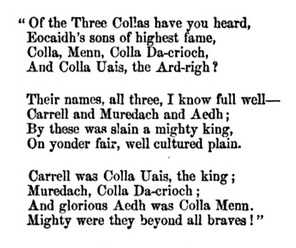
Quotation from an ancient bard in The History of Ireland written c. 1634 by Geoffrey Keating (1569-1644). Translated into English from the original Irish by John O'Mahony, 1857. |
Origin of The Three Collas. R-Z3000 is a Y-DNA mutation born circa 100 AD in Colchester, England, or Wales. Z3000 has two main branches:
- Z16270 born circa 150 AD in England, which is the Y-DNA of distant cousins of The Three Collas.
- Z3008 born circa 450 AD in England and found in The Three Collas who migrated to Ulster in Ireland.
The three brothers were named in the Roman convention in England. They were invited to Ireland by the Ui Neills. They are not descended from Ui Neills. See Origin of The Three Collas.
Two Ancient Genealogies. Several Z3008 testers have connected their genealogies with ancient genealogies of The Three Collas.
- 7 McDonald testers trace their ancestry back to Somerled and Colla Uais.
- 2 McMahon testers trace their ancestry back to Colla da Crioch
The two genealogies go back to separate Colla brothers. The most recent shared SNP of testers with the two separate genealogies is Z3008. This lends credence to the argument that Z3008 is the SNP of The Three Collas. See: Two Ancient Genealogies.
Matching Sets of 20 Names. In October 2020, the same 20 surnames were found among certain DNA testers and certain ancient genealogies:
- 20 surnames of 232 out of 466 testers with Z3008 Y-DNA, and
- 20 surnames among the many mentioned in ancient genealogies of The Three Collas.
The number of testers by surname were: 53 McDonald, 43 McMahon, 23 McKenna, 17 Connolly, 17 Duffy, 12 McGuire, 8 Monaghan, 8 Hughes, 8 McQuillan, 7 Boylan, 5 Hart, 5 Kelly, 4 MacDougall, 4 Higgins, 4 McArdle, 3 Cooley, 3 Neal, 3 Larkin, 3 Carroll, 2 Devine. See: Matching Sets of 20 Names.
Abridged Z3000 Big Y SNP Tree
| R-Z3000 100 AD England |
| Z16270 150 AD England |
Z3006 300 AD England |
| FT3715 300 AD England |
McGuire
Carroll 1
McClain
Casey
Judd
Almond
Morris |
Z3008 450 AD England Origin of The Three Collas |
BY3160
500 AD
England
Smith 2 |
BY513
600 AD
Ireland
Larkin 15b
Paden
O'Guin
|
Z21270
350 AD
England
Roberts
Adams
Roderick |
FTB44172
350 AD
England
Calkins
Godwin
McNaughton
Galbraith |
BY3163
500 AD
Ulster
McGinnis
Cooley
McKenna
Neal
McGroder
McDonald 4 |
S953
500 AD
Ulster
Østerud
Connolly
Boylan
Beggan
McAuley
O'Hara
Larkin 15a
McGuire
*McDonald 1
McDonald 2
Reilly
King
Martin |
F4142
500 AD
Ulster
McDougall
White |
A14079
650 AD
Ulster
Hart
Monaghan
Higgins
Collins
Glennon |
FT14355
600 AD
Ulster
Kelly
Murphy
Clarke
McArdle
Hughes 1
**McMahon 1
Callen
Hughes 2
Carroll 2
McQuillan
Duffy
McDonald 3
Devine
Murray
Waters |
BY116772
950 AD
Ulster
McMahon 2 |
| cousins |
cousins |
cousins |
cousins |
Crioch |
Uais |
Uais |
Crioch |
Crioch |
Crioch |
cousins |
| 070 |
105 |
131 |
144 |
159 |
225 |
335 |
350 |
383 |
520 |
545 |
Unabridged tree: The complete tree is at: Clan Colla Big Y SNP Tree
SNPs: SNPs are single nucleotide polymorphisms, or mutations, found on the Y chromosome and shared by a group of male Big Y testers. Major SNPs are shown in the top part of the table. The roughly-estimated year in which a SNP was born is shown in parentheses. Click on a SNP to see detail on Fanily Tree DNA Discover.
Collas: The Three Collas emigrated from England to Ulster in the 4th century. Descendants of Colla Uais and Colla da Crioch are those with the SNP Z3008.
Cousins: Without SNP Z3008. Cousins of The Three Collas.
Last row: Sequence on the FTDNA public results page for the Clan Colla project. |
Surnames: Surnames with three or more testers are listed under the SNPs. Surnames in bold are said in ancient pedigrees to be descended from The Three Collas. See: Colla Surnames and Matching Sets of 20 Names. Many surnames in the ancient pedigrees are not here because they have not been tested, died out, or were included in a pedigree in error. The two most populous names are McDonald and McMahon.
*McDonald 1 includes 7 McDonalds who trace their ancestry back to Somerled and Colla Uais in 43 Generations: Colla to McDonald.
**McMahon 1 includes 2 McMahons who trace their ancestry back to Colla da Crioch in 50 Generations: Colla to McMahon. |
|
Introduction
|
Data
|
Discussion
|
|
Background, 1998-2022
Clogher Historical Society, 1998. In 1998, The Three Collas were identified as Romanized Britons by Donald M. Schlegel. His findings were includeded in an article entitled "The Origin of The Three Collas and the Fall of Emain," which was published in the 1998 Clogher Record, Volume XVI, Number 2, pages 159-181. Schlegel lives in Ohio. The Clogher Record is published by the Clogher Historical Society at St Macartan's College in Mullaghmurphy, County Monaghan, Ireland.
Roman Naming of The Three Collas
Praenomen
(personal) |
Nomen
(family) | Cognomen
(descriptive or epithet) |
|---|
| Carrell | Colla | Uais "the noble" |
| Muredach | Colla | da Crioch "of the two lands" or
focrach "mercenary" |
| Aedh | Colla | Menn "the famous" |
|
In 1998, Donald Schlegel proposed An Alternate Explanation of the Origin of The Three Collas. He starts by saying that the Collas are perhaps the only instance in prehistoric or early historic Ireland of three brothers having each a personal name, a name in common, and an epithet. The implication is that such a naming convention must have been imported, and the obvious source is the Roman Empire. He suggests they were not descended from Irish Kings but instead were Romanized Britons, originating in the Celtic tribe named Trinovantes from nearby Colchester in southeastern England, where the Romans estabilshed their first colony. They received military training from the Romans and eventually went to Ireland as mercenaries in the service of the King of Ireland. Donald presented this theory in the 1998 Clogher Record. It is one of the many articles he has had published in the Clogher Record, a local history journal published annually since 1953 by the Clogher Historical Society at St. Macartan's College in the townland of Mullaghmurphy on the outskirts of the town of Monaghan, County Monaghan.
See The Clogher Record, "The Origin of The Three Collas and the Fall of Emain," by Donald M. Schlegel, Volume XVI, No. 2, 1998, pp. 159-181. Also see The Clogher Record, "Reweaving the Tapestry of Ancient Ulster," by Donald M. Schlegel, Volume XVII, No. 3, 2002, pp. 689-749.
The first part of this alternative explanation is consistent with DNA results. Traditionally, The Three Collas were considered to be descended from the same ancestors as Niall of the Nine Hostages. DNA testing of present-day descendants of the Niall and the Collas, however, indicates that they were not related.
- Descendants of The Three Collas have a unique DNA, Z3008
- Descendants of Niall of the Nine Hostages have a very different DNA, M222
- Their common ancestry goes back to L21, which was born in 2650 BC.
So, it seems pretty clear that The Three Collas were not cousins of Muredach Tirech, 122nd King of Ireland and grandfather of Niall of the Nine Hostages. See Modal DNA of Clan Colla Versus Niall of the Nine Hostages.
The second part of this alternative explanation has not been verified yet by DNA. We have not found a family that matches Clan Colla DNA and traces itself back to the area around Colchester. Nothing is known of the Trinovantes as a tribe with certainty after the rebellion of Boudicca about 60 AD, so it is not possible to trace any family back to them using DNA analysis.
There are, however, two families who descend from cousins of The Three Collas and trace themselves back to towns that had Roman settlements in Wales near the border with England. These towns are near the Roman legionary fortresses of Caerleon and Chester, the two fortresses by which the Romans controlled Wales.
- The Roderick family traces itself back to southern Wales near Caerleon, where a legionary fortress existed until about 280 AD.
- The Calkins family traces itself back to Chester, England, on the northern border with Wales, where a legionary fortress existed until around 400 AD.
These and other families with DNA similar to the descendants of The Three Collas could be descendants of kinsmen of The Three Collas who remained near the military posts when the Collas or their immediate ancestors moved on, from Caerleon to Chester and then to Ireland. (Family names mean nothing in this context, because they were not adopted until after 1000 AD)
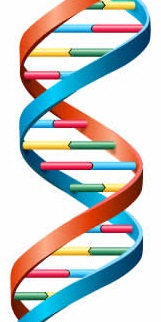 Fanily Tree DNA. In 1999, Bennett Greenspan had entered semi-retirement and was working on his family history. He contacted Dr. Michael Hammer at the University of Arizona. Greenspan discovered that academic labs did not offer testing directly to the public and that in general direct to consumer testing for genealogy was not commercially available either. Their conversation inspired him to start a company dedicated to using genetics to help solve genealogy mysteries in early 2000 called Family Tree DNA.
Fanily Tree DNA. In 1999, Bennett Greenspan had entered semi-retirement and was working on his family history. He contacted Dr. Michael Hammer at the University of Arizona. Greenspan discovered that academic labs did not offer testing directly to the public and that in general direct to consumer testing for genealogy was not commercially available either. Their conversation inspired him to start a company dedicated to using genetics to help solve genealogy mysteries in early 2000 called Family Tree DNA.
In 2003, the first persons with Colla DNA were tested by FTDNA:
Thomas McKenna, kit #6419; Dewey Neal, kit #7206; William Neal, kit #7207; William Hughes, kit #7996; Thomas Roderick, kit #8551.
McMahon Genealogy. In July 2008, Patrick McMahon of
Gorey, Co. Wexford, Ireland, and his brother Eugene McMahon of Dundas, Ontario, Canada, published a 172-page genealogy entitled The McMahons of Trohanny. It takes their McMahon ancestry back to the 1600s and discussed the early History of the McMahons in Fermanagh and Monaghan. Patrick had his DNA tested at FTDNA in 2009 and became an administrator of the Clan Colla Project. Patrick spent his career working as a geneticist/operational analyst for the British Ministry of Defence. He has an advanced degree in genetics from Trinity College Dublin. He and his brother Eugene have traced their family back to Faolan MacMathghamhna (Felim/Phelan MacMahon), who lived in County Monaghan in the early 12th century (see 50 Generations: Colla to McMahon). Patrick also has done an in-depth analysis of the Origin of The Three Collas. Patrick grew up in Hampstead Park, Glasnevin, Dublin, and now lives in Gorey, Ireland.
An Unusual Test Result. In July 2008, Daniela Moneta started a Biggins DNA project at Family Tree DNA. She found Peter Biggins through this website and asked him to join the project. With some skepticism, he had his Y-chromosone DNA tested for 67 markers. Results showed that he was of Atlantic European ancestry and matched up well with people named Biggins or Beggan. That was interesting but expected. Results also showed a good match with people named McGuire, Carroll, McDonald, McKenna, and McMahon. Furthermore, they all had an unusual null value for STR marker 425. He described the results on his Web page: Biggins/Beggan Irish Roots.
His Web page related a conversation he had with Gerard Beggan, whom he had met in September 2007 in Carrickmacross, County Monaghan. Gerard told him that in 1969 Rev. Peadar Livingstone (1932-1987) told him that Beggan was a branch of the Maguire family. Peter had found Gerard's name on the Web site of Al Beagan. Father Livingstone was a renowned scholar in both the Irish language and local history. He wrote comprehensive histories of two counties in Ireland, The Fermanagh Story in 1969, and The Monaghan Story in 1980.
An Email from Josiah McGuire. In March 2009, Peter received an email from Josiah McGuire. Josiah was getting reports that he was matching up with Peter and found his Web page. Josiah said, "I think it is really quite amazing and very interesting that Peadar Livingstone thought the Beggans had their origins from the Maguires, and here, of all things, are some fairly close matches that may confirm this."
Josiah's email went on: "I have been watching and studying the 425 nulls between the Carrolls, McMahons, McKennas, and McGuires since I had my markers upgraded to 67 markers in 2006. I suspected that we probably shared a common ancestor, but very few researchers took my comments very seriously. These surnames and several others who I also have matches with are said to descend from "Colla da Chrioch" as stated in the Irish Pedigrees by O'Hart." In 2007 Josiah computed modal values for the DNA of The Three Collas.
In June 2009, Josiah started the Clan Colla Null 425 Project at FTDNA to attract Clan Colla descendants, encourage upgrades to the 67-marker test, and promote Clan Colla research. Peter agreed to be a co-administrator and was the first one to join the new Clan Colla project.
Participation in the Biggins DNA project has turned out to be worth far more than Peter had anticipated. It confirms that the names Biggins, Beaghen, Beggan, and Little are based on the Irish word for small, beag, as mentioned in Irish surname books by Patrick Woulfe (1923) and Edward MacLysaght (1969). And it confirms what Professor Peadar Livingstone had told Gerard Beggan in the 1970s--that Beggans are related to Maguires. But most importantly, the DNA project established a connection with ancient Irish history. Beggans were no longer just a humble people with a name based on the Irish word for little. With big names like Carroll, McMahon, McKenna, and Maguire, Beggans were descended from The Three Collas who lived in the 4th century and established the ancient kingdom of Oriel in Monaghan and Fermanagh.
McDonald 1 Genealogy. In November 2008, genealogist Vaden McDonald tested the DNA of Frank Everett McDonald, kit #133546, who was known to be descended from Lt. Brian McDonald, Somerled, and The Three Collas. Vaden was hoping his DNA matched Frank, but found out it did not. In 2010, Vaden joined Frank to the Clan Colla project and reported that Frank "lives in Salem, VA and is considered to belong to the Lt. Brian McDonald Line. He went on to say that his "research on the Lt Brian McDonald line showed he was a descendant of Alastiar Og McDonald, 5th Lord of the Isles. His sons were exiled to Ireland after the Battle of Bannockburn by Robert the Bruce in 1095."
Following Vaden McDonald, Elbert Leo "Mick" McDaniel III, a member of our McDonald 1 subgroup, has found five other McDonald testers who tie in to the tree of Lt. Brian McDonald. Paul Duffy has provided valuable information on the McDonalds of Antrim and Leinster. Donald Schlegel has been most helpful in connecting the Frank Everett McDonald's genealogy with Colla Uais.
Corroborating Evidence. While Josiah was researching Clan Colla DNA, others were independently coming to the same conclusions.
In February 2008, Kevin Carroll, administator of the Carroll DNA Project, posted this news: "We think that a group of our participants may have hit the Jackpot! They may be related to the O'Carroll Princes of Oriel (Monaghan and Louth). This Kingdom located in the North of Ireland was founded by the three Colla brothers around the year 327 AD. Wow! Will keep you posted on this as we get more news."
In December 2008, the McQuillan Clan Association announced "DNA Project Sheds New Light
on McQuillan Connections." Specifically, they said that "our first "cluster" shows recent shared ancestry for Monaghan & Fermanagh McQuillans. The close match between these three McQuillans reveals the first localized McQuillan haplotype cluster to emerge in our study. This cluster also shows a relationship with some Cullens, and perhaps with the McMahons of Monaghan."
In August 2009, Joseph A. Donohoe V (1941-2011) reported on the DNA of descendants of The Three Collas in his Breifne Clans DNA Reports BCP Report 5, Part 7 and BCP Report 5, Part 8. He independently identified the Clan Colla group that was identified by the Clan Colla project started by Josiah McGuire in June 2009. He called it Airghialla 1 because he was not sure it was Clan Colla. He said he was "not fully persuaded yet of the validity or applicability of the Colla tradition, particularly in view of the great number of traditionally Colla surnames not represented here." As part of his study, Joseph established a modal DNA for Airghialla 1 called WHYAA. It is the same as the DURRQ modal used here, which was established by Josiah McGuire in December 2007. To test the validity of Airghialla 1, Joseph came up with a second group called Airghialla 2. As part of his study, Joseph established a modal DNA for Airghialla 2 called 9U5BW. In comparing Airghialla 1 and 2 on page 184 of the report, Joseph says that Airghialla 1 "appears
to have been prominent in the South Tyrone – North Monaghan area from the
sixth century, if not earlier," while Airghialla 2 "rose to historical prominence later . . . in the ninth century." He concludes that Airghialla 1 "would appear to be the best candidate" to represent the DNA of The Three Collas. Joseph himself is not Airghialla 1 or 2. He is a descendant of Niall of the Nine Hostages, also called R-M222 or Northwest Irish.
DNA has confirmed ancient Irish history, but it has also shown that the history is wrong in some areas.
- The Three Collas were said to be related to Niall of the Nine Hostages. The DNA of the descendants of the Collas (R-Z3008), however, does not match the DNA of the descendants of Niall (R-M222).
- John Hart of New Jersey, signer of the Declaration of Indepence, was not descended from ther Three Collas. John O'Hart's 1892 Irish Pedigrees includes the O'Hart pedigree back to The Three Collas. In a footnote on page 678 of Volume II, John O'Hart states that "After the Cromwellian Confiscation in Ireland some of the family migrated to America; and John Hart, one of their descendants, was one of the Signatories to the Declaration of American Independnce, on the 4th July, 1776." The Y-DNA of John Hart the Signer can be found in: The Y-DNA Genetic Signature of an American Founding Father – John Hart the Signer, by Dr. Jeffrey Mark Paull and Susan K. Steeble. The Y-DNA for several descandents of the the Signer is L21>DF13>Z39589>BY55538>BY54949. See: Hart project at FTDNA. Clan Colla is L21>DF13>DF21>Z3000>Z3006>Z3008. There are Harts with Clan Colla DNA, but they do not claim to be descended from John Hart the Signer.
- Hy Maine and Clan Colla had previously been thought by some to be descended from a common ancestor, but they have different SNPs and there is a genetic distance of 17 between their modals. There are Kellys with Clan Colla DNA, but they are likely from another Kelly pedigree called Clankelly. Hy Maine has the FGC6545 SNP, also known as FGC6550.
- One of the largest and earliest FTDNA projects is Clan Donald. They had an interest in Clan Colla from the start because most McDonalds were thought to be part of Clan Colla. In February 2004, the Clan Donald project issued a press release saying they had identified an R1b group as Clan Colla. This group is now generally known as the Scottish Cluster rather than Clan Colla and is identified as R-L21>L1335>L1065.
- In March 2004, the Clan Donald project announced that an R1a Viking DNA identified Macdonalds of Clanranald, Glengarry, Dunnyveg and the Glens, Kepoch, and Sleat. The R1a DNA that includes these Clan Chiefs is now generally accepted and is known as YP326>FGC11896. See The Clan Donald.
FTDNA Conference. Thomas Roderick, 1930-2013, one of the original contributors to this webpage and one of the original members of the International Human Genome Organization in 1988, helped us get our story across at the 2011 FTDNA Conference in Houston, Texas:
The Clan Colla Null 425 Project stems from the discovery that in haplogroup R-L21 there is a single subset carrying a null at DYS 425 and probably unique or nearly unique values at 2 or 3 other loci. What is important is that this haplotype clearly is associated with only one grouping of Irish clans and surnames, each of which by historical records emanates from The Three Collas, a successful aggressive clan flourishing 300-400 AD. We are looking for evidence that this null is associated with other families with different ancestry and as yet have not definitively found it. This gives us an estimate of the time of the mutation to the null a little before 300 AD.
From the other markers, we find (using 67 Y markers) the genetic distances among the Colla Group and Colla Modal DNA range between 1 and 11, and have an average of 6. Of the 232 people, 218 or 94% of the group have a genetic distance of 3 to 9.
These data are consistent with our estimate of the timing of the null mutation.
One great advantage of this grouping is that it is well defined molecularly, therefore confined, small enough and yet old enough to make genealogical sense coordinating molecular and historical evidence. By more detailed analysis we can get better understanding of specific genealogical relationships among clusters of the several clans and many surnames.
Big Y SNP Tree. In November 2013, FTDNA introduced Big Y, which tested a large portion of the Y chromosome. Clan Colla project members began receiving test results in November.
In April 2014, Alex Williamson started his Big Tree, which included Clan Colla. We started our Clan Colla BIG Y SNP Tree based on his tree. In 2019, FTDNA started it Big Y SNP Tree.
In 2018, Big Y was replaced by Big Y-500, a combination of Big Y, Y-111, and 389 STRs from Big Y data. In 2019, FTDNA replaced Big Y-500 with Big Y-700, which provides more uniform coverage within a much broader and targeted region of the Y and an increased number of STR markers.
In 2018, Patrick McMahon, a geneticist and an administrator of the Clan Colla DNA Project, concluded that the SNP Z3008 was the DNA of tThe Three Collas and that those with Z16270 DNA were "cousins" of The Three Collas. He sent an email to all Project members reviewing the origin of and establishment of The Three Collas. Patrick put the review together with his brother Eugene, who is a historian. They cited historian Donald Schlegel, who had provided valuable information on the history of The Three Collas in "The Origin of the Three Collas and the Fall of Emain," Clogher Record, 1998.
In 2022, FTDNA started Discover, which includes an estimated date for every SNP using an aging method developed with Iain McDonald.
|
Timeline
Below is a timeline for Clan Colla DNA and ancient pedigrees. The timeline focuses on two the most well-known of our Colla subgroups: McDonald 1 and McMahon 1. For each we have testers who can trace their ancestry back to a Colla. Dates for SNPs are rough estimates.
| Year | Colla Uais and McDonald 1
| Colla da Crioch and McMahon 1 |
|---|
| BC 20000 | R-M173 SNP occurs in Eastern Kazakhstan. Ancestor of Celts, Saxons, and Vikings.
Viking descendants include Angus Og and family, grafted on to the Colla Uais tree in 1308 AD and called Clan Donald. See: Grafting of Clan Donald |
| BC 4450 | R-M269 SNP occurs in Southern Russia
Predicted by Y-12 test |
| BC 3050 | R-L151 SNP occurs in Ukraine. Ancestor of Celts and Saxons |
| BC 2900 | R-P312 SNP occurs in Ukraine. Ancestor of Celts |
| BC 2650 | R-L21 SNP occurs in a Celt in southern England |
| BC 2350 | DF21 SNP occurs in a man with L21 DNA in England. |
| BC 2150 | Z16267 SNP occurs in a man with DF21 DNA in England |
| BC 2150 | F24434 SNP occurs in a man with Z16267 DNA in England.
27 SNPs occur in a line of male descendants of a man in England with F24434 DNA, with no known branches for 2000 years
Four unique STRs occur at unknown times during the 2000 years: 47th STR 511=9, 48th STR 425=0, 76th STR 505=9, 91st STR 441=12 |
| AD 43 | Britain becomes a province of the Roman Empire.
The first capital of the province is the colonia of Colchester, which is on the River Colne, originally known as Colonia Fluvius ("waterway of the Colonia").
England remains a Roman province until AD 410. |
| AD 100 | Z3000 SNP occurs in a man in England with F24434 DNA
Descendants include Clan Colla and distant cousins named Larkin 15b,
Paden,
O'Guin,
Roberts,
Adams,
Roderick,
Calkins,
Godwin,
McNaughton,
Galbraith,
McGuire,
Carroll 1,
McClain,
Judd,
Almond,
Morris |
| AD 300 | Z3006 SNP occurs in a man in England with Z3000 DNA
Descendants include Clan Colla and distant cousins named Smith |
| AD 450 | Z3008 SNP occurs in a man in Wales or Colchester with Z3006 DNA
Includes Clan Colla descendants named McGinnis,
Cooley,
McKenna,
Neal,
McGroder,
McDonald 4,
Østerud,
Connolly,
Boylan,
Beggan,
McAuley,
O'Hara,
Larkin 15a,
McGuire,
McDonald 1,
McDonald 2,
Reilly,
King,
Martin,
MacDougall,
White,
Hart,
Monaghan,
Higgins,
Collins,
Glennon,
Kelly,
Murphy,
Clarke,
McArdle,
Hughes 1,
McMahon 1,
Callen,
Hughes 2,
Carroll 2,
McQuillan,
Duffy,
McDonald 3,
Devine,
Murray,
Waters,
McMahon 2
Note: The birth year of a SNP is a rough estimate. It is calculated based on SNP and STR test results from many present-day DNA testers. Uncertainties in the molecular clock and other factors affect this calculation. And it is rounded to a multiple of 50. Scientific Details for Z3008 show an estimated mean of 450 AD for the birth year and a 95% chance that it falls between 200 and 700 AD. |
| AD 392 | Three brothers named Colla with the Z3008 SNP, from Roman-controlled England,
migrate to Ulster and become known for their prowess in warfare
"In the misty days before Christianity and the art of writing were brought to Ireland by St. Patrick and other missionaries and refugees, there lived three mighty warriors called na tri Colla, the three Collas. The story of the three Collas survived in oral tradition and was written down centuries after their own time." - Donald M. Schlegel, "The Origin of the Three Collas and the Fall of Emain," Clogher Record, Vol. XVI, No. 2, 1998, p. 199 |
| AD 432 | St. Patrick arrives in Ireland to convert the Irish to Christianity. |
| AD 500 | S953 SNP occurs in a descendant of Colla Uais. probably Carthend. He migrates to what is now County Derry and lives on the River Faughan in what later became known as the Barony of Tirkeeran.
The name Tirkeerin comes from the Irish Tír Mhic Caoirthinn, which means land of Carthend
S953 includes Clan Colla descendants named
Østerud,
Connolly,
Boylan,
Beggan,
McAuley,
O'Hara,
Larkin 15a,
McGuire,
McDonald 1,
McDonald 2,
Reilly,
King,
Martin | |
| AD 600 | ZZ13 SNP occurs in a descendant of Colla Uais
Includes Clan Colla descendants named
Boylan,
Beggan,
McAuley,
O'Hara,
Larkin 15a,
McGuire,
McDonald 1,
McDonald 2,
Reilly,
King,
Martin
A descendant of Colla
Uais migrates to the Scottish Highlands |
FT14355 SNP occurs in a descendant of Colla da Crioch
Includes Clan Colla descendants named
Kelly,
Murphy,
Clarke,
McArdle,
Hughes 1,
McMahon 1,
Callen,
Hughes 2,
Carroll 2,
McQuillan,
Duffy,
McDonald 3,
Devine,
Murray,
Waters |
| AD 700 | | Z16274 SNP occurs in a descendant of Colla da Crioch
Includes Clan Colla descendants named
Kelly,
Murphy,
Clarke,
McArdle,
Hughes 1,
McMahon 1,
Callen,
Hughes 2,
Carroll 2,
McQuillan |
| AD 750 | FT14481 SNP occurs in a descendant of Colla Uais
Includes Clan Colla descendants named
Beggan,
McAuley,
O'Hara,
Larkin 15a,
McGuire,
McDonald 1,
McDonald 2,
Reilly,
King,
Martin | Z16276 SNP occurs in a descendant of Colla da Crioch
Includes Clan Colla descendants named
Murphy,
Clarke,
McArdle,
Hughes 1,
McMahon 1,
Callen,
Hughes 2,
Carroll 2,
McQuillan |
| AD 800 | A938 SNP occurs in a descendant of Colla Uais
Includes Clan Colla descendants named
McDonald 1,
McDonald 2,
Reilly,
King,
Martin | Z16278 SNP occurs in a descendant of Colla da Crioch
Includes Clan Colla descendants named
Murphy,
Clarke,
McArdle,
Hughes 1,
McMahon 1,
Callen,
Hughes 2,
Carroll 2
|
| AD 853 | Goffrad: descendant of Colla Uais, dies. He had been left by Kenneth MacAlpin in the west to try to hold the Isles against the Vikings. He was styled toiseach (prince) of Innse-Gall (all of the Hebrides) | |
| AD 900 | FT112238 SNP occurs in a descendant of Colla Uais
Includes Clan Colla descendants named
McDonald 1,
McDonald 2,
Reilly
| BY20667 SNP occurs in a descendant of Colla da Crioch
Includes Clan Colla descendants named
McArdle,
Hughes 1,
McMahon 1,
Callen,
Hughes 2,
Carroll 2 |
| AD 1000 | | Z16277 SNP occurs in a descendant of Colla da Crioch
Includes Clan Colla descendants named
McArdle,
Hughes 1,
McMahon 1,
Callen,
Hughes 2,
Carroll 2 |
| 11th century | Surnames first adopted in Ireland |
| 12th century | Somerled (1113-1164), descendant of Colla Uais and ancestor of Clan Donald of Leinster and Ulster, becomes the leader of Argyll and the Isles on the west coast of Scotland | Faolan MacMathghamhna (Felim/Phelan MacMahon), a descendant of Colla Da Crioch, early 12th century |
| 1150 | | Z16275 SNP occurs in a descendant of Colla da Crioch
Includes Clan Colla descendants named
McArdle,
Hughes 1,
McMahon 1,
Callen |
| 1200 | | A77 SNP occurs in a descendant of Colla da Crioch
Includes Clan Colla descendants named
McMahon 1 |
| 1308 | Alasdair Og, Lord of the Isles, deposed by his "brother" Angus Og.
Alasdair Og descendants include McDonald testers with Colla Uais DNA
Angus Og descendants are called Clan Donald but DNA testing shows them to be Vikings rather than Collas (The Clan Donald) | |
| 1350 | | Z16280 SNP occurs in a descendant of Colla da Crioch
Includes Clan Colla descendants named
McMahon 1 |
| 1372 | | Briain Mor (Big Brian) dies; the first McMahon to officially claim the title of Ardri Oirghialla (High-King of Oriel) |
| 1390 | Clan Colla described in Book of Ballymote |
| 1427 | | Ardghal McMahon dies in Monaghhan; he is probably the ancestor of all in the McMahon 1 subgroup |
| 1435 | Charles Thurlough Mor McDonald dies: born in Antrim; acquired lands being known as the Clan Donnell Country, including Tynekill Castle at the base of the boundary of the mountains of Leix and Wicklow | |
| 1607 to 1609 | Plantation of Ulster |
| 1632 to 1636 | Clan Colla described in Annals of the Four Masters, Michael O'Clery (1580-1643) at al., 1632 to 1636, translated from Irish in 1845 by Owen Connellan.
The posterity of the three Collas, called Clan Colla, founded many powerful clans and noble families in Ulster and other parts of Ireland. |
| 1634 | Clan Colla described in Section XLVII of The History of Ireland, by Geoffrey Keating. Translated from Irish in 1902 by David Comyn and Patrick S. Dinneen |
| 1641 | | Rory Og McMahon fought in the Irish Rebellion of 1641; died in 1650 |
| 1652 | Cromwellian Settlement |
| 1688 | King James II of England, Ireland, and Scotland deposed |
| 1689 | Lieutenant Brian McDonald, who served in an Irish Volunteer Regiment in the cause of King James II, emigrates from County Wicklow, Ireland, to Mill Creek Hundred, New Castle County, Delaware | |
| 1700 | BY3158 SNP occurs in Lieutenant Brian McDonald, ancestor of 7 McDonald testers
| |
| 1750 | A14093 SNP occurs in Bryan II McDonald, 1686-1757, ancestor of five McDonald testers
| BY115195 SNP occurs in Conn MacMahon of Killshanlish, died in 1663, ancestor of two McMahon testers |
| 1876 to 1892 | Clan Colla described by John O'Hart (1824–1902) in five editions of Irish Pedigrees |
| 1905 | Y chromosome discovered by Nettie Stevens at Bryn Mawr College |
| 1953 | Watson and Crick published a paper on the double helix structure of DNA |
| 1969 | Peadar Livingstone writes The Fermanagh Story including a map with surnames based on then present-day counts. Names of Z3000 testers that appear on map: Beggan, Carey, Connolly, Devine, Hanratty, Kelly, McDonnell, Maguire, McCawley, McKenna, Monaghan, Murphy, Owens, Reilly. |
| 1979 | Peadar Livingstone writes The Monaghan Story including a map with surnames based on then present-day counts. Names of Z3000 testers that appear on map: Beggan, Boylan, Callan, Carroll, Clerken, Connolly, Duffy, Hanratty, Hughes, Kelly, Maguire, McGinn, McKenna, McMahon, Murphy, Murray, Waters. |
| 1988 | Thomas Roderick (1930-2013) becomes one of the founding members of the international Human Genome Organization.
He had his DNA tested by FTDNA in 2005 (kit #8551) and later became an administrator of the Clan Colla project |
| 1998 | The Three Collas identified as Romanized Britons by Donald M. Schlegel in "The Origin of The Three Collas and the Fall of Emain," Clogher Record, Vol. XVI, No. 2, 1998, pp. 159-181 |
| 2000 | In May, Family Tree DNA founded by Bennett Greenspan. Starts offering 12 STR markers |
| 2002 | In July, FTDNA starts offering 25 STR markers |
| 2003 | The first persons with Colla DNA are tested by FTDNA (25 STR markers):
Thomas McKenna, kit #6419;
Dewey Neal, kit #7206;
William Neal, kit #7207;
William Hughes, kit #7996;
Thomas Roderick, kit #8551 |
| 2003 | In August, Human Genome Project completes first sequencing of the human genome |
| 2003 | In December, FTDNA starts offering 37 STR markers |
| 2006 | In August, FTDNA starts offering 67 STR markers. Two STRs are unique for Clan Colla: 511=9 and 425=0 |
| 2006 | Josiah McGuire, kit #23171, begins to see matches with Carrolls, McMahons, McKennas, and other surnames descended from The Three Collas |
| 2007 | Josiah McGuire computes modal values for the DNA of The Three Collas and puts it on Ysearch with the user ID of DURRQ |
| 2008 | R-L21 SNP discovered |
| 2009 | Josiah McGuire, kit #23171, starts the Clan Colla DNA project at Family Tree DNA
Peter Biggins joins the project and starts this web page. |
| 2009 | Joseph A. Donohoe concludes that his Airghialla 1 are The Three Collas rather than his Airghialla 2. See Two McGuire Septs |
| 2009 | Patrick McMahon and Peter Biggins have lunch at Trinity College Dublin with Katherine Simms, Senior Lecturer in Medieval History, to discuss the Three Collas |
| 2011 | R-DF21 SNP discovered |
| 2010 | Walk the Y begins, testing a large number of SNPs |
| 2011 | In April, FTDNA starts offering 111 STR markers. Two STRs are unique for Clan Colla: 505=9 and 441=12 |
| 2011 | Presentation on Clan Colla DNA included in the FTDNA Conference in Houston. Findings. prepared by geneticist Tom Roderick, are:
1. The growing Clan Colla data is showing that the cluster is
representative of a unique stable population within the R-DF21+
population.
2. The DNA picture that has emerged is consistent with the perceived
historical knowledge pertaining to Oriel in the early part of the first
millennium.
3. The data also supports the view that Clan Colla originated in a Celtic
tribe in NW Britain before migrating to Oriel.
4. Y-chromosome DNA has verified an ancient Irish pedigree for
historians, and genetic genealogists. |
| 2013 | Clan Colla R-Z3000 SNP discovered and named by non-Colla Mike Walsh. It is downstream of R-L21 and DF21 |
| 2013 | A study in April of haplogroups with Colla surnames found no other haplogroup that had near the variety of Colla surnames that Z3000 has |
| 2013 | A study in June of STRs predicting the Colla Z3000 SNP found that all in the Colla group had at least 3 of 4 key STRs. The "other DF21" had one at best.
Key STRs: 47th STR 511=9, 48th STR 425=0, 76th STR 505=9, 91st STR 441=12. |
| 2014 | FTDNA introduces by Big Y. New SNPs have a BY prefix |
| 2014 | In April, Alex Williamson starts his Big Tree, which includes Clan Colla Big Y testers and uses an aging method developed by Iain McDonald |
| 2014 | In June, we start our Clan Colla BIG Y SNP Tree based on Alex Williamson's Big Tree |
| 2014 | In June, a Clan Colla Big Y tester contributes $1,500 to the Clan Colla General Fund to encourage Big Y testing |
| 2018 | In April, Big Y-500 test introduced by FTDNA |
| 2018 | In May, geneticist Patrick McMahon identifies R-Z3008 as the DNA of The Three Collas in Origin of The Three Collas. He concludes:
1. In or around the beginning of the first millennium, the Z3000 mutation occurred in the DF21 population, probability in Continental Europe. This and subsequent nested SNP mutations define the Z3000 sub-populations.
2. About 300 years later, three brothers who were named in the Roman convention as Cairell Colla Uais, Muredach Colla fo Crich, Aed Colla Mend, were identified historically as fighting the Ulaidh in Oriel, mid 4th c. Historically known descendants of the Collas (Carroll, McMahon, McKenna etc) are in the Z3008 clade along with others and can be referred to as Collas.
3. Also in the Z3000 clade, with very similar genetic profiles, are people with totally different names and geographic locations outside Ireland. These are in and descend from the Z16270 clade (a sub-clade of Z3000). These should not be referred to as Collas but rather as belonging to Z16270 or its nested sub-clades.
4. In the absence of any documented large scale Roman incursion into Ulster, it can only be concluded that the Colla force was in Oriel by invitation of the overwhelming Ui Neills and acted as a blocking force against the Ulaidh. As a small (though successful opportunistic raiding party), they would hardly have been tolerated by Ui Neill unless they offered something beneficial. This was in all probability a military disciplined extended fighting family (common among Roman military) with the latest Roman weaponry and tactics.
5. Such a small disciplined force would wreak havoc among the largely untrained rural dwellers allowing them to capture crannog after crannog. Whatever the details, the Collas were able to acquire enough territory to sustain and grow their population over the next few generations.
6. Ultimately, with increasing population sizes, pitched battles were fought by the Collas and others (Airgialla) finally defeating the Cruithni at Eamhain Macha. Much of the territory formally held by the Cruithni then passed to the Collas. |
| 2019 | In January, the Big Y-700 test is introduced by FTDNA, replacing Big Y-500.
FTDNA also introduces a Big Y Block Tree layout based on Alex Williamson's Big Tree |
| 2019 | In February, molecular biologist Cathal McElgunn discusses Clan Colla history, surnames, and the Z3008 SNP in Fermanagh-Monaghan Transborder DNA & History, at "Genetic Genealogy Ireland" in Belfast |
| 2020 | In October, 232 out of 466 testers with Z3008 were found to have 20 surnames mentioned in ancient genealogies of The Three Collas. See Matching Sets of 20 Names |
| 2022 | In December, FTDNA begins estimating the ages of SNPs using an aging method developed with astrophysicist Iain McDonald |
| 2023 | In December, new FTDNA Family Finder results for males begin showing several Colla SNPs: Z3000, Z3008, S953, and Z16275. |
| 2024 | In August, there are 805 Clan Colla project members and 456 Z3000 Big Y testers |
|
Origin of The Three Collas
On May 17, 2018, Patrick McMahon, Administrator of the Clan Colla 425 null Project, sent an email to all Project members reviewing the origin of and establishment of The Three Collas. Patrick, a geneticist, put the review together with his brother Eugene, who is a historian. Patrick and Eugene have traced their family back to Faolan MacMathghamhna (Felim/Phelan MacMahon), who lived in County Monaghan in the early 12th century (see 50 Generations: Colla to McMahon). The review was based on "the Colla genetic position and the few pre-history snippets of information that are available."
Several people commented on the review. Their comments follow the review.
Patrick McMahon Email of May 17, 2018
The contention that the Collas are “descended from the sons of Eochaid Doimlen, younger son of Cairbre Lifechair, High King of Ireland in the 3rd century A.D" has been the position taken by people involved in the genealogy of the Collas over the last few years. This interpretation is incorrect both on genetic and historical evidence and should be abandoned.
The Colla Genetic Profile
It was evident from early analysis that those later classified as Colla were uniquely R1b having a deletion at DYS 425. Deletions by their nature are non reversible and thus it was possible to identify (among all testers) those who belonged to the Colla group as the deletion is faithfully transmitted from generation to generation. More recently, the overarching SNP mutation, Z3000 (and descendants), have been identified as defining what was then called the Colla group even though its occurrence pre-dated the arrival on the scene of the (named) Colla brothers. It therefore follows that the Z3000 clade encompasses more than those descended from the Colla brothers.
- Z16270 (133/550 testers)
This clade is one of two major sub-clades (from Z3000) and contains NW European names such as Godwin (Godswen - pre 7th c. Anglo-Saxon), Almond (Norman French 'Aleman', German), Bumgarner (Austrian), Judd (old German, 'Jordanes') and almost certainly remained continentally based until later invasions such as that of the Anglo-Saxons. Sub-sub clades contain names, such as Paden, Johnson, Robertson, Newell, Webb, Roderick, Calkins, and Carroll, most typically found in NW Britannia.
- Z3008 (389/550 testers)
This is the second major Sub-clade (from Z3000) and is where history tells us known Colla descendants such as Oriel McMahons, Hughes, Carroll, Callan, McQuillin, McDonald (of the Isles), McGuire, Beggan, McKenna, Connolly are to be found.
As Z3000 pre-dates the earliest mention of the Colla brothers by about 300 years, it would seem logical (now that there is a clearer genetic picture) to refer to Z16270 and its sub-clades by their clade names. Colla should only be used for the nested clades under Z3008. (See The Colla Phylogenetic Tree.)
The Colla Historic Profile
One view is that the 4th c. Colla brothers were Roman trained mercenaries of the Trinovantes Tribe who came from Colchester[1]. Schlegel is persuasive in arguing in favour of the Roman method of nomenclature and the possibility of Colchester origins. An alternative might be migration via the Dal Riada bridge as there are about 50% of Collas who have Scottish names (McDonald and the like). If migration from Britain (and everything points to this at present) was the Colla origin, then the notion that they are descended from Fiacha Srabhteine (ancestor of O'Neill) cannot hold. Genetically, they are totally different from Niall of the nine hostages alleged haplogroup (R-M222 which branched from DF13 and is therefore mutually exclusive from the Colla DF21 heritage). Putting Colla in among O'Neills is genetic nonsense.
Geographic Spread
The mounting genetic evidence supports the view that the progenitor (of the Collas) arose in NW Europe or Southern England. The question is how did they spread and become prolific in Scotland (Highlands/Western Isles) and Ireland (almost exclusively in greater Oriel)? It could be argued that they moved with the migratory flow northward and westward and the 17% or so detected today in England and Wales represent the genetic footprint of their passage. They obviously were very successful in establishing their presence in Oriel and Western Scotland, today's testers being equally represented in both areas. Did they (1) fork at say Chester as the genetics suggest establishing parallel cultures in both areas; (2) go to Oriel as Schlegel suggests and from there, in the form of Colla Uais, go to Dal Riada; (3) go to Scotland and from there invade Oriel by the shortest sea crossing.
They obviously did establish themselves (very successfully) in Oriel. Was this the result of an opportunistic raid by disgruntled and probably unpaid, ex Roman military (like the Vikings years later) or a well organized logistically supported invasive army (although undocumented), organized by the High King (Establishment). A most probable embarkation point would have been Chester (the largest military town in Britannia at that time with access to boats and the Irish Sea). They would have to have made landfall somewhere like Carlingford to get into the heart of Oriel all of which is creditable as Tacitus states ... "the approaches and harbours [of Ireland] are [better] known due to trade and merchants". There must have been navigational knowledge available to (Roman) sailors on how to get to the Eastern side of Ireland.
Mythology
Schlegel in a further expansion of his work[2] acknowledges that “the history of lreland before the sixth century, as passed down to us from the seventh and later centuries, is a construction by the scholars of that later era. Because of their efforts to synchronize the undated records of Irish pre-history with each other and with events in the classical world, these monastic scholars have sometimes been called the 'synchronists'. The tasks they carried out were to give Ireland a glorious past in which all of the people of the island were a single nation, and to place that nation within the biblical history of the world”. Further, he doesn't seem to have much time for the far-fetched story of the Colla brothers working for their alleged (O’Neill) uncle, then killing him, stealing his throne, being chased out of Ireland by the King's son and then (shortly afterwards) returning to work for said son. Schlegel seems to put this down to later scribes massaging history and indeed getting into all sorts of chronological difficulties through their efforts to coordinate the reigns of the kings of Ulster with those of the High Kings at Tara.
Historic Background
We should forget about attributing any real prominence to the title of "High King", as it held little political sway before the advent of Brian Boru in the early 11th c. Instead, what we are dealing with is the ongoing efforts of provincial kings to extend their territorial sway. And, of course, beneath them you had smaller kingdoms and, beneath them in turn, you had the lords of petty kingdoms (tuatha).
In the 4th-5th c. A.D. period that we are dealing with, there were three main kingdoms in Ulster alone, although the inhabitants were referred to collectively as the Ulaidh (people of Ulster). Among them, the principal native population was identified as Cruithni (pre-Gael people likened to the Scottish Picts). Moving against them, seemingly, were the Ui Neill dynasty that originated in North Connacht, but spread eastwards from there into Meath (where they occupied Tara) and northwards into Inishowen. This would have been the dynasty that engaged the services of the Collas under Muredach Tirech.
According to Schlegel, this militaristic effort was spread over three campaigns spanning 70-80 years, following which the Cruithni nobility were driven into Antrim (Dal Riada). Various branches of the Ui Neill dynasty then successfully established themselves in separate kingdoms such as Tir Conaill and Tir Eoghan.
The Collas also got their reward in terms of territory to the south of that, but always subject to the overlordship of their original employers (who were now called the southern Ui Neill), based in Tara. It wasn't until about 650 A.D. that the overlordship to which they were subject became that of the northern Ui Neill.
This adds credence to the notion that the Irish in Dalriada colonized western Scotland, rather than the other way around. Indeed, Mallory[3] dates this to around 500 A.D.
Conquest/Timeline
Schlegel ties the Colla arrival in Ireland with the mass desertions that occurred in the Roman army in Britain in 367 A.D, as the Empire slowly imploded. Also, he maintains that the mercenary services of the Collas and their sons and grandsons (for the Tara dynasty) lasted for 70 or more years, from the very late 4th century until well into the 5th.
As for "mighty battles", I think that we should presume that they were more on the modest scale, given how long that it took them to complete the conquest of Ulster. That being said, the first such recorded one was the battle of Carn Achad Leth Derg (Carn Roe in Currin Parish, Dartrey) was probably fought in 392 A.D. This ties in with the previously-mentioned notion that the Collas only arrived in Ireland sometime well after 367 A.D.
Then fast forward to the battle of Creeve Derg where the fortress of Eamhain Macha was finally captured from the Ulaidh c. 470 A.D. through the efforts of the Airgialla (confederation of Ulster clans including the Collas).
So the Collas didn't come by their kingdom of Oriel that easily, and it certainly took a few generations of Collas to complete it. 367 A.D. makes chronological sense of the written narrative. The name of the game is to marry up in the most sensible way the sparse (but possibly as good as it gets) genetic data and perceived prehistory and finally lay the ghost of the less than honest written accounts of our forebears.
Conclusions
Having analysed the current genetic, historical and published information, it can be stated with a fair degree of confidence, that the following is a close approximation of events that led to the evolution of the Colla sub-population within the DF21 clade:
- In or around the beginning of the first millennium, the Z3000 mutation occurred in the DF21 population, probability in Continental Europe. This and subsequent nested SNP mutations define the Z3000 sub-populations.
- About 300 years later, three brothers who were named in the Roman convention as Cairell Colla Uais, Muredach Colla fo Crich, Aed Colla Mend, were identified historically as fighting the Ulaidh in Oriel, mid 4th c. Historically known descendants of the Collas (Carroll, McMahon, McKenna etc) are in the Z3008 clade along with others and can be referred to as Collas.
- Also in the Z3000 clade, with very similar genetic profiles, are people with totally different names and geographic locations outside Ireland. These are in and descend from the Z16270 clade (a sub-clade of Z3000). These should not be referred to as Collas but rather as belonging to Z16270 or its nested sub-clades.
- In the absence of any documented large scale Roman incursion into Ulster, it can only be concluded that the Colla force was in Oriel by invitation of the overwhelming Ui Neills and acted as a blocking force against the Ulaidh. As a small (though successful opportunistic raiding party), they would hardly have been tolerated by Ui Neill unless they offered something beneficial. This was in all probability a military disciplined extended fighting family (common among Roman military) with the latest Roman weaponry and tactics.
- Such a small disciplined force would wreak havoc among the largely untrained rural dwellers allowing them to capture crannog after crannog. Whatever the details, the Collas were able to acquire enough territory to sustain and grow their population over the next few generations.
- Ultimately, with increasing population sizes, pitched battles were fought by the Collas and others (Airgialla) finally defeating the Cruithni at Eamhain Macha. Much of the territory formally held by the Cruithni then passed to the Collas.
Patrick McMahon (Gorey, Wexford, 2018) ©
Eugene McMahon (Hamilton, Ontario, 2018) ©
[1] Donald M. Schlegel, “The Origin of The Three Collas and the Fall of Emain”. The Clogher Record, Volume XVI, No. 2, 1998, pp. 159-181.
[2] Donald M. Schlegel, “Reweaving the Tapestry of Ancient Ulster”; Clogher Record, Volume XVII, No. 3, 2002, pp. 689-750.
[3] J. P. Mallory, The Origins of the Irish, 2013.
|
Commentary
The foregoing review was distributed to members of the Clan Colla project by Family Tree DNA on May 17, 2018. Following is an exchange of emails among members.
May 24 Comments by Ron Hendrickson on The Origin and Establishment of the Collas
It was interesting to read Patrick and Eugene McMahon’s review of Colla status and their provocative opinions regarding genetic origin and status.
Colla Brothers:
There are some who believe the Colla brothers story is an historical fiction based solely on medieval Irish legend. For those who accept their existence, there are several theories regarding the brother's origin, location, and time frame. The 2017 publication of “The Irish DNA Atlas” confirms a substantial link between Gaelic Ulster and Southwest Scotland, which would seem to support the Dal Riada theory of Colla origin. Donald Schlegel’s centurion origin proposal is very appealing not least because of the sheer beauty of the Roman “tria nomina” convention.
Several reasonable origin theories exist and each has its proponents. The Clan Colla 425 null Project has traditionally included all “other possible origins” in its Background material. I respectfully submit that it would be a mistake for the Project to conclude that only one of the origin theories is correct, and exclude the others.
Colla Descendants:
The ending statement that “These (Z16270 clade members) should not be referred to as Collas …” was a real shocker. I would have thought that a proposal to delete 25% of the membership would justify some warning, or at least a headline to let those affected (like me) know what was going on. Even so, DNA tests have upset me (and no doubt others) in the past and I was prepared to accept this status down-grade if the data (and the interpretation of that data) were conclusive. But the interpretation is not conclusive.
Dating SNP mutation is problematic. The difficulty with 120 (or 144, or 150, or 160) years per SNP is that this is just a working figure that may not be accurate for a limited pedigree. The mutation of one more SNP is still just a random and rare event that could occur at any time. In a 120-year period there might be no mutations, or half a dozen.
So the Colla SNP data could be interpreted by a measure to conclude that all Z3000 members are Colla descendants. At the other extreme, the data could be interpreted to drill down to the point where members below Z3008 (and lower) are excluded.
There are four branches to Z3000, but I respectfully disagree the there is a “fair degree of confidence” that only one branch produced Colla descendants. A fairer statement is Peter’s declaration that "Descendants of Colla cousins (Z16270, Z29586 and 7513772-A-G) may be descendants of The Three Collas if the actual timeframe is earlier than assumed.” (Z3000 Man, Note at bottom). Just like the different origins theories, the Project must continue to offer alternate opinions about Colla descent based on how the data is analyzed.
Although I take issue with some points in the recent review, my comments do not diminish my gratitude for the good work accomplished by the Colla administrators. I am grateful to Josiah for his foresight to found the Clan Colla 425 null Project, and my good luck to be recruited as a member in 2010. Peter’s web site "PetersPioneers” is my default resource for all things Clan Colla related. I have collected all of Patrick’s papers and continue to admire the depth of his analysis.
I hope that reasonable people may disagree yet still be united in their commitment to a common goal.
|
May 28 Comments by Patrick McMahon on Ron Hendrickson's Comments
Sorry to hear you found the outcome of our analysis provocative. It was not intended as such. As a scientist, I simply analysed the current genetic data for the most logical outcome and this time with the aid of my brother, marry it to the most creditable pre-history information. Work of this nature is very much a 'work-in-progress' whose analysis may change with the emergence of new data. Obviously, you are perfectly free to disagree with it but I would like to hear your reasoning for an alternative analysis.
The aim of the exercise was threefold,
- To disassociate the Colla population from Ui Neill descent.
- To introduce the more precise way of referring to a genetically distinct population by its lead SNP (in this case, Z3000).
- To attribute Colla inheritance to one of the two major branches of Z3000, i.e. Z3008 and determine their origin and arrival in Ulster.
The first point is unambiguous as genetically, Z3000 members are totally different from 'Niall of the nine hostages' (Ui Neill) descendants whose alleged haplogroup (R-M222 which branched from DF13) is totally different from the Colla DF21 heritage which spawned Z3000.
You obviously believe the Collas were real people (as I do) and there is a substantial amount of information suggesting that they arrived in Oriel in the 4th c.and were not of Ui Neill descent. Unlike other migrants, their descendants were concentrated in the greater Oriel area only. They were probably responsible for the major sub-clades of Z3008, Z16274 (which ultimately gave rise to McMahons, Carroll, Calan, Hughes, McQuillan) & S953 (which ultimately gave rise to McDonalds, McGuires, Beggan, Connally).
Irrespective of the Colla name, where and when it arose, there is no change of status for Project members and no deletion of members - they are still Z3000, 425 null. Using the Colla name is anathema to some, beloved of others but is irrelevant to the genetic picture. In your case being in clade Z16270>Z18003 (c. 2 c.), I was simply pointing out that you couldn't be descended from the Colla brothers per se who weren't born until the 4th c. in a parallel clade. You can of course claim descent from the common proto-Colla ancestor in Z3000. This is not a status downgrade as you put it but simply a more scientific way of defining the Z3000 sub-populations.
I didn't rule out other origins - there are three alternatives cited in my para 7. What is presented is my analysis outcome on current knowledge. Again, if you have a better idea, I would like to hear it.
Part of the problem here is what is meant by Colla descent. If, as I said above, you go back to the common proto-Colla ancestor in Z3000, then there isn't a problem - everyone in Z3000 can be referred to as Colla. On the other hand, for the purposes of this analysis, I choose to reverse engineer the situation from where the bulk of Colla descendants are found today and try establish actual descent from one or other of the Colla brothers.
The original finding by Josiah that the bulk of names found associated today with the greater Oriel area had very similar STR profiles, particularly the null at DYS 425 and the most usual value of 9 for DYS 511. These became our key markers in identifying what we were calling Collas. Further, the literature at the time claimed (and still does) that Oriel McMahons, some Carrolls and some Hughes were descended from Colla da Crioch whereas Colla Uais was responsible for McGuires of Fermanagh, Beggan, Connollys and after banishment to Alba, for Western Isles McDonalds. At the time I referred to Z16270 as a NW British clade (British cousins) because of the high number of non-Irish names.
With the advent of SNPs, The Colla Phylogenetic Tree became clearer. The actual times when these SNPs occurred is not important but the order in which they did is. I used Yfull estimates for tMRCA and these were their values (ybp from 1950), DF21=4200, Z3000=1950, Z3006=1800, Z3008=1600, Z16274=1600, S953=1150.
Population drift of DF21 was in a NW direction from Continental Europe but not all DF21 would necessarily have joined the migration. All movements of people leave genetic footprints behind and this in my view would be an explanation as to how Z16270 (which branched from Z3000 c.150 AD) remained continentally based ultimately giving rise to a plethora of Anglo-Saxon, English, Welsh, Scottish type names which finished up in Britain much later. I don't believe Z16270 ever got near to Ireland with the exception of its sub-clade, Z18003 (Carroll).
I stand by my assertion that having reviewed all the available information and using my definition of descent from an actual Colla brother (above), that genetic Colla descendants are only in Z3008 and its sub-clades. The other clades (of Z3000) contain members of the same population descended from earlier ancestors of the Colla brothers.
|
June 2 Comments by Ron Hendrickson on The Origin and Establishment of the Collas
Thank you for the opportunity to respond more fully to the May 2018 review portion regarding who may be considered a Colla descendant.
I collected tMRCA age data for the pertinent SNPs using Alex Williamson’s The Big Tree SNP Age Analysis , with results shown in the grid displayed at bottom. Seminal SNP Z3000 is shown in red. Major clade Z16270 and its children (representing Colla family Carroll et al.) are shown in green. Major clade Z3006 and its children (representing Colla family McMahon et al.) are shown in purple. Sub-clade Z29586 and its children (representing Colla family Owen et al.) are shown in blue.
The Big Tree SNP Age Analysis calculates with 95% certainty (95% Confidence Interval) that a SNP occurred within a particular date range. The second column represents the date range for each noted SNP. The third column is the statistical center (median) of the date range along with the likelihood that the SNP occurred at exactly the mid-point.
This age analysis was used to create a visual representation (see attached CollaSNP95%.pdf) of the date range for Z3000 (red), as well as the date range for its descendant clades Z16270 (green), Z3006 (purple), and Z29586 (blue) from 500 BC to the present. The yellow bar is roughly the lifetime of the Colla brothers. The grey columns focus on Early, Median (middle), and Late in the SNP date ranges.
Some observations:
- Early: If all SNPs occurred early in their date range, Z3000 was created during the 4th century BC and the splits establishing the Carroll et al. sept and the ancestor to McMahon sept had already occurred well before the Colla brothers appeared on the scene.
- Median: SNPs arising during the median period more closely resemble the sequence proposed in Patrick’s May 2918 review. SNP 3000 occurred during the 1st century AD and the major sub-clades of Z16270 and Z3006 had already been established before the Colla’s arrival. One or two of the brothers (Colla Uais & Colla fo Crich?) could have been the source for 8501873 (Carroll et al.) and/or Z3008 (ancestor to McMahon). Both families have deep roots in Ulster.
The Ui Cerbaill (Carroll) rose to prominence in eastern Airgialla as chief of Fir Fermaige in 1043 AD. By 1100 AD the family expanded its control to south Monaghan and Louth and parts of Armagh, Meath and Down. Donnchad Ua Cerbaill was installed as king of Airgailla in 1125 AD and is remembered for expanding the diocese of Clogher and moving its cathedral chapter to Louth, as well as establishing monasteries at Louth (1142), Mellifont (1142), Knock (1148) and Termonfeckin (1148). The kingship passed to his son and grandson until Muircheartach Ua Cerbaill was blinded and hanged by English in 1193 AD. [1] Although inherently unreliable as historical records, several medieval manuscripts include pedigrees recording Donnchad Ua Cerbaill's ancestor as Colla to Crich. [2]
The Mac Mathghamhna family (McMahon) were based in the north of Monaghan and ruled the kingdom of Oriel (Irish = Airgialla) from the 13th to the 16th centuries. [3]
Regardless of the above, it is a mistake to use modern surnames alone to delineate historical geographical location simply because a name sounds Irish or English or European. My own name Hendrickson is a classic Swedish patronymic (i.e. Hendrick’s son), adopted in my family branch in the late 1600s in colonial America. Yet my biology clearly locates me in 4th century Ulster.
- Late: If all SNPs occurred late in their date range, Z3000 may have arisen as recently as 425 AD, intersecting with the Colla brothers lifetime in Ireland. The implication, of course, is that one of the brothers (perhaps Muredach Colla fo Crich) was the source of seminal Colla SNP Z3000, and further that all modern testers with that attribute are descended from him and may rightfully claim Clan Colla membership.
It is clear to me that multiple possibilities exist for Colla descent. I do not advocate one theory over another, but I do believe that the official Colla Project stance must include all possible alternatives.
Thank you.
[1] B. Smith, ‘The Ua Cerbaill Kingdom of Airgailla’, in “Colonisation and Conquest in Medieval Ireland: The English in Louth, 1170 - 1330” (Cambridge 1999), 10-27.
[2] K. Simms, ‘The MacMahon pedigree: a medieval forgery’, in D. Edwards (ed.), "Regions and Rulers in Ireland, 1100 - 1650” (Dublin 2004), 27-36.
[3] Because of the relatively late appearance of SNP 15578406-T-C, etc., which are derived from Z16273 (sub-clade to Z16278), the Carroll 2 group may represent the Clann Chearbhaill family which was allied with the Mac Mathghamhna family in the 14th century.
Exhibits
Alex Williamson’s The Big Tree SNP Age Analysis
| SNP | 95% CONFIDENCE INTERVAL | MEDIAN - LIKELIHOOD |
|---|
| Z3000 | 348 BC - 425 AD | 97 AD - 35% |
| Z16270 | 139 BC - 553 AD | 233 AD - 40% |
| 8501873 | 10 BC - 840 AD | 392 AD - 28% |
| Z18003 | 744 AD - 1529 AD | 1189 AD - 25% |
| 19219990-A-T | 1120 AD - 1770 AD | 1500 AD - 27% |
| Z3006 | 124 BC - 548 AD | 248 AD - 40% |
| Z3008 | 97 AD - 669 AD | 407 AD - 50% |
| Z16274 | 242 AD - 892 AD | 575 AD - 37% |
| Z16278 | 377 AD - 990 AD | 696 AD - 37% |
| Z29586 | 390 AD - 1331 AD | 915 AD - 20% |
| BY3248 | 832 AD - 1597 AD | 1269 AD - 25% |
| A14033 | 1256 AD - 1791 AD | 1574 AD - 35% |
| BY38670 | 1935 AD - 1965 AD | 1950 AD - |
|
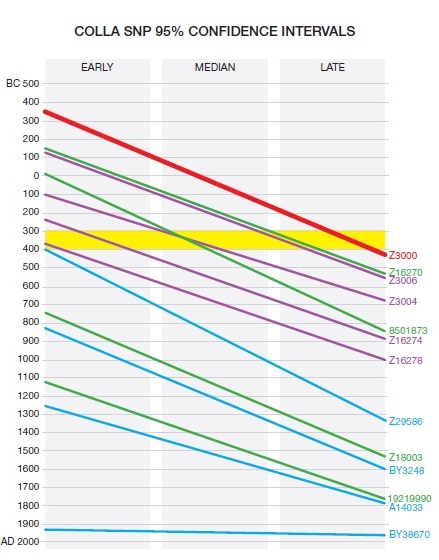
|
|
June 4 Comments by Delaney Henretty on The Origin and Establishment of the Collas
I wholeheartedly agree with Ron, as we have had side conversations on this topic. The age estimation for the relative SNPs does not support the conclusion that Z3008 is the only true Colla line. It seems more probable that if the Roman trained mercenary group or even tribal drift hypothesis are true, that a broad group of people that were related came to what is now Oriel at or near the same time period. (leaving ancestors or family in the area of origin, or path of migration) The 425 Null marker with attendant SNPs should still be the criterion for which we associate members of our group. It defies all scientific reason that a group of men with 4 STR markers shared by less than 2% of the DF21 haplogroup and hailing from the same area are not genetically, and politically related. That relationship does not predate the migration to Oriel. There are Carrol’s, as Ron points out, and myself that have historic Colla names, and whose ancestors hail from Oriel and we are Z16270. Just because a particular line, Z3008, became more prevalent than another, Z16270, it does not follow logically that the more ‘successful’ line is the true line, especially as surnames were not adopted until the last 1000 years or so. It is not good science to ignore inconvenient data and base conclusions on data that is more conjecture than concrete.
|
June 8 Comments by Delaney Henretty on The Origin and Establishment of the Collas
Please allow me to share the following observations:
- Everyone associated with this group shares a relatively ‘close’ paternal relationship given the number of shared SNP, and unique STR values.
- We attempt to use scientific and historic inquiry to ascertain the nature of our history and interrelationship to resolve the uncertainty in our shared history
- Patrick McMahon, who we owe our thanks for his scientific inquiry, is of Z3008 descent. Peter Biggins, who we owe our gratitude for the work he has done on Peters Pioneers, without which we would probably not even be discussing this topic is also Z3008.
- The hypothesis that Z3008 is the true Collas line is a hypothesis supported by data, but not conclusively proven by the data we have.
- The assertion that Z16270 remained continentally based until later invasions such as that of the Anglo-Saxons is not supported by the evidence. My particular family was prominent or ‘kings’ in Hy Meith Macha in the period between 900-1300 AD in Arghialla, predating the Norman Invasion of Ireland. The Hanrattys were supplanted by the McMahons and were relegated to holders or conservators of church property in and around Monaghan and Armagh. My oldest paternal ancestor came to the United States in the early 1800s when the King seized his lands. He spoke little English. There are a number of Carroll’s whose ancestry goes deep into ancient Arghialla who are also Z16270. McVarry is also a common surname in Oriel. Rogan is also a sept of Oriel. Our paternal lines are not continentally based Anglo-Saxons who arrived in Ireland at a later date.
- I am urging you to reevaluate the conclusion that “Colla should only be used for the nested clades under Z3008.” At the very least, there are descendants of Z16270, whether or not they are direct descendants of the Colla brothers, whose ancestors probably fought in the battles to secure the Kingdom of Arghialla and whose ancestors were prominent in that kingdom. The qualified 425 null value used to be the defining criterion for our ‘family.’ Now we have a greater number of choices to use for our defining criterion. It does not necessarily follow that we should narrow that criterion to exclude other possibilities until those possibilities are conclusively disproven.
- As Ron has demonstrated the SNP confidence intervals make it distinctively possible if not probable that Z3008 occurred after 400 AD, and that any or all of the Collas could have been Z16270, Z3008, Z3006, or Z3008. Because one branch of the ‘Colla’ family was more successful because they had a larger number of surviving offspring does not necessarily lead to the conclusion that they were direct descendants of the Collas. This is particularly true as surnames as we recognize them now were not adopted until 100s of years after the advent of the Collas in Ireland.
Interesting, Peter. I wholeheartedly agree with your assessment, “Note: Descendants of Colla Cousins may be descendants of The Three Collas if the actual timeframe is earlier than assumed. Some of the names are indicated as descendants of The Three Collas in the ancient Pedigrees.” |
June 19 Comments by Patrick McMahon on Ron Hendrickson and Delaney Henretty's Comments
Our recent exchanges of emails seems to have created a level of misunderstanding between us. In the hope of easing some of these, I have taken time out to analyse your particular situations within the Clan Colla 425 Null Project and tell your story as it is based on your results. I hope this will help appease your sense of grievance as expressed by you in earlier emails.
Analysis of the DNA profiles of Ron Hendrickson and Delaney Henretty
The Basics. You both have the key STR markers identifying you as belonging to Clan Colla 425 null (as constituted by Josiah). It then gets a bit more difficult.
- Ron has a Swedish surname but is showing STR matching to some Carrolls at GDs of 5/6 @ 67 markers. His GD to the Colla modal is 7, 5 to Casey and 4/5/6 to several Carrolls when tested against all (133) in the Z16270 clade. The latter is indicative of where a Swedish family might have acquired its Colla type DNA. [1] He is in the Z18003 clade.
- Delaney, with a good Oriel surname, has no STR matches in the whole FTDNA database (they regard GDs >9 @ 67 markers as unreliable and are not counted). Furthermore, his GD to the Colla modal (@ 67) is 15 which is off-scale. Also, when compared to all in the Z16270 clade, his best GDs are 11-13 against the A14071 clade members (Pedens, Peoples, Halligans) suggesting a Scottish association. There are no other Henrettys or Hanrattys to compare against which is unfortunate. In the early days of the Project, Delaney was scored as a Singleton either because it was thought he was the only survivor of his lineage or no other member of the lineage had tested (with FTDNA). He is in the BY3165 clade and at some stage his ancestor made his way to Oriel.
Migration. This seemed to cause much confusion. Obviously, it can only be inferred how our deep ancestors might have migrated from the extensive archeology and genetics pertaining to NW Europe. However, the emerging genetic patterns do allow for some fairly simple deductions to be made in the case of Clan Colla 425 members. SNP results have allowed us to identify clades and group together those sharing the same terminal SNP even though they may show no (conventional) relationships or shared surnames (i.e. deep ancestry). Clades can be further populated with testers who have significant relationships to the SNP tester. The following deductions can be made (estimated clade median ages (by the McDonald method) in Italics):
- Clades didn’t necessarily migrate as convenient groups but more likely divergent branches might go one place, other branches elsewhere and yet others would stay put.
- One step down from Z3000 (97AD) are Z16270 (233AD), Z3006 (248AD) and Z29586 (915AD). Z16270 divides into 2 sub-clades, 8501873-GGTTT-G (392AD) and BY3165 (332AD), the former giving Z18003 (1189AD) >A14034 (1500AD) and the latter, seven sub-clades. 8501873-GGTTT-G could easily have moved to Oriel where c. 800 years later it gave rise to Z18003 (Ron).
- BY3165 (332AD) at some stage gave rise to Delaney and Highlands (unrelated to each other, GD = 17 @ 67). This together with the GD of 15 to the Colla modal is indicative of a very early lineage for Delaney.
- Z3000 gave rise to a Kelly and Carfantan. Carfantan is a Breton whose family has lived in Brittany since the 1500s supporting the idea that Z3000 (or part of it) was continentally based. Descendants of Z16270 (233AD) itself had surnames whose origins could have been continental but were Southern British. BY3165 gave rise to seven sub-clades up to the medieval period whose surnames were more associated with Britain than Ulster with one exception, BY512/3 (O’Guin).
- From my sample of Collas examined (550), 404 (73%) are in Z3006 (248AD) and 387 (70%) in Z3008 (407AD). These meet the criteria of the Clan Colla 425 Null Project in that today’s descendants were or are living in or around Monaghan and have by and large surnames associated with this area (Oriel) in the limited records. It would therefore seem logical (to me at least) that should you believe the Colla brothers were in Oriel in the latter half of the 4th c. then they were in the Z3008 clade.
Descent. The other contentious issue was the lines of descent. Where there are parallel lines of descent, as is the case between Z16270 and Z3006, and then if you are in Z16270 clade you cannot claim descent from the Z3006/Z3008 clade where the evidence indicates the Colla brothers would have been. It is technically correct to state both clades have common ancestry in Z3000 and be referred to as Clan Colla 425 null people. On the present evidence it is a non-sequitur for members of Z16270 to claim direct descent from the Colla brothers.
[1] In the 17th century (after yet another defeat at the hands of the English) there were some 12,000 unemployed Irish swordsmen, wandering around Ireland, looking for plunder. Eventually a deal was arranged. These 12,000 swordsmen were "sold" to the Swedish king - and shipped as mercenaries to Sweden. (Perhaps …one of these intrepid Irish warriors (possibly a Carroll) was responsible for donating his DNA to the Hendricksons!)
|
May 19 Comments by Rory Cain on The Origin and Establishment of the Collas
For myself, I prefer the historical name Airghialla (“Eastern subjects”, from the Connachta dynasty’s Western perspective) rather than the later invented name Clan Colla.
As stated in the article both the principle Connachta Haplogroup of M222 and the O’Neill if Tyrone DF27 fail to match the Airghialla DF21. Nor does the alleged descent of the DF49 Ui Maine fit in.
I think the article is correct in dismissing the Ui Niall & Ui Maine descent. But it appears to be based on outdated thinking in trying to make DF21 to be Continental in origin. it looks to me (and Prof. Joe Flood of RMIT University) that DF21 is Isles in origin, with branches that reverted to the Continent, either as metallurgists & traders, or later as slaves to Viking raiders. But in anyone can pinpoint a Continental origin I am happy to learn of that.
|
May 19 Comments by Patrick McMahon on Rory Cain's Comments
The aim of the exercise was threefold,
- To disassociate the Colla population from Ui Neill descent (which we both agree on)
- To introduce the more precise way of referring to a genetically distinct population by its lead SNP (in this case, Z3000)
- To attribute Colla inheritance to one of the two major branches of Z3000, i.e. Z3008 and determine their origin and arrival in Ulster.
To use the term Airgialla for the Z3000 population (clade) is imprecise as Airgialla was a confederation of mid-Ulster tribes, nine in all I believe, who were probably unrelated genetically. Later, Airgialla referred to their territory which became Anglicised to Oriel.
You obviously don't believe the Collas were real people who arrived in Oriel in the 4th c. Yet there is a substantial amount of information suggesting that they did and were probably responsible for the major sub-clades (of Z3008), Z16274 (which ultimately gave rise to McMahons, Carroll, Calan, Hughes, McQuillan) & S953 (McDonalds, McGuires, Biggins, Connally).
Population drift of DF21 was in a NW direction from Continental Europe but not all DF21 would necessarily have joined the migration. All movements of people leave genetic footprints behind and this in my view would be an explanation as to how Z16270 (which branched from Z3000 c.150 AD) remained continentally based ultimately giving rise to a plethora of Anglo-Saxon, English, Welsh, Scottish type names which finished up in Britain much later. I don't believe Z16270 ever got near to Ireland with the exception of its sub-clade, Z18003 (Carroll).
|
|
Colla Surnames
Many of the Y-DNA testers who have Clan Colla DNA have surnames that the ancient genealogies say are descended from The Three Collas. But there are also a number of names that are not found in the ancient genealogies. As shown on the Abridged Clan Colla Big Y SNP Tree, the modern list of DNA-supported Colla names include:
Beggan
Boylan
Carroll
Clarke
Collins
Connolly |
Cooley
Devine
Duffy
Glennon
Hart
Higgins |
Hughes
Kelly
King
Larkin
MacDougall
Martin |
McArdle
McAuley
McClain
McDonald
McGinnis
McGroder |
McGuire
McKenna
McMahon
McQuillan
Monaghan
Murphy |
Murray
Neal
O'Hara
Reilly
Waters
White |
Researchers like John O'Hart, The Four Masters, and Donald Schlegel include Colla Clan pedigrees gathered from historic sources. Their work has been to a large extent validated by DNA testing. There are errors, however, as to which Colla sired which surname. And there are surnames that are supposed to be descended from Clan Colla but have not shown up so far.
Many people do not know where their patronymic ancestor came from, which is not uncommon. Only a small number of those tested live in Ireland or Scotland. Most live in America. Many of those have resorted to DNA testing for the very reason that they do not know where there ancestors came from when the emigrated to America.
Many Colla name are not included among our testers. There are several possible reasons.
- Many Colla names are uncommon.
- Only a small number of people have had their DNA tested thus far.
- Some people may have lost their name because an ancestor changed his name or was adopted.
- Ancient pedigrees probably included surnames of people who were not really Colla descendants.
Many testers do not have Colla surnames. There are several possible reasons.
- There was a name change by an ancestor.
- They or an ancestor were adopted.
- The historical lists of Colla descendants were incomplete.
- The name is on an ancient pedigree but we have not found it yet.
- Their ancestors were descended from cousins of The Three Collas; and their surnames, therefore, evolved differently.
- In early Irish history there was the concept of “fostering,” where two powerful tribal leaders would place their infant son with the other family to seal a defensive alliance. It is likely that some of these sons took on the tribal name of the family with whom they were placed.
Some Colla cousins have Colla names.
- The ancient pedigree erroneously included them as Colla descendants because they lived in the area of the Colla descendants.
- Most surnames have multiple septs.
Ireland was one of the first European countries to adopt hereditary surnames. At the end of his chapter on the Middle Ages in his 1969 book The Fermanagh Story, Rev. Peadar Livingstone (1932-1987) says on pages 23 and 24 that "Irish people in this era seem to have been obsessed with names. Long pedigrees are drawn up, giving the origins of most common families. As might be expected, most of the Fermanagh families trace themselves back to an Oriel origin. This, for the most part, is genuine enough. However, since an Oriel line ruled the country, it must have been popular to have Oriel origins. Some of the earlier Leinster Fir Manach must have been tempted to invent an Oriel connection where it did not exist." With that caveat in mind, we will take a look at the surnames of Clan Colla. See also Multiple-Sept Surnames.
Other on-line sources on Irish surnames and genealogy are:
Surnames from Hy-Maine have been removed from O'Hart's list of Colla surnames because DNA has shown them to have a different DNA. Hy Maine has the FGC6545 SNP, also known as FGC6550. See Hy Maine Modal.
- O Kelly, princes and lords of Hy-Maine, a territory in Galway and Roscommon. See O'Hart, page 684.
- Madden, lords of Siol Anmcha or Silancha, which ancient territory comprised the present barony of Longford, in the county Galway, and the parish of Lusmagh on the other (Leinster) side of the river Shannon, near Banagher, in the King's County. See O'Hart, pages 568 and 572.
- Traynor. See O'Hart, page 572-573.
- Naghtan or Norton, chiefs in Hy-Maine See O'Hart, page 603
- Hoolahan, chiefs of Siol Anmchada in Hy-Maine. Also Oulahan, a branch of Hoolahan, and variants Holland and Holligan. See O'Hart, page 487
- Leahy, chiefs in Hy-Maine. See O'Hart, Volume II, page 577
Several Colla names not listed by O'Hart are listed as Colla names by Peadar Livingstone or Edward MacLysaght:
- McAuley, a variant of McCawley, which is listed by Peadar Livingston in The Fermanagh Story (excerpt), page 436, as a descendant of Maguire.
- Biggins/Beggan/Beaghen/Little/Bigham, which was said by Peadar Livingstone to be descended from Maguire.
- Collins, a variant of Callan, which MacLysaght shows as an Oriel sept from Armagh/Monaghan.
- O'Donoghue, a variant of Donaghy, which is listed by Peadar Livingston in The Fermanagh Story (excerpt), page 426, as a descendant of Maguire.
- Smith, which is mentioned by Peadar Livingston in The Fermanagh Story (excerpt), page 444, as a variant of Gavin and Goan, descendants of the O'Gabhann sept, herenachs of Drummally in Fermanagh. Gavan is on the O'Hart list.
|
Clan Colla Maps: Airghialla
Toward the middle of the 4th century the breakup of the kingdom of the Ulaidh (Ulster) began as an attack on Emain Macha, the capital of the kingdom for hundreds of years, by the Three Collas. They established a new kingdom known as Airghialla, later Oriel, forcing the Ulaidh into east Ulster.
Peadar Livingstone Maps. Peadar Livingstone was a renowned scholar in both the Irish language and local history. He wrote comprenensive histories of two counties in Ireland: The Fermanagh Story (1969) and The Monaghan Story (1979). Included in each book was a map with surnames based on then present-day counts.
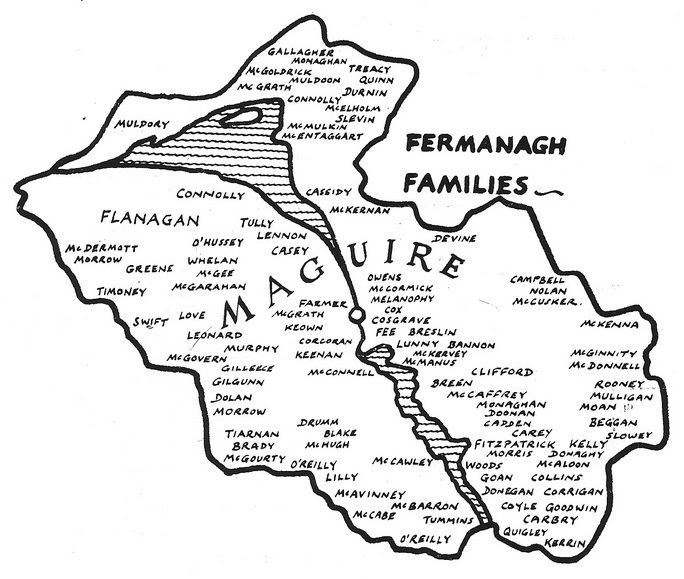
1969 map of surnames in County Fermanagh from Chapter 31, "Fermanagh Families," in The Fermanagh Story by Rev. Peadar Livingstone, Cumann Seanchais Chlochair, 1969. Names of Z3000 testers that appear on map: Beggan, Carey, Connolly, Devine, Hanratty, Kelly, McDonnell, Maguire, McCawley, McKenna, Monaghan, Murphy, Owens, Reilly. |
|
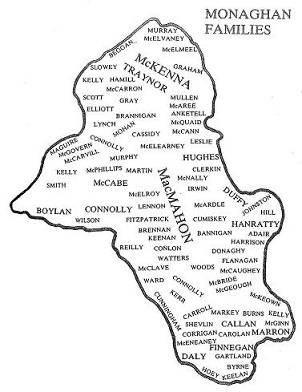
1979 map of surnames in County Monaghan from page 51 of The Monaghan Story by Rev. Peadar Livingstone, Clogher Historical Society, 1979. Names of Z3000 testers that appear on map: Beggan, Boylan, Callan, Carroll, Clerken, Connolly, Duffy, Hanratty, Hughes, Kelly, Maguire, McGinn, McKenna, McMahon, Murphy, Murray, Waters. |
|
Map of Fermanagh and Monaghan. Map showing how Fermanagh and Monaghan come together, togethwer with Cavan.
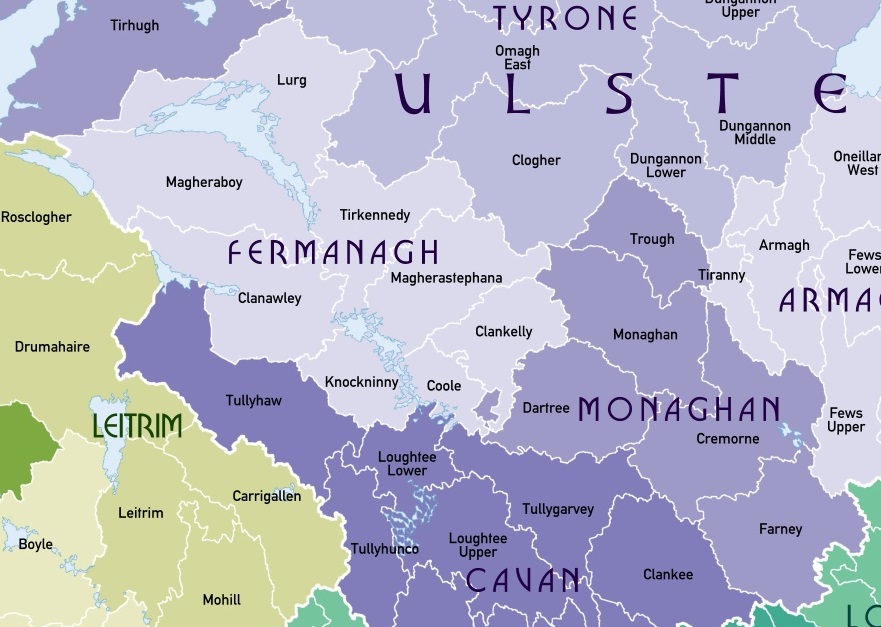
Map of baronies in Fermanagh and Monaghan in 1899. Source: Wikipedia |
Ancient Map of Airghialla. The map to the right shows Airghialla (or Oriel), a territory in northern Ireland founded by The Three Collas in the 4th century. It was inhabited by their descendants in later centuries. The Oxford Companion to Irish History edited by S. J. Connolly, 1998, says the Airghialla was composed of minor-kingdoms, each named after their ruling dynasty.
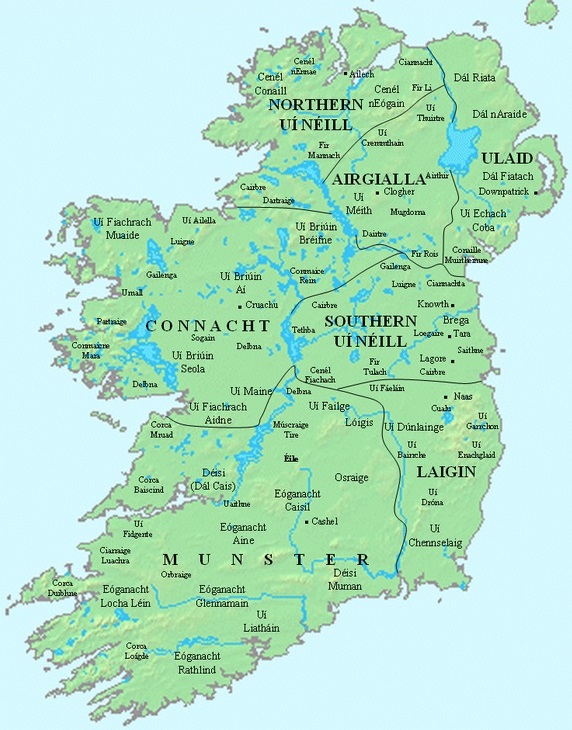
Ireland in 11th Century Early peoples in Ireland: the Airghialla and six other provinces as defined in the 11th-century Lebor na Cert (Book of Rights). |
- Colla Uais
- Uí Tuirtri, also spelled as Uí Tuirtre, meaning "descendants of Tort". They were based east of the Sperrin Mountains, roughly 20 miles south of Lough Foyle in eastern County Londonderry and Tyrone. From 776, the Uí Thuirtri had moved east of the River Bann and into the over-kingdom of Ulaid. The River Bann flows up from Lough Neagh on the right. It acts as most of the border between Londonderry and Antrim counties. By 919 they had lost all links to the Airgíalla.
- Erc
- Uí Maic Cairthinn, meaning "descendants of Cairthend". Based south of Lough Foyle at the top of the map, north of Tirkeeran barony in County Londonderry. See: 43 Generations: Colla to McDonald. (In the upper right corner of the map of Ireland is the Mull of Kintyre in western Scotland, where lived the McDonald descendants of of Somerled and Colla Uais.)
- Uí Fiachrach Arda Sratha, meaning "descendants of Fiachrach of Ard Straw". Based at Ardstraw, south southeast of Lough Foyle in Strabane Lower barony of County Tyrone. They became subject to the Cenél nEógain by the 12th-century, and expanded southwards into Fir Luírg, southwest of Ardstraw in Lurg barony in the north of County Fermanagh.
- Colla Crioch
- Uí Cremthainn, based in what is now parts of modern-day County Fermanagh, Monaghan, and Tyrone. See: 50 Generations: Colla to McMahon
- Uí Méith, based in modern-day County Monaghan.
- Airthir, meaning "Easterners". They were based around the city of Armagh, and held control of the offices of the church in Armagh, which had preeminence in Ireland.
- Mugdorna, based in County Monaghan, however by the 12th-century had settled the territory of Bairrche, located in southern County Down, and named it after themselves. Their name lives on as "Mourne", the present-day name for the area and the Mourne Mountains.
- Fir Chraíbe, also known as the Fir na Chraíbe, meaning "men of the branch". They were located west of the River Bann in north-eastern County Londonderry. By the 9th-century they were a subject-people of the Cenél nEógain.
- Fir Lí, also known as the Fir Lee, meaning "people of Lí". They were located west of the River Bann in mid-eastern County Londonderry. By the 9th-century they were a subject-people of the Cenél nEógain.
Map of Airghialla. Below is an exerpt from a 1899 map showing counties and baronies of Airghialla inhabited by descendants of The Three Collas.
Dartraighe, anglicised as Dartree, Dartry or Dartrey, was an Irish territory in medieval Ireland which stretched north to Clones. It was later incorporated into County Monaghan as the barony of Dartree. It was listed as part of the federated Kingdom of Airghíalla in the Book of Rights. The Irish annals for 947 AD say that Scolaige ua hAedacáin, king of Dartraige, and Gairbíth son of Muiredach, heir designate of Uí Chremthainn, and Aed son of Tigernán ua Ruairc were killed in battle in a counter-attack.
|
Keating on the Collas - 1634
The History of Ireland was written by
Geoffrey Keating about 1634 and circulated widely in manuscript form; the printing of books in Irish being effectively forbidden by the English rulers of Ireland at the time. Following is a translation into English of Section XLVII (from Volume 2) by David Comyn and Patrick S. Dinneen in 1902-1914. See: The Ex-Classics Web Site.
The History of Ireland, Section XLVII
Cairbre Lithfeachair son of Cormac, son of Art Aoinfhear, son of Conn
Ceadchathach, son of Feidhlimidh Reachtmhar, son of Tuathal Teachtmhar,
son of Fiachaidh Fionnoluidh of the race of Eireamhon, held the
sovereignty of Ireland twenty-seven years; and he was called Cairbre
Lithfeachair because it was near the Lithfe in Leinster that he was
brought up. And his mother was Eithne Ollamhdha daughter of Dunlaing
son of Eanna Nia. And Cairbre was slain at the Battle of Gabhra by
Simeon son of Cearb, one of the Fortuatha of Leinster; and the reason
why the Battle of Gabhra was fought was: Samhaoir daughter of Fionn
son of Cumhall was the wife of Cormac Cas son of Oilill Olom, and she
was the mother of Tinne and Connla and Mogh Corb; and it was by reason
of that relationship that Mogh Corb protected his mother's brother,
that is, Oisin son of Fionn, and the clanna Baoiscne from being
overpowered by Cairbre Lithfeachair and Aodh Caomh son of Garaidh
Glundubh of the race of Morna; and at that time the clanna Morna
formed the regular army of Ireland; and they were at enmity with Fionn
and with the clanna Baoiscne for seven years. Hence the party of
Garaidh Glundubh incited Cairbre Lithfeachair and the provincial kings
of Ireland to dethrone Mogh Corb in the hope that, as a consequence of
this, the clanna Baoiscne would be banished. And this led to the
Battle of Gabhra.
This Mogh Corb, with the manning of 300 ships, went with two brothers.
of his mother (they were sons of the king of Lochloinn) to obtain for
them the sovereignty of Lochloinn from the king of Lochloinn, whose
name was Iarus son of Iarnmhor, and he defeated the king in battle,
and slew him and his four sons and his eight brothers, and the
majority of the nobles of Lochloinn, and left his mother's two
brothers in the p0ssession of the country of Lochloinn.
Fothaidh Airgtheach and Fothaidh Cairptheach, two sons of Mac Con, son
of Macniadh, son of Lughaidh, son of Daire, son of Fear Uileann of the
race of Lughaidh son of Ioth, assumed the sovereignty of Ireland. They
both reigned conjointly one year. And Fothaidh Cairptheach fell by
Fothaidh Airgtheach, and Fothaidh Airgtheach fell by the Fian in the
Battle of Ollarbha.
Fiachaidh Sraibhthine son of Cairbre Lithfeachair, son of Cormac, son
of Art Aoinfhear, son of Conn Ceadchathach of the race of Eireamhon,
held the sovereignty of Ireland thirty-three years, and fell by the
three Collas in the Battle of Dubhchumair. Aoife, daughter of the king
of the Gallghaedheal, was the wife of Fiachaidh Sraibhthine, and
mother of Muireadhach Tireach; and he was called Fiachaidh Sraibhthine,
for it was at Dun Sraibhthine in Connaught he was fostered. Now in
order that this event may be better understood, we shall set down here,
from the Psalter of Cashel, the cause of the Battle of Dubhchumair,
and an account of the relationship that existed between the Collas and
Fiachaidh Sraibhthine.
It is at Cairbre Lithfeachair that the Oirghialla -- that is, the
family of the Collas -- separate in their pedigree from the clanna
Neill and the Connachtaigh. And Fiachaidh Sraibhthine son of Cairbre
Lithfeachair was grandfather of Eochaidh Muighmheadhon son of
Muireadhach Tireach, son of Fiachaidh Sraibhthine; and it is from this
Muireadhach that the clanna Neill and the men of Connaught are
descended. Eochaidh Doimhlean son of Cairbre Lithfeachair was brother
to Fiachaidh Sraibhthine; and this Eochaidh had three sons, to wit,
the three Collas, and from these are descended the Ui Mac Uais, the Ui
Criomhthainn, and the Modhornaigh. The real names of the three Collas
referred to were Cairioll, Muireadhach, and Aodh. Here is the
seancha's statement of this matter:
The three sons of Eochaidh, great their fame,
The three Collas we have heard of;
Colla Meann, Colla fo Chri,
And Colla Uais the high king.
The names of the three I know,
And they slew the high king
On yon wide bright plain,
Aodh Muireadhach and Cairioll.
Cairioll, Colla Uais the king,
Muireadhach, Colla fo Chri,
Aodh, Colla Meann, great his fame;
These three were mighty beyond all strength.
Aileach daughter of Udhaire king of Alba, wife of Eochaidh Doimhlean,
was the mother of the three Collas. It was Fiachaidh Sraibhthine these
three Collas slew, though a kinsman, which resulted in the sovereignty
of Ireland being lost to themselves. Now this was the cause of that
murder of a kinsman: When Fiachaidh was king of Ireland, he had a good
son called Muireadhach Tireach, and he was leader in battle for his
father, for the king himself would not be allowed into battle. On a
certain occasion Muireadhach went into Munster accompanied by a host,
and carried off hostages and spoils. Fiachaidh Sraibhthine happened
then to be at Dubhchumair, beside Taillte on the south side, and a
host with him there. His brother's three sons, that is the three
Collas, had another host at Dubhchumair near Taillte helping Fiachaidh
Sraibhthine. When they heard of the success of Muireadhach in Munster,
people generally said that he was the heir-presumptive to the
sovereignty of Ireland. "What shall become of us," said the Collas,
"if Muireadhach become king of Ireland after Fiachaidh?" "What we had
better do," said they, "is to give battle to the old king; and when we
have slain himself and his host, we shall overcome his son when he
will come against us." Fiachaidh at that time had a druid with him
called Dubhchumair; and he spoke thus: "O king," said he, "if thou
overcomest the Collas and slayest them, there will never be a king of
thy offspring after thee in Ireland; and if it be they who shall
succeed and slay thee, there will never be a king of Ireland of their
progeny." "Well, then," said the king, "I prefer to fall by the Collas,
and the kingdom to pass to my descendants after me, than that I should
slay the Collas, and that the sovereignty of Ireland should go to
their descendants after them." Thereupon the two hosts got ready for
battle, and made an onslaught on each other from either side; and
Fiachaidh Sraibhthine was defeated and slain in that battle, as
Dubhchumair had foretold of him.
Colla Uais son of Eochaidh Doimhlean, son of Cairbre Lithfeachair, son
of Cormac, son of Art Aonfhear, son of Conn Ceadchathach of the race
of Eireamhon, held the sovereignty of Ireland four years, and was then
with his brothers banished into Alba by Muireadhach Tireach son of
Fiachaidh Sraibhthine, where they were taken into military service by
their kinsmen. For Aileach daughter of Udhaire, king of Alba, the wife
of Eochaidh Doimhlean, was the mother of the three Collas. Cairioll
was called Colla Uais from his being distinguished above the other
Collas, since he held the sovereignty of Ireland, and the others did
not.
Muireadhach Tireach son of Fiachaidh Sraibhthine, son of Cairbre
Lithfeachair, son of Cormac, son of Art Aoinfhear, son of Conn
Ceadchathach of the race of Eireamhon, held the sovereignty of Ireland
thirty-three years, and fell by Caolbhach son of Cronn Badhraoi.
Muireann daughter of Fiachaidh, king of Cineal Eoghain, the wife of
Muireadhach Tireach, was mother of Eochaidh Muighmheadhon. As to the
Collas, they were banished by Muireadhach into Scotland, as we have
said; and their host numbered three hundred; and the king of Alba
received them with affection, and took them into military service on
account of their valour; and they remained there three years. They
came thence to Ireland -- that is, Colla Meann and Colla da Chrioch
and Colla Uais -- in the hope that Muireadhach Tireach might slay them,
though being his kinsmen, and that in consequence of this parricide
the sovereignty of Ireland might go to their descendants. And they
brought with them, as an escort, only nine warriors each, and they
neither halted nor rested till they reached Tara and came into the
presence of the king, Muireadhach Tireach. "Have ye news for us, O
kinsmen?" said the king. "We have no news," said they, "that would
affect thee more than the deed we ourselves have done, that is, that
we have slain thy father." "We have that news ourselves," said
Muireadhach; "and it matters not to you, as it shall not be avenged on
you; but the misfortune it has brought upon you will not pass away
from you." "That is the reproach of a coward," said the Collas. Be ye
not dejected; ye are welcome," said he. They spent a long time after
this in close friendship; and the Collas were leaders in battle for
the king.
The king told them, then, that it was time they should win territory
for their descendants. "In what territory dost thou wish us to make
sword-land?" -- there were no more daring youths in Ireland in their
time than they. "Rise out against the Ultonians," said he; "for ye
have just cause of battle with them, since an attendant of the king of
Ulster burned the beard or hair of Cormac son of Art with a candle in
Magh Breagh. Now, when Cormac had become king of Ireland, a strong
force of the Ultonians came against him and drove him into Connaught,
having carried off hostages from him. After that they made peace with
Cormac and get ready a feast for him in north Magh Breagh. And it was
there that an attendant of the king of Ulster burned Cormac's hair.
And that deed is still unavenged."
Upon this, king Muireadhach gave them a large host; and the Colla went
thence into the province of Connaught, and the men of Connaught took
them into military fosterage. After this, the men of Connaught joined
in their march with a force of seven battalions; and they reached Carn
Achuidh Leithdheirg in Fearnmhagh. From that hill they fought seven
battles against the Ultonians, that is a battle each day for a week.
Six of these battles were fought by the Connaughtmen, and by the
Collas was fought the seventh, in which Fearghus Fogha, king of
Eamhain, was slain; and the Ultonians were defeated and pursued from
Carn Achuidh Leithdheirg to Gleann Righe, and, after inflicting great
slaughter on them, the Collas returned and attacked Emhain, which they
plundered and burned, so that it has ever since remained without a
king to inhabit it. On that occasion, the Collas wrested the following
territories from the Ultonians, namely, Modharnuigh, Ui Criomthainn,
and Ui Mac Uais. Colla Meann took possession of Modharnuigh, and Colla
da Chrioch of Ui Criomhthainn, and Colla Uais of Ui Mac Uais. And
Muireadhach Tireach fell by Caolbhaidh son of Cronn Badhraoi.
Caolbhaidh son of Cronn Badhraoi, son of Eochaidh Cobha, son of
Lughaidh, son of Rossa, son of Iomchaidh, son of Feidhlimidh, son of
Cas, son of Fiachaidh Aruidhe, son of Aonghus Gaibhnionn, son of
Fearghus Foghlas, son of Tiobraide Tireach, son of Breasal, son of
Fearb, son of Mal, son of Rochruidhe, .son of Cathbhadh, son of
Giallchaidh, son of Cunnchaidh, son of Fionnchaidh, son of Muireadhach,
son of Fiachaidh Fionnamhnus, son of Irial Glunmhar, son of Conall
Cearnach of the race of Ir son of Milidh, held the sovereignty of
Ireland one year. Inneacht daughter of Lughaidh was the mother of
Caolbhaidh son of Cronn Badhraoi; and he was slain by Eochaidh
Muighmheadhon.
Eochaidh Muighmheadhon son of Muireadhach Tireach, son of Fiachaidh
Sraibhthine, son of Cairbre Lithfeachair, son of Cormac Ulfhada son of
Art Aoinfhear, son of Conn Ceadchathach, held the sovereignty of
Ireland seven years. Moingfhionn daughter of Fiodhach, wife of
Eochaidh Muighmheadhon, was mother of Brian and of Fiachhaidh Fearghus
and Oilill. And Cairrionn Chasdubh daughter of the king of Britain,
another wife of Eochaidh's, was mother of Niall Naoighiallach. And he
was called Eochaidh Muighmheadhon because, as to his head and breast,
he resembled the king, and, as to his waist, he resembled a slave
called Mionghadhach, and hence he was called Muighmheadhon.
It was over Eochaidh Muighmheadhon that Eanna Cinnsealach, king of
Leinster, won the Battle of Cruachan Claonta; and therein Ceadnathach,
filé to Eochaidh Muighmheadhon, was taken prisoner. But when Eanna
came up, he inquired of his party why they had spared the druid. "Thou
wouldst never," said the druid, "conquer from this hill on which I am,
if I were to live." Upon this Eanna transfixed him with his spear; and,
as the spear pierced his body, a laugh broke forth from Eanna. "Alas,"
said the druid, "that is a foul laugh, and it is this that will be
given as a name to thy posterity after thee for ever"; and hence that
tribe are since called Ui Cinnsealaigh. Eanna Cinnsealach was powerful
in his time, as may be seen from the poem composed by Dubhthach son of
O Lughair, who was chief ollamh of Ireland when Patrick came to
propagate the Gospel in Ireland. A battle fought by the Leinstermen,
is the beginning of that poem. But I shall here quote only these two
stanzas of it, from which it may be inferred that Eanna was powerful
in his time. Here are the stanzas: --
The tribute which was given to Eanna,
From Leath Cuinn of the feasts,
Was a screaball from each house,
All of fionudruine.
The tribute which was given to Eanna,
From Mumha with insults
Was an ounce of gold from each lios
In the ensuing year.
And according to the Psalter of Cashel this Eanna defeated the clann
Cuinn in thirteen battles.
Criomhthann son of Fiodhach, son of Daire Cearb, son of Oilill Flann
Beag, son of Fiachaidh Muilleathan, son of Eoghan Mor, son of Oilill
Olom of the race of Eibhear, held the sovereignty of Ireland seventeen
years. Fidheang, daughter of the king of Connaught, was his wife. This
Criomhthann gained victories and obtained sway in Alba, Britain, and
France, as the seancha says in the following stanza: --
Criomhthann son of Fiodhach swayed
The lands of Alba and of Erin;
He swayed likewise beyond the clear blue sea
Even the Saxons and the French.
It was also Criomhthann son of Fiodhach who gave the kingdom of Leath
Mogha or Munster to his foster-son, namely, to Conall Eachluaith son
of Lughaidh Lamhdhearg; and the descendants of Fiachaidh Muilleathan
were displeased at this; and they said that Conall did not show
himself a good kinsman by accepting it, while there was at the time
among the descendants of Fiachaidh one qualified to be a good king,
namely, Corc son of Lughaidh. And the arbitration the learned sages of
Munster made between them at the time was that Corc son of Lughaidh
was to have the sovereignty of Munster in the first instance, as he
was the senior, and that it was finally to go to the descendants of
Cormac Cas. The descendants of Fiachaidh Muilleathan gave sureties and
guarantees that they would allow the sovereignty of Munster to pass on
the death of Corc to Conall Eachluaith or to his son should Conall
himself be not living, as Oilill Olom ordained that it should belong
to these two families in alternate generations, that is, the family of
Fiachaidh Muilleathan and that of Cormac Cas. It was on that agreement,
then, that Conall Eachluaith allowed the sovereignty of Munster to go
to Corc son of Lughaidh; and, on the death of Corc, Conall Eachluaith
himself took up the sovereignty of Munster; and Criomhthann son of
Fiodhach gave the hostages of the men of Ireland, of Alba, Britain,
and France into the hands of Conall Eachluaith. And accordingly Cormac
son of Cuileannan composed the following stanzas: --
Eachluaith received the tribute of Ireland
After Criomthann, it was a tribute from abroad;
Though he had not gone beyond the Sea of Manainn,
Never did a better king receive it.
As many as great Criomhthann son of Fiodhach brought
Of hostages over the brimming sea,
He gave into the hand of the red-speared champion,
Illustrious noble Conall Eachluaith.
Conall Eachluaith set out on an expedition
Into every territory after pleasant Criomhthann;
To Dun Liamhna, illustrious was the warrior,
Where noble companies were slain.
To him belonged Fearta Conaill in Feimhion,
Druim Chormaic Aine Dun Gair,
Cashel Coincheann strong Raith Leamhna,
Fochair Mhaigh fair Dun Cearmna. E.
Moingfhionn daughter of Fiodhach, Criomhthann's own sister, gave him a
poisoned drink in Inis Dornghlas on Muaidh, in the hope that the
sovereignty would pass to her favourite son, that is, Brian son of
Eochaidh Muighmheadhon; and Criomhthann son of Fiodhach died of the
poison of that drink on Sliabh Uidhe an Riogh, on the north side of
Luimneach; and Mongfhionn herself died of the poison of the same drink
in Inis Dornghlas on Muaidh, having taken some of it to urge her
brother to drink it.
|
|
The Four Masters on the Collas - 1632-1636
The Annals of the Four Masters were composed from 1632 to 1636 in the Franciscan Monastery of Donegal chiefly by Michael O'Clery (1580-1643). In 1845, Irish historiographer Owen Connellan translated the book from Irish to English. In May 2007, Google digitized a copy of the translation from the Library at Oxford University: Annals of the Four Masters. A long footnote that starts on page 2 describes the ancient kingdom of Oriel and includes the descendants of The Three Collas.
Annals of the Four Masters
The posterity of The three Collas, called clan Colla, founded many powerful clans and noble families in Ulster and other parts of Ireland.
- From Colla Uais were descended the MacDonnells, earls of Antrim in Ireland, and lords of the Isles in Scotland; also the MacRorys, a great clan in the Hebrides, and also many families of that name in Ulster, anglicised to Rogers.
- From Colla da Chrich, were descended the MacMahons, princes of Monaghan, lords of Ferney, and barons of Dartree, at Conagh, where they had their chief seat. The MacMahons were sometimes styled princes of Orgiall. An interesting account of the Mac Mahons, of Monaghan, is given by sir John Davis, who wrote in the reign of James the First. It may be observed that several of the MacMahons in former times changed the name to Mathews. The other chief clans of Monaghan were the MacKennas, chiefs of Truagh; the MacCabes; the MacNeneys, anglicised to Bird; the MacArdells; MacCassidys; O'Duffys, and O'Corrys; the O'Cosgras, MacCuskers or MacOscars, changed to Cosgraves, who possessed, according to O'Dugan, a territory called Fearra Rois, which comprised the district about Carrickmacross in Monaghan, with the parish of Clonkeen, adjoining, in the county of Louth; the Boylans of Dartree; the MacGilMichaels, changed to Mitchell; the MacDonnells; the O'Connellys, and others.
- From Colla-da-Chrich were also descended the MacGuires, lords of Fermanagh, and barons of Enniskillen; the O'Flanagans of Fermanagh; the O'Hanlons, chiefs of Hy-Meith-Tire, now the barony of Orior in Armagh, who held the office of hereditary regal standard-bearers of Ulster; the MacCathans or MacCanns of Clan Breasail, in Armagh; the O'Kellys, princes of Hy Maine, in the counties of Galway and Roscommon; and the O'Madagans or
O'Maddens, chiefs of Siol Anmchadha or Silanchia, now the barony of Longford, in the county of Galway.
|
|
O'Hart on the Collas - 1892
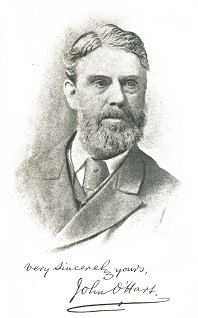
John O'Hart, 1824-1902. |
"From the Three Collas descended many noble families in Ulster, Connaught, Meath, and Scotland, The families descended from them were known as the Clan Colla." This is the way John O'Hart introduces the pedigrees of Three Collas in his book, Irish Pedigrees; or, the Origin and Stem of the Irish Nation, published in 1892 (fifth edition), Volumes I and II.
John O'Hart was born in 1824 in Crossmolina, County Mayo. His parents were Shane (John) and Nora Kilroy O'Hart of Crossmolina. His grandparents were Shane and Mary Martin O'Hart of Doonbreeda, County Mayo.
In 1845, John O'Hart married Elizabeth Burnett in Crossmolina. They moved to Dublin, where John worked for the National Education Department. In 1859, he began working on Irish Pedigrees. The first edition was published in 1876. The fifth and final edition wa published in 1892. He died in 1902 in Clontarf, near Dublin, at the age of 78.
Professional genealogist John Grenham commented on John O'Hart in a blog dated July 11, 2016, saying that John O’Hart is "probably the single best-known writer on Irish genealogy." He had "an extraordinary appetite for work and appears to have read and absorbed every single Irish pedigree published before the 1870s."
Included in John O'Hart's Irish Pedigrees is his own pedigree, which goes back to The Three Collas: O'Hart Princes of Tara and Chiefs in Sligo. Included are Shane, the last prince of Tara in County Meath, who was deprived of his patrimony by King Henry II of England at the time of the Norman invasion in 1172 and resettled in County Sligo. Sixteen generations later, at the time of the Cromwellian confiscations, another Shane migrated from Sligo to a farm in Doonbreeda, County Mayo. This Shane is the great grandfather of John O'Hart.
John O'Hart said he himself was a descendant of The Three Collas. He is generation No. 125 on page 679.
The footnote on page 678 says one of John's relatives was John Hart (1713-1779) who signed the Declaration of Independence for New Jersey on July 4, 1776. There are several Harts who have Clan Colla DNA, but they have no evidence of descending from John Hart the Signer. A discussion of the Y-DNA of John Hart the Signer can be found in: The Y-DNA Genetic Signature of an American Founding Father – John Hart the Signer, by Dr. Jeffrey Mark Paull and Susan K. Steeble. They say the signer's DNA is R-L21>S552>DF13>Z39589>Y126199>BY55538>BY54949.
Google Books has made the 1892 edition available online:
O'Hart provides two lists of surnames of Colla descendants:
Below is a consolidation of the two lists, in alphabetic order without regard to O' and Mac, with links to pages in the book.
|
Colla Surnames from O'Hart's Irish Pedigrees
|
The list of Colla descendants is not meant to be exhaustive. Some Colla surnames are not on O'Hart's two lists, but are referred to as Colla descendants elsewhere in his book. Page numbers are in parentheses.
The general surname indexes for the 1892 edition are:
The University of Pittsburgh Library System has made the 1892 edition available online as a PDF file or Ebook:
Library Ireland has made a transcript of Volume I available online.
Irish Pedigrees, Volume I, 5th Edition, pp. 669-670
Among those descended from Colla Uais are—Agnew, Alexander, Donelan, Flinn, Healy, Howard (of England), MacAllister, MacClean, MacDonald, lords of the Isles, and chiefs of Glencoe; MacDonnell, of Antrim; MacDougald, MacDowell, MacEvoy, MacHale, MacRory, MacVeagh (the ancient MacUais), MacVeigh, MacSheehy, O'Brassil, Ouseley, Rogers, Saunders, Saunderson, Sheehy, Wesley, etc.
"The barony of Cremorne in Monaghan," writes Dr. Joyce, "preserves the name of the ancient district of Crioch-Mughdhorn or Cree-Mourne, i.e., the country (crioch) of the people called Mughdorna, who were descended and named from Mughdhorn (or Mourne), the son of Colla Meann."
And among others descended from Colla Meann was Luighne [Lugny], who was the ancestor of Spears; and who, by his wife Basaire of the Sept of the Decies of Munster, had a son called Fearbreach [farbra] ("farbreach:" Irish, the fine-looking man), who was bishop of Yovar, and who (according to the Four Masters) was fifteen feet in height!
The following are among the families of Ulster and Hy-Maine descended from Colla da Chrioch: Boylan, Carbery, Cassidy, Corrigan, Corry, Cosgrave, Davin, Davine, Devin, Devine, Devers, Divers, Donegan, Donnelly, Eagan, Enright, Fogarty (of Ulster), Garvey, Gilchreest, Goff, Gough, Hart, Harte, Hartt, Hartte, Higgins, Holland, Holligan, Hoolahan, Hort, Keenan, Kelly, Kennedy, Keogh, Lally, Lannin, Larkin, Laury, Lavan, Lalor, Lawlor, Leahy, Loftus, Loingsy (Lynch), Looney, MacArdle, MacBrock, MacCabe, MacCann, MacCoskar, MacCusker, MacDaniel, MacDonnell (of Clan-Kelly), MacEgan, MacGeough, MacGough, MacHugh, MacKenna (of Truagh, co. Monaghan), MacMahon (of Ulster), MacManus, MacNeny, MacTague (anglicised Montague), MacTernan, MacTully, Madden, Magrath, Maguire, Malone, MacIvir, MacIvor, Meldon, Mitchell, Mooney, Muldoon, Mullally, Muregan, Naghten, Nawn, Neillan, Norton, O'Brassil, O'Callaghan (of Orgiall), O'Carroll of Oriel (or Louth), O'Connor of Orgiall, O'Duffy, O'Dwyer, O'Flanagan, O'Hanlon, O'Hanratty, O'Hart, O'Kelly, O'Loghan, O'Loghnan, O'Neny, Oulahan, Rogan, Ronan, Ronayne, Slevine, Tully, etc.
|
|
Clan Colla Saints
In his Irish Pedigrees; or, the Origin and Stem of the Irish Nation, published in 1892 (fifth edition), Volume II, page 581, John O'Hart says The Four Masters record 39 saints as descended from The Three Collas: 19 from Colla-da-Chrioch, 16 from Colla Uais, and 4 from Colla Meann.
The following were the 19 saints descended from Colla-da-Chrioch.
- St. Begg (1st August)
- St. Brughach (1st Nov.)
- St. Curcach, virgin
- St. Daimhin (or Damin), abbot of Devenish Abbey (see page 189), on Devenish Island, Lough Erne.
- St. Defraoch, virgin.
- St. Donart.
- St. Duroch, virgin.
- St. Enna of Aaron (21st Mar.)
- St. Baodan (5th Feb.)
- St. Fergus (29th March)
- St. Fiachra (2nd May)
- St. Flann Feabhla (20th April)
- St. Lochin, virgin
- St. Loman of Loughgill (4th Feb.)
- St. Maeldoid (13th May)
- St. Mochaomog.
- St. Muredach (15th May)
- St. Neassa, virgin
- St. Tegan (9th Sept.)
Saint Berchan. Saint Berchan lived in the 5th century and is listed on page 17 of the The Martyrology of Donegal: A Calendar of the Saints of Ireland, translated by John O'Donovan in 1864. He lived on Inish-Rochla, an island in Lough Erne near Enniskillen in County Fermanagh, Ireland. He was five generations down from Colla da Crioch, one of The Three Collas. His feast day is November 24.
Saint Cinnia. Saint Cinnia lived in the 5th century. She was a princess of Ulster, Ireland. Saint Cinnia was converted to Christianity by Saint Patrick. When she entered a convent, Saint Patrick gave her the veil. She was descended from Colla da Crioch, one of The Three Collas. Her feast day is February 1.
Saint Tigernach. Saint Tigernach was said to have been the godchild of Saint Brigid, and educated in Scotland. He may have been a monk at Clones as well as a bishop of Clogher in County Monaghan, but accounts are not too clear. He also is called Tierney and Tierry. Saint Tigernach died in 549. He was descended from Colla da Crioch, one of The Three Collas. His feast day is April 4.
Saint Cairnech. Saint Cairnech was born after the middle of the 5th century. His brothers were St. Berchan and St. Ronan. His monastery was probably at Cruachan Ligean on Loughh Foyle, near Lifford. He died about 530. He was descended from Colla da Crioch, one of The Three Collas. His feast day is March 28.
|
Four Colla Descendants
This study of the Y-chromosome DNA of The Three Collas is the product of four Clan Colla descendants.
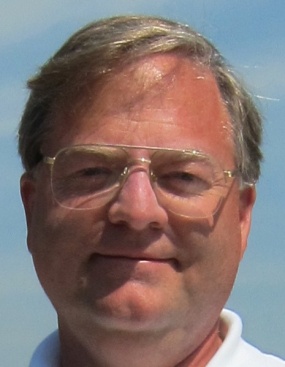 | Josiah McGuire. Josiah McGuire had his DNA tested at FTDNA in 2004. By early 2005 he recognized that he matched several other people with Colla surnames and began studying those matches. After upgrading to 67 markers in 2006, Josiah learned that he had a null value for marker 425, as did the other Colla surnames. In 2007 Josiah computed modal values for the DNA of The Three Collas. In June 2009, he started the Clan Colla Null 425 Project at FTDNA to attract Clan Colla descendants, encourage upgrades to the 67-marker test, and promote Clan Colla research. Josiah's DNA kit is #23171. He is descended from Colla Uais. He traces his Colla ancestry back to the eponymous Josiah McGuire, who was born in 1794 in the Commonwealth of Virginia. He has a McGuire family heritage website called A McGuire Family in America. Josiah lives in Indiana, USA. His email address is: j_j_mcguire@msn.com |
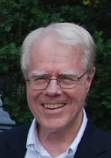 | Peter Biggins. Peter had his DNA tested at FTDNA in 2008. When he realized with Josiah's help in May 2009 that he was descended from The Three Collas, he added this page on the DNA of The Three Collas to his genealogy website called PetersPioneers. In addition to the Clan Colla Null 425 Project, Peter is an administrator of the
Breassal Breac Project,
Biggins Project,
the Carroll Project,
the Ely Carroll Project,
the Drueke Project,
the Null 425 Project,
the Roderick Project,
the Middlessex Genealogical Society Project, and
the DF21 Project.
His DNA kit is #127469. He is descended from Colla Uais. Peter has traced his Colla ancestry back to Patrick Biggins (Beggan), who was born in 1807 in Ireland, possibly Drumgill, County Cavan (see Patrick Beggan of Drumgill). Peter lives in Connecticut, USA, where he is Secretary of the Middlesex Genealogical Society. His email address is: pabiggin@optonline.net |
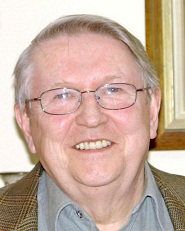 | Patrick McMahon. Patrick Ciaran McMahon had his DNA test at FTDNA in 2009. He is administrator of the McMahon Project at FTDNA as well as the Clan Colla Null 425 Project. In addition to being a fellow Colla descendant, Patrick spent his career working as a geneticist/operational analyst for the British Ministry of Defence. Patrick's DNA kit is #145687. He is descended from Colla da Crioch. Patrick has an advanced degree in genetics from Trinity College Dublin. He and his brother Eugene have traced their family back to Faolan MacMathghamhna (Felim/Phelan MacMahon), who lived in County Monaghan in the early 12th century (see 50 Generations: Colla to McMahon). Patrick also has done an in-depth analysis of the Origin of The Three Collas. Patrick grew up in Hampstead Park,
Glasnevin, Dublin, and now lives in Gorey, Ireland. His email address is: patgorey@yahoo.co.uk |
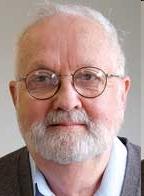 Thomas Roderick, 1930-2013. Thomas Roderick, one of the original producers of this webpage, died September 4, 2013. The following background information was included in his obituary that appeared in the Bangor Daily News. Thomas Roderick, 1930-2013. Thomas Roderick, one of the original producers of this webpage, died September 4, 2013. The following background information was included in his obituary that appeared in the Bangor Daily News.
He graduated from the University of Michigan in philosophy in 1952 and zoology in 1953 and from the University of California, Berkeley, with a PhD in 1959. He then joined The Jackson Laboratory in Bar Harbor, as a staff scientist in genetics where he remained for 37 years. His research included the effects of radiation on genetic material, behavioral genetics, and later bioinformatics, publishing widely in genetics and genealogy. In 1973 -1975 he worked at the Atomic Energy Commission, looking at the potential impact of nuclear radiation on humans and the world. He is credited with coining the term "genomics" and developed with others at The Jackson Laboratory the first online genetic database. During his career he co-directed the Annual Short Course on Medical and Experimental Mammalian Genetics and co-founded the Center for Human Genetics in Bar Harbor.
The following message was sent to participants in the Clan Colla DNA project at Family Tree DNA.
Tom Roderick, a fellow Colla descendant and one of our four Clan Colla project administrators, died September 4 at his home in Bar Harbor, Maine.
Tom had his DNA tested at FTDNA in 2003. He was administrator of the Roderick-Rhydderch Family Project at FTDNA in addition to the Clan Colla Null 425 Project.
Tom was a research geneticist and one of the original members of the international Human Genome Organization in 1988. He was on the Emeritus Staff at The Jackson Laboratory. He had a PhD in genetics from the University of California, Berkeley.
Tom was a member of the National Genealogical Society and had traced his Colla family back to Rhydderch Evan who was born circa 1700 in Llantrisant, Glamorgan, Wales.
Two years ago, Tom summarized his views on our project: "The Clan Colla Null 425 Project stems from the discovery that in haplogroup R1b1a2a1a1b4 there is a single subset carrying a null at DYS 425 and probably unique or nearly unique values at 2 or 3 other loci. What is important is that this haplotype clearly is associated with only one grouping of Irish clans and surnames, each of which by historical records emanates from The Three Collas, a successful aggressive clan flourishing 300-400 AD. We are looking for evidence that this null is associated with other families with different ancestry and as yet have not definitively found it. This gives us an estimate of the time of the mutation to the null a little before 300 AD.
"From the other markers, we find (using 67 Y markers) the genetic distances among the Colla Group and Colla Modal DNA range between 1 and 11, and have an average of 6. Of the 232 people, 218 or 94% of the group have a genetic distance of 3 to 9.
"These data are consistent with our estimate of the timing of the null mutation.
"One great advantage of this grouping is that it is well defined molecularly, therefore confined, small enough and yet old enough to make genealogical sense coordinating molecular and historical evidence. By more detailed analysis we can get better understanding of specific genealogical relationships among clusters of the several clans and many surnames."
Tom is in our prayers and our hearts go out to his wife Hilda and their family. He will be sorely missed by his fellow administrators.
- Peter Biggins, Josiah McGuire, Patrick McMahon
Some responses from project members:
- Very sorry to hear the news of Tom's death. He made an incredible contributions to the Clan Colla group. He will be greatly missed.
- Sally & Geoff Walker
- Thank you so much for telling me this message.
God Bless all, Donna Reiling (Gerald Alldredge Johnson)
- Thank you for letting me know about Tom's passing. For me, Tom helped opened a very unexpected door to a family and ancestral history I did not know existed. My prayers go out for his family. - Rich Kern
- So Sorry to learn of this. I will reach out to Hilda. Tom and I had very similar genetic code... So he said. I met him only once and by chance at my parents home when he and Hilda dropped by during a cross county trek. He convinced me to participate in the study and I'm glad I did. - Best regards, Richard Roderick
- Sincerest sympathies and thanks to the family for all of Tom's work. May his soul rest at God's right hand. Ar dheis De'go raigh a n-anamach-Gaelic - Doreen McKenna Powers and family
- I'm very sorry to hear about Tom. Thanks for letting us know. - Cathy (Gerald Collins, 74679)
- Thank you for the update. Will hold positive thoughts for his family as they embrace his spirit and his loss. - Mary Ann Conley Wandell
- I was saddened to learn of the death Thomas Roderick. His death is a loss to genetic genealogy. - Terry McGuire
Tom's DNA is still in our project. His kit number is 8551. He is descended from cousins of The Three Collas.
|
FTDNA Clan Colla DNA Project
| Date | Testers with Z3000 Y-DNA |
|---|
| Database | Clan Colla
FTDNA Project | BIG Y Tree* |
|---|
| June 2009 | 61 | 0 | |
| January 2010 | 145 | 52 | |
| June 2011 | 232 | 148 | |
| November 2011 | 259 | 170 | |
| December 2012 | 304 | 218 | |
| April 2013 | 319 | 234 | |
| May 2013 | 323 | 238 | |
| August 2013 | 331 | 245 | |
| December 2013 | 341 | 251 | 0 |
| June 2014 | 380 | 288 | 14 |
| January 2015 | 401 | 310 | 36 |
| August 2015 | 447 | 356 | 60 |
| March 2016 | 486 | 403 | 79 |
| August 2016 | 532 | 451 | 102 |
| August 2017 | 594 | 507 | 126 |
| August 2018 | 643 | 567 | 146 |
| August 2019 | 684 | 600 | 184 |
| October 2020 | 755 | 667 | 257 |
| August 2021 | 813 | 706 | 306 |
| August 2022 | 870 | 759 | 368 |
| August 2023 | 902 | 786 | 408 |
| August 2024 | 976 | 805 | 456 |
| *Big Y Tree includes testers not in Clan Colla FTDNA project |
The Clan Colla 425 null project at Family Tree DNA is for men who have tested their Y-DNA at FTDNA and have, or are predicted to have, a particular kind of DNA called Z3000. Many men with this type of DNA have surnames associated with descendants of The Three Collas who emigrated from England to Ulster in the 4th century.
Family Tree DNA has the largest DNA database in the field. For a look inside the FTDNA lab, see "A Visit to Family Tree DNA's State-of-the-Art Lab," written by Cece Moore in February 2013 based on a tour in November 2012.
Josiah McGuire started the Clan Colla 425 Null Project in June 2009 and serves as administrator of the project along with Patrick McMahon and Peter Biggins. The project is designed to attract Clan Colla descendants and their cousins, encourage Y-chromosome DNA testing, and promote Clan Colla research.
The Clan Colla project is a haplogroup project. The haplogroup is named R-Z3000, which is a SNP common to those who have Clan Colla DNA or are cousins thereof. You can participate in multiple projects at FTDNA. You are encouraged to participate in your surname project and projects for haplogroups upstream of Z3000: R-L21 and R-DF21. There is no cost for being part of projects.
By testing the Y-chromosome DNA, males can determine the origin of their paternal line. Y-DNA goes back male to male to male, like surnames. If you are a female and would like to know about your paternal line, you would have to find a male relative from that line willing to be tested, such as your father, a brother, or a cousin.
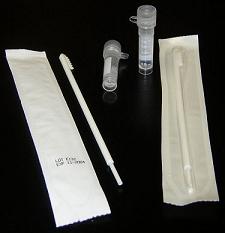
The two swabs and scraper tubes in the FTDNA Kit. For more on how it's done, see "DNA Collection Method" by Dave Dorsey. |
|
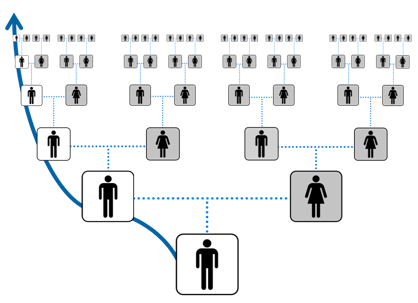
Y-chromosome DNA goes back male to male like traditional surnames. |
|
The Testing Process. Here are the steps in the testing process for a new tester:
- Sign up online for FTDNA at a surname or geographical project. See Surname & Geographical Projects
- Specify what test you want.
- FTDNA deducts the cost from your credit card.
- They send you a kit containing two scrapers,
- You use the scrapers to swab the inside of your cheeks, four hours apart.
- You return the scrapers in receptacles and mailer provided in the kit.
- FTDNA sets up a homepage for you on their website that you access with your kit number and a password.
- You get final results on line two months later on your homepage and on the project's public results page.
- Your homepage gives you a list of other testers who match your DNA.
- Ask the administrator of the surname project about haplogroup (SNP) projects you should join.
- Ask the administrator of the haplogroup (SNP) project you join about further testing.
- If you think you have Clan Colla DNA, join the Clan Colla 425 null project.
There are a number of prefixes used by Family Tree DNA to identify kits ordered through partner companies or kits which have been transferred from another company. The following is a list of the prefixes in the Clan Colla 425 null project as of December 2022, as provided by ISOGG (International Society of Genetic Genealogy).
- AM – Test was ordered through Amazon.com
- B – Those who transfer Y-DNA or autosomal results through a lab transfer program (eg AncestryDNA, 23andMe)
- BP - Basic packaging. Kits sent out in the basic plastic packaging rather than the new cardboard box
- E – Those who test with iGenea, FTDNA's European associate
- H – Those who tested with DNA Heritage and transferred their results
- IN – International – a test kit that was ordered through the FTDNA website alone (not with other kits) that is being shipped internationally
- MI – Multi Kit International – a test ordered through the FTDNA website at the same time as several other kits, all of which are being shipped
- MK – Multi Kit – a test ordered through the FTDNA website at the same time as several other kits, all of which are being shipped domestically
- N – Those who test with and transfer from the National Geographic Genographic Project
- SI - Single international dry swab kits
Requirements for Clan Colla DNA. You are considered to have the Y-DNA of Clan Colla or Colla cousins if you have the Z3000 SNP.
You can join the Colla project without this evidence. We will review your DNA testing. You will be told whether you have a chance of having Clan Colla DNA. If you have no chance, you will be removed from the project. If you meet our requirements, you will be placed in a subgroup. If you have less than 67 markers but have a chance of meeting our requirements with further testing, you may be placed in a special category for people with less than 67 markers.
Clan Colla Testing Alternatives. There are two kinds of markers for Y-chromosome DNA: STRs and SNPs.
- A SNP is a Single Nucleotide Polymorphism, a mutation in the DNA that happens when a single nucleotide (A, T, G, or C) in the genome sequence is altered. A person has many SNPs that together create a unique DNA pattern for that individual. Collas and their cousins have the Z3000 SNP and many downstream SNPs that show where they fall on the Z3000 Colla SNP tree.
- An STR is a Short Tandem Repeat, or count of repeats at a physical location on the chromosome. These repeats can be used to predict SNPs. They can be used to create a modal DNA for a group of men that match each other. And they can be used to measure genetic distance between two testers and between a tester and the modal DNA.
There are several alternative approaches to testing for Clan Colla DNA. We encourage you to contact a Clan Colla project administrator before deciding on a testing strategy. Having a Clan Colla surname is an indicator, but most Colla names have alternate origins. For example, there are Monaghan McMahons (Colla descendants) and Clare McMahons (not Colla descendants). But you don't have to have a Colla name because many surnames were probably never recorded in the histories.
The following tests at FTDNA can put you on the Results page of the Clan Colla project.
- Big Y-700: This test puts you on our Unabridged Big Y SNP Tree as well as the Results page of the Clan Colla project. We recommend ordering BIG Y above all others. The cost is $229 to $399 on sale, depending on how many STRs already have been tested. Most testers have 67 or 111 STRs before they join our project, resulting in a sale price of $259 or $229. There is no need to swab again when you upgrade. More recently, testers are buying Big Y to start with. The sale price of $399 is less expensive than buying STRs first and then upgrading to Big Y. There are three parts to the Big Y test:
- Big Y SNPs. Testing for SNPs on a large portion of your Y chromosome through BIG Y-700. This is the ultimate in Y-DNA testing at FTDNA. Clan Colla DNA includes the Z3000 SNP and many downstream SNPs that are unique to Clan Colla. It also includes upstream SNPs, such as L21 and DF21.
- Automatic upgrade to 111 STRs for those who have not done 111 STRs. These STRs help us predict Clan Colla DNA and subgroups for those who have not done Big Y.
- Additional STRs, to bring the total STRs to 700 (500 if you tested before November 2018 and have not upgraded to 700). These STRs can predict some Clan Colla SNPs, but they are not much use because Big Y itself yields the the actual SNPs.
- 111 STRs: Testing 111 STR markers, which includes key Clan Colla STRs: 511=9, 425=0, 505=9, and 441=12. The 111-marker test is enough to verify Clan Colla DNA.
- 67 STRs: Testing 67 STRs, which includes key Clan Colla STRs: 511=9 and 425=0.
- 37 STRs: Testing less than 67 STRs is a weak indicator but can be a good indicator if you have certain marker values. If you have tested less than 67 STRs, you can use the values of STRs in the table below to predict your chances of matching the DNA of Colla descendants. Matches with Clan Colla project members is also a good indicator.
| |
STRs 1-12 |
STRs 13-25 |
STRs 26-37 |
| Key STRs |
385b |
439 |
449 |
570 |
| Target Value |
15+ |
13+ |
28- |
18+ |
| Frequency |
99% |
74% |
81% |
90% |
The following tests at FTDNA cannot alone put you on the Results page of the Clan Colla project. Nor can they put you on our Unabridged Big Y SNP Tree.
- Family Finder: Family Finder test results received since December 2023 have included several Colla SNPs (but no downstream SNPs for placing oneself on the BIG Y SNP tree):
Z3000,
Z3008,
S953, and
Z16275.
- Individual SNPs: Testing for the Z3000 SNP or a few other ancient individual SNPs downstream of Z3000. A few men have done this after testing 67 STR markers. This is much less expensive than Big Y testing. It verifies Clan Colla DNA, but provides no downstream SNPs for placing oneself on the BIG Y SNP tree.
- Z3000 SNP Pack: Testing for the SNPs in the Z3000 SNP Pack. The cost is $119. The SNP pack verifies Clan Colla DNA and can provide downstream SNP matches, but does not test for less common SNPs, recently-discovered SNPs, nor SNPs that will be discovered in the future. Key SNPs included as of July 2022 were: DF21, Z3000,
Z29586,
Z16270, BY3171, Z21270, BY3162, Z18005, Z18004, Z18007, Z18003,
Z3006, Z3008, Z3004,
BY3163, BY3172,
S953, Y9053, BY2869, ZZ13_1, BY3164, A945, A938, BY3158, BY3249,
BY3179,
Z37586,
Z16274, Z16276, Z16278, BY3170, Z16277, Z16275, A77, Z16280, BY3166,
BY3160, BY3157.
- Upstream SNP Packs: Testing for SNPs in the M343, P312, L21, and DF21 SNP Packs. A few men have done these SNP packs when they had no idea that they had Clan Colla DNA. These SNP packs include the Z3000 SNP, but no downstream SNPs.
FTDNA Test Results.
- On the FTDNA Public Results Page
- STR results, including subgroup, kit, tester surname, ancestor name, country, haplogroup (SNP), marker values (STRs
- SNP results, including kit, ancestor name, and haplogroup
- On Your FTDNA Homepage (myFTDNA).
- Y-DNA
- Matches
- Y-STR Results
- Haplotree & SNPs
- Big Y
- Block Tree
- Matches
- Results
- Y-STR Results
- Discover More
- Haplogroup Story - Estimated Age
- Migration Map
- Scientific Detail
- Time Tree - Historical haplogroups and estimated ages
- myProjects (in addition to the Clan Colla project, we suggest joining projects for your surname, DF21, L21, P312, R1b)
Paternal Ancestor et al. on Your FTDNA Homepage (myFTDNA). Click on your name in the upper right-hand corner of your homepage (myFTDNA).
- Account Settings
- Account Information
- Genealogy
- Surnames
- Earliest Known Ancestors
- Direct Paternal Ancestor
- Name and birth year
- Location - Country
- Paternal Ancestral Location - latitude and longitude
- Direct Maternal Ancestor
- Maternal Ancestral Location
- Privacy & Sharing
- Project Preferences
- Notification Preferences
- Order History
- Learning Center
- Sign Out
|
Clan Colla Big Y SNP Tree
The following pointers will help to navigate the tree shown in the window below.
- SNPs. SNPs (e.g., Z3000) are single nucleotide polymorphisms, or mutations, found on the Y chromosome of male BIG Y testers. SNPs that are inherited by two or more testers allow the creation of tree branches with named SNPs (229 as of August 22, 2022). Click on a SNP in the table below to see information about the SNP at Family Tree DNA Discovery.
- Year. The year shown after a SNP (e.g., 150 AD for Z3000) is the estimated year that the SNP was born. Estimates are made by Family Tree DNA Discovery. Estimates are necessarily very rough. Click on the SNP and then "Scientific Details" to see information about the estimate by Family Tree DNA Discovery.
- Testers. The surname and kit number of testers who have the SNP are listed following the SNP name and year.
- Unique STRs. Shown after some SNPs are STRs. STRs are short tandem repeats that are unique for testers who have that SNP (e.g., 511=9 for Z-3000). STRs can be seen for most testers on the FTDNA public results page for the Clan Colla project.
- Public Results Index Number. The italicized number (e.g., 050 for SNP BY23750) helps you find a tester's category on the FTDNA public results page for the Clan Colla project. Click on the number to go to the public results page. Shown are tester last name, kit number, ancestor's name and country, haplogroup (SNP), and up to 111 STRs.
R-Z3000 and Clan Colla Big Y SNP Tree
Click here to open the tree in a new window. (See also Abridged Tree.)
About the Tree. The tree shows Y-chromosome SNPs of Clan Colla Big Y testers and the roughly estimated years in which those SNPs occurred. There were 229 SNPs named as of August 22. 2022. Big Y is a Y-chromosome testing program offered by Family Tree DNA since 2014. It identifies a man's SNPs (single nucleotide polymorphisms) and compares those SNPs with other men it has tested. The Clan Colla Big Y SNP Tree includes the SNPs of all Clan Colla project members who have been tested under the Family Tree DNA Big Y program, which tests a large part of the Y-chromosome. There are also a few testers on the tree who are not project members but have been found through member data.
The tree starts with Z3000, which roughly occurred in 150 AD. Descendants include cousins of the Collas as well as descendants of the Collas. The Colla descendants have Z3008, which roughly occurred in 450 AD.
Prior to Z3000 in 150 AD, no branching occurred for 2,300 years.
The tree is based on FTDNA's Big Y Block Tree, which is accessible by each Big Y tester from his homepage at FTDNA.
Michael Sager of FTDNA maintans a Public Y-DNA Haplotree. Tester surnames are shown if two or more kits allow public project profile sharing and have the same surname spelling. Learn about the tree at: Public Y-DNA Haplotree
For a summary of Big Y, see the
FTDNA Big Y Q&A.
Rob Spencer's SNP Tracker provides a SNP progression list, estimated age, and map. SNPs and their ages are based on FTDNA Big Y data.
YFull has a SNP tree at
R-A50. (A50 is equivalent to Z3000.) The tree is based on testers who submit their raw data. The cost is $50. As of January 2022, 32 testers had submitted data. SNP age estimates are made by YFull based on the Adamov et al 2015 study. These estimates are updated when new testers are added.
Named SNPs have been given a short name to make them easieer to remember. SNP names start with letters.
- "A" SNPs were named by Thomas Krahn. See the YSEQ SNP Index.
- "AM" or "AMM" SNPs were named by the Laboratory of Forensic Genetics and Molecular Archaeology, UZ Leuven, Leuven, Belgium
- "BY" SNPs were found with Big Y at Family Tree DNA. See the BY SNP Index.
- "CTS" SNPs were named by Chris Tyler-Smith of the The Wellcome Trust Sanger Institute, Hinxton, England.
- "DF" SNPs were named by an anonymous researcher using publicly available full-genome-sequence data, including 1000 Genomes Project data; named in honor of the DNA-Forums.org genetic genealogy community.
- "F" SNPs were named by Li Jin at Fudan University in China.
- "FGC" SNPs were named by Full Genomes Corporation of Virginia and Maryland.
- "FT," "FTA," "FTB, ""FTC," etc. SNPs were found with Big Y-700 at Family Tree DNA. See the FT SNP Index.
- "L" SNPs were named by Thomas Krahn in honor of the late Leo Little.
- "M" SNPs were named by Peter Underhill, Ph.D., of Stanford University.
- "PF" SNPs were named by Paolo Francalacci at the Università di Sassari in Italy.
- "S" SNPs were named at ScotlandsDNA by James F. Wilson, D.Phil, Edinburgh University.
- "SK" SNPs were named by Mark Stoneking, Ph.D., Max Planck Institute for Evolutionary Anthropology, Leipzig, Germany
- "V" SNPs were named by Rosaria Scozzari and Fulvio Cruciani, Dipartimento di Biologia e Biotecnologie “Charles Darwin,” Sapienza Università di Roma, Rome, Italy
- "Y" SNPs were named by the YFull Team using data from the 1000 Genomes Project.
- "Z" SNPs were assigned by the Community. Z2993 to Z3021 were assigned by David Reynolds on December 24, 2012. They were found in the Harvard Personal Genome project (PGP 85), and another public Irish genome. It was not known at the time that the man was Clan Colla, only that he was DF21. Continuing in that tradition, Alex Williamson has added Z names for many of the recently found shared SNPs on the tree (Z16267 to Z16279 and Z18001 to Z1811).
- "ZZ" SNPs were named by Alex Williamson. Mutations in palindromic regions. Each ZZ prefix represents two possible SNP locations
A more complete list of letters for named SNPs can be found on the ISOGG tree.
Advantages of the Tree. There are several major advantages of Big Y for Clan Colla.
- Many well-known Colla surnames are represented among the testers, Included are McDonald and McMahon, as well as Hughes, Carroll, McQuillan, Kelly, McGuire, McAuley, Boylan, Connolly, Hart, Monaghan, Higgins, McKenna, MacDougall, Duffy.
- It defines Clan Colla very simply in terms of SNPs.
- It confirms the prior identification of Clan Colla DNA through the use of STR markers.
- It tells individuals more precisely how they fit in to Clan Colla relative to others who have tested.
- It tells how Clan Colla relates to other groups who branched off earlier.
- It roughly estimates the year in which SNPs occurred, which can be compared with dates in genealogies, including ancient genealogies.
Before BIG Y, we identified Clan Colla DNA with four key STR marker values: 511=9, 425=0, 505=9, 441=12. The first two became known in 2006, when 67 STR markers became available. The second two became known in 2011 when 111 markers became available. We also have Clan Colla modal DNA, which Josiah McGuire rootsstarted in 2007. And, since 2012, we know that all Collas have the DF21 SNP. We are thankful for all that. But we knew it would be better if we had a SNP downstream of DF21 that specifically identified Clan Colla DNA.
Past efforts to find a Clan Colla SNP had failed. Bart O'Toole (N57121) participated in Walk Through the Y (WTY) at FTDNA in 2009. Bart, as well as Carroll (N71810), Conly (263699), Henretty (285468), McGuire (319027), McMahon (N83765), and Smith (83132) participated in Geno 2.0 at National Geographic (tested by FTDNA) in 2012-13. But no SNPs were found downstream of DF21.
Ordering Big Y-700. We recommend ordering BIG Y-700. It puts you on our Big Y SNP tree, which is the ultimate in Y-chromosome testing. The cost is $229 to $399 on sale, depending on how many STRs already have been tested. Most testers have 67 or 111 STRs before they join our project, resulting in a sale price of $259 or $229. More recently, testers are buying Big Y to start with. The sale price of $399 is less expensive than buying STRs first and then upgrading to Big Y.
If you are new to Family Tree DNA, you can order Big Y by going to Clan Colla FTDNA Project and clicking on Join in the upper right corner. If you have already used Family Tree DNA, go to your FTDNA Home page. The Clan Colla project has a General Fund that contains money available to those who need it for Big Y testing. The money has been contributed by project members.
Sales on Big Y-700 and Upgrades. Sales of Big Y-700 and upgrades thereof have occurred in March (RootsTech), April (25th is DNA Day), June, August, November, December.
| Sale Period | Sale Price |
|---|
| Big Y-700 | Upgrade to Big Y-700 |
|---|
| Y-12 | Y-25 | Y-37 | Y-67 | Y-111 | Big Y-500 |
|---|
| Mar. 24-31, 2019 | $449 | $449 | $449 | $449 | $399 | $349 | $179 |
| Apr. 18-28, 2019 | $449 | $449 | $449 | $399 | $379 | $349 | $219 |
| Jun. 4-17, 2019 | $499 | $489 | $489 | $459 | $399 | $349 | $229 |
| Aug. 1-Sep. 3, 2019 | $499 | $489 | $489 | $459 | $399 | $349 | $229 |
| Nov. 1-Dec. 3, 2019 | $399 | $359 | $349 | $319 | $259 | $229 | $189 |
| Dec. 10, 2019 - Jan. 2, 2020 | $399 | $359 | $349 | $319 | $259 | $229 | $189 |
| Jan. 21-26, 2020 | $424 | $374 | $364 | $314 | $254 | $214 | $184 |
| Apr. 17-26, 2020 | $379 | $359 | $349 | $319 | $259 | $229 | $189 |
| Jun. 9-21, 2020 | $399 | $359 | $349 | $319 | $259 | $229 | $199 |
| Aug. 1-31, 2020 | $399 | $359 | $349 | $319 | $259 | $229 | $199 |
| Nov. 4, 2020 - Jan. 3, 2021 | $379 | $359 | $349 | $319 | $259 | $229 | $189 |
| Feb. 23-Mar. 7, 2021 | $379 | $359 | $349 | $319 | $259 | $229 | $189 |
| Apr. 17-26, 2021 | $379 | $359 | $349 | $319 | $259 | $229 | $189 |
| Aug. 2-31, 2021 | $399 | $359 | $349 | $319 | $259 | $229 | $199 |
| Nov. 2-30, 2021 | $379 | $359 | $349 | $319 | $259 | $229 | $189 |
| Dec. 7, 2021 - Jan. 3, 2022 | $379 | $359 | $349 | $319 | $259 | $229 | $189 |
| Mar. 3-31, 2022 | $379 | $359 | $349 | $319 | $259 | $229 | $189 |
| Apr. 18-26, 2022 | $379 | $359 | $349 | $319 | $259 | $229 | $189 |
| Jun. 7-20, 2022 | $399 | $359 | $349 | $319 | $259 | $229 | $199 |
| Aug. 1-Sep. 6, 2022 | $399 | $359 | $349 | $319 | $259 | $229 | $209 |
| Oct. 24, 2022 - Jan. 3, 2023 | $379 | $359 | $349 | $319 | $259 | $229 | $189 |
| Mar. 1-31, 2023 | $379 | $359 | $349 | $319 | $259 | $229 | $189 |
| Apr. 18-26, 2023 | $399 | $359 | $349 | $319 | $259 | $229 | $189 |
| Jun. 5-18, 2023 | $399 | $359 | $359 | $319 | $259 | $229 | $189 |
| Aug. 1-Sep. 5, 2023 | $399 | $359 | $349 | $319 | $259 | $229 | $189 |
| Oct. 23-Nov. 19, 2023 | $399 | $359 | $349 | $319 | $259 | $229 | $119 |
| Nov. 20-30, 2023 | $379 | $359 | $349 | $319 | $259 | $229 | $119 |
| Dec. 1, 2023 - Jan. 5, 2024 | $399 | $359 | $349 | $319 | $259 | $229 | $119 |
| Feb. 29 - Mar. 29, 2024 | $379 | $359 | $349 | $319 | $259 | $229 | $189 |
| Apr. 15-25, 2024 | $399 | $359 | $359 | $319 | $259 | $229 | $189 |
| Jun. 5-17, 2024 | $399 | $359 | $359 | $319 | $259 | $229 | $189 |
| Aug. 1-Sep. 8, 2024 | $399 | $339 | $339 | $299 | $229 | $189 | $189 |
| Oct. 24-Nov. 24, 2024 | $399 | $359 | $349 | $319 | $259 | $229 | $119 |
| Nov. 24-Dec. 4, 2024 | $379 | $359 | $349 | $319 | $259 | $229 | $119 |
| Dec. 5, 2024 - Jan. 1, 2025 | $399 | $339 | $339 | $299 | $229 | $189 | $119 |
| Apr. 7-30, 2025 | $399 | $339 | $339 | $299 | $229 | $189 | $99 |
| Sale Period | Big Y-700 | Y-12 | Y-25 | Y-37 | Y-67 | Y-111 | Big Y-500 |
|---|
| Upgrade to Big Y-700 |
|---|
| Sale Price |
|---|
Note: April 25 is DNA Day, the day in 1953 when James Watson, Francis Crick, Maurice Wilkins, Rosalind Franklin, and colleagues published papers in the journal Nature on the structure of DNA. Furthermore, on that day in 2003, it was declared that the Human Genome Project was virtually complete.
Regular Price of Big Y-700 and Upgrades. On January 30, 2019, FTDNA announced that it had improved Big Y testing and that Big Y-700 would replace Big Y-500. Big Y-700 at a glance:
- Expanded targeting of genealogically useful Y-chromosome regions
- Revamped chemistry that provides more uniform coverage within a much broader and targeted region of the Y
- More consistent coverage improves comparison between any two results and allows more of the identified SNPs to be placed on the tree
- Increased number of STR markers provides more data points on paternal lineages and can help identify family-specific variants
An automatic upgrade was appiled to (1) all customers who placed Big Y-500 orders on or after November 1, 2018, and (2) all customers who placed Big Y-500 orders prior to November 1, 2018, and had not yet received results. The regular price of Big Y-700 was set at the same as Big Y-500
| Date | Regular Price |
|---|
| Big Y-700 | Upgrade to Big Y-700 from - |
|---|
| Y-12 | Y-25 | Y-37 | Y-67 | Y-111 | Big Y-500 |
|---|
| Jan. 30, 2019 | $649 | $629 | $599 | $569 | $499 | $449 | $249 |
| Jan. 3, 2020 | $449 | $399 | $389 | $339 | $279 | $239 | $209 |
History of Big Y. FTDNA introduced Big Y on November 10, 2013 and upgraded it twice. The price has been reduced several times.
| Date | Test | Regular Price | Comments | Sale Prices |
|---|
| November 10, 2013 | Big Y | $695 | comprensive SNP testing introduced | $495 |
| July 28, 2014 | Big Y | $595 | 14% price reduction | $495 |
| November 25, 2014 | Big Y | $575 | 3% price reduction | $450, $425, $395 |
| Note: Prices since April 20, 2018, include Y-111. |
| April 20, 2018 | Big Y-500 | $799 | 500 STRs, including Y-111, added to SNP testing | $649 |
| June 4, 2018 | Big Y-500 | $649 | 18% price reduction | $499, $449 |
| January 30, 2019 | Big Y-700 | $649 | SNP testing expanded. STRs increased to 700 | $449, $399 |
| January 3, 2020 | Big Y-700 | $449 | 30% price reduction | $424, $399, $379 |
| Note: Sales have occurred in March (RootsTech), April (25th is DNA Day), June, August, November, December. |
Clan Colla General Fund. The Clan Colla General Fund was started in June 2014 to help members defray the cost of Big Y. If you need an additional incentive beyond those provided by FTDNA sales, Clan Colla project administrators can provide an additonal $50 from the General Fund as long as funds are available.
Any contributions to the Clan Colla General Fund to help other members are most welcome.
|
STRs: Predictors of Clan Colla SNPs
There are two kinds of markers for Y-chromosome DNA: STRs and SNPs.
- A SNP is a Single Nucleotide Polymorphism, a mutation in the DNA that happens when a single nucleotide (A, T, G, or C) in the genome sequence is altered. A person has many SNPs that together create a unique DNA pattern for that individual. Collas and their cousins have the Z3000 SNP and many downstream SNPs that show where they fall on the Z3000 Colla SNP tree.
- An STR is a Short Tandem Repeat, or count of repeats at a physical location on the chromosome. These repeats can be used to predict SNPs. They can be used to create a modal DNA for a group of men that match each other. They can be used to measure genetic distance between two testers and between a tester and the modal DNA. And, they cane be used to predict SNps.
STR testing is done by everyone who tests Y-DNA with FTDNA. SNP testing is newer and is done by a much smaller group. This section is about STR testing results. The next is about SNP testing results.
STRs Predicting SNPs. STRs can be used to predict SNPs. As indicated above, a combination of four STRs can be used to predict the Clan Colla Z3000 SNP. For those with Colla DNA, unique STRs that differ from the Colla modal DNA can be used to predict SNPs downstream of Z3000. Below is a list of such STRs (including the four for Z3000).
| STR | SNP | Surname | Subgroup on
FTDNA Results page |
|---|
3rd STR 19=15 | FT14481 | Beggan
McAuley
O'Hara
Larkin 15a
McGuire
McDonald 1 and 2
Reilly
King
Martin | 256-325
| 9th STR 439=12
19th STR 437=14
60th STR 446=14 | BY3158 | McDonald 1 | 281-284 |
10th STR 389i=14
12th STR 389ii=30 | BY3162 | Calkins | 131-135 |
19th STR 437=14 | BY24138 | Boylan | 250-255 |
36th STR 442=11 | BY2869 | Connolly | 223-240 |
36th STR 442=13
96th STR 650=19 | BY3179 | Hart | 349-352 |
37th STR 438=10
46th STR 406S1=11
58th STR 481=23 | BY43421 | McGuire 1 | 275 |
46th STR 406S1=11 | A14071 | Peden | 080-085 |
46th STR 406S1=11 | BY39827 | McAuley
O'Hara | 263-269 |
47th STR 511=10 | BY39840 | MacDougall
White | 335-347 |
47th STR 511=9 | Z3000 | Clan Colla and cousins | 050-695 |
48th STR 425=0 | Z3000 | Clan Colla and cousins | 050-695 |
50th STR 413b=24 | SNP BY3164 | Beggan | 256-260 |
51st STR 557=17 | Z16277 | Hughes
McMahon
Callen
Carroll 2 | 394-445 |
51st STR 557=15 | BY39825 | McDonald 3
Devine
Murray
Waters | 503-530 |
55th STR 534=14 | BY3165 | McQuillen | 450-455 |
58th STR 481=21 | FGC41930 | Duffy | 465-495 |
59th STR 520=21 | FGC375079 | Carroll 1
Casey | 146-154 |
61st STR 617=14 | FT293635 | McNaughton | 141 |
64th STR 572=8/10 | BY43649 | Clarke | 393 |
76th STR 505=9 | Z3000 | Clan Colla and cousins | 050-695 |
91st STR 441=12 | Z3000 | Clan Colla and cousins | 050-695 |
106th STR 643=11 | BY3172 | McGinnis
Cooley
McKenna 4
Neal
McKenna 1
McGroder | 159-187 |
STR Genetic Distance. FTDNA provides two kinds of test results: individual and public. Individual test results are shown on a tester's homepage called myFTDNA. One of the most important sections is Y-DNA Matches, which shows the tester's closest matches at each STR testing level. Included is the genetic distance between the tester and his closest matches. Genetic distance occurs because of mutations from one generation to another. If two people are identical in all STRs except they are off in one STR by 1 point, the genetic distance would be 1. If they were off at 2 different STRs by 1 point in each marker, then the genetic distance of those two samples would be 2. If they are off by 2 points at one STR and 1 point in a second STR, then the genetic distance would be 3. Genetic distance for certain STRs or STR groups is limited to 1. This method of computing genetic distance is called the hybrid mutation model. If an STR has a null value for one person and a positive value for another, the STR is ignored.
In addition to GDs for close matches, the Y-DNA Matches section shows the SNPs of matching Big Y-700 testers. These SNPs can predict where a tester would fall on the SNP tree if he were to do BigY-700.
FTDNA says a frequently asked question is "If two men share a surname, how should the genetic distance be interpreted?"
They say, for example, two testers with a GD of 0 at 67 STR markers are "Very Tightly Related." Best guess is that they share a common ancestor in three generations or less. "Very few people achieve this close level of a match." Two testers with a GD of 7 at 67 STR markers are "Probably Related," but no attempt is made to guess the number of generations.
Two testers with a GD of 0 at 111 STR markers are "Very Tightly Related." Best guess is that they share a common ancestor in two generations or less. Two testers with a GD of 7 at 111 STR markers are "Probably Related." Best guess is that they share a common ancestor in 11 generations or less.
Colla Modal and Key STRs. The study of Clan Colla DNA began with a preliminary modal DNA established by Josiah McGuire in June 2009 using a relatively small number of people who had Colla names and the null value for marker 425. Since June 2009 the database of people with Colla DNA has expanded greatly and the modal has been recomputed. Each time, the modal has remained the same.
There are several over-represented families included in the database now. To assure that these were not skewing the data, the five largest surname groups were removed, and the modal was recomputed without them. The resulting modal, however, remained the same.
In June 2013, the modal was computed for STR markers 68 to 111 based on the FTDNA project members who had tested 111 markers. The number who had tested 111 markers was, coincidentally, 111 people. The total number in the project, including those who had tested only 67 markers, was 241. Among the 111 who had tested 111 markers, The modal values for markers 1 to 67 were the same as previously determined.
The key STR markers expanded from 425=0 to 511=9 among the first 67 markers. The expansion to 111 markers brought two more key STR markers: 505=9 and 441=12. According to geneticist Patrick McMahon, "the probability of getting this combination of four markers by chance, rather than by inheritance, is as near to zero as makes no difference. The few exceptions can be easily accommodated and will probably still have three out of the four keys and similar very low probability of having arisen by chance."
Also in 2013, the Z3000 SNP was discovered and named by non-Colla Mike Walsh. The Z3000 SNP identifies the Y-DNA of The Three Collas and and cousiins that is predicted by the modal.
Clan Colla Modal STRs
Tan indicates 4 key STRs for Clan Colla.
Red indicates more rapidly mutating STRs.
| STRs 1-12 |
393 |
390 |
19 |
391 |
385 |
426 |
388 |
439 |
389-1 |
392 |
389-2 |
| Value |
13 |
24 |
14 |
11 |
11-15 |
12 |
12 |
13 |
13 |
13 |
29 |
| STRs 13-25 |
458 |
459 |
455 |
454 |
447 |
437 |
448 |
449 |
464 |
| Value |
17 |
9-10 |
11 |
11 |
25 |
15 |
19 |
28 |
15-15-17-17 |
| STRs 26-37 |
460 |
GATA H4 |
YCA II |
456 |
607 |
576 |
570 |
CDY |
442 |
438 |
| Value |
11 |
11 |
19-23 |
16 |
15 |
18 |
19 |
36-37 |
12 |
12 |
| STRs 38-47 |
531 |
578 |
395S1 |
590 |
537 |
641 |
472 |
406S1 |
511 |
| Value |
11 |
9 |
15-16 |
8 |
10 |
10 |
8 |
10 |
9 |
| STRs 48-60 |
425 |
413 |
557 |
594 |
436 |
490 |
534 |
450 |
444 |
481 |
520 |
446 |
| Value |
0 |
22-23 |
16 |
10 |
12 |
12 |
16 |
8 |
12 |
22 |
20 |
13 |
| STRs 61-67 |
617 |
568 |
487 |
572 |
640 |
492 |
565 |
| Value |
12 |
11 |
13 |
11 |
11 |
12 |
12 |
| STRs 68-75 |
710 |
485 |
632 |
495 |
540 |
714 |
716 |
717 |
| Value |
36 |
15 |
9 |
16 |
12 |
26 |
26 |
19 |
| STRs 76-85 |
505 |
556 |
549 |
589 |
522 |
494 |
533 |
636 |
575 |
638 |
| Value |
9 |
11 |
14 |
12 |
11 |
9 |
12 |
12 |
10 |
11 |
| STRs 86-93 |
462 |
452 |
445 |
GATA-A10 |
463 |
441 |
GGAAT-1B07 |
525 |
| Value |
11 |
30 |
12 |
13 |
24 |
12 |
10 |
11 |
| STRs 94-102 |
712 |
593 |
650 |
532 |
715 |
504 |
513 |
561 |
552 |
| Value |
22 |
15 |
20 |
13 |
24 |
17 |
12 |
17 |
24 |
| STRs 103-111 |
726 |
635 |
587 |
643 |
497 |
510 |
434 |
461 |
435 |
| Value |
12 |
23 |
18 |
10 |
14 |
17 |
9 |
12 |
11 |
|
|
4 Key STRs
A June 2013 study compared 4 key STRs for two groups who had tested 111 STRs at FTDNA: 111 people in the Clan Colla project and 104 people in the DF21 project (excluding Clan Colla). All in the Colla group had at least 3 key STRs. The "other DF21" had 1 at best. Below is the percentage distribution of values.
47th STR 511=9. 96% of Colla are 9 (107 out of 111). Only 2% of the other DF21 are 9.
| STR 511 |
|---|
| Value | Clan Colla | Other DF21 |
|---|
| 9 | 96 | 2 |
| 10 | 4 | 87 |
| 11 | 0 | 11 |
| 100 | 100 |
48th STR 425=0. 100% of Colla have the null value. Only 2% of the other DF21 have the null value.
| STR 425 |
|---|
| Value | Clan Colla | Other DF21 |
|---|
| 0 | 100 | 2 |
| 12 | 0 | 98 |
| 100 | 100 |
76th STR 505=9. 99% of Colla are 9 (110 out of 111). The other 1 had a rare value of 10. None of the other DF21 is 9 or 10.
| STR 505 |
|---|
| Value | Clan Colla | Other DF21 |
|---|
| 9 | 99 | 0 |
| 10 | 1 | 0 |
| 11 | 0 | 1 |
| 12 | 0 | 84 |
| 13 | 0 | 14 |
| 14 | 0 | 1 |
| 100 | 100 |
91st STR 441=12. 98% of Colla are 12 (109 out of 111). The other 2 are 11 and 13. 95% of the other DF21 are 13.
| STR 441 |
|---|
| Value | Clan Colla | Other DF21 |
|---|
| 11 | 1 | 0 |
| 12 | 98 | 0 |
| 13 | 1 | 95 |
| 14 | 0 | 4 |
| 15 | 0 | 1 |
| 100 | 100 |
|
Genetic Distance from Modal STRs. The next step was to compute the genetic distance from Colla Modal STRs for each person in the study. Genetic distance occurs because of mutations from one generation to another. If two people are identical in all STRs except they are off in one STR by 1 point, the genetic distance would be 1. If they were off at 2 different STRs by 1 point in each marker, then the genetic distance of those two samples would be 2. If they are off by 2 points at one STR and 1 point in a second STR, then the genetic distance would be 3. Genetic distance for certain STRs or STR groups is limited to 1. This method of computing genetic distance is called the hybrid mutation model. If an STR has a null value for one person and a positive value for another, the STR is ignored.
Actual calculations were made using the FTDNA 111 Mode BETA version of the McGee Utility.
As of June 2011, there were 232 people included in the Colla Group. They have been included because their DNA has been found to match fairly closely with Colla Modal DNA. Of these 232, 148 were included in the Clan Colla 425 null project at Family Tree DNA. The rest have been by searching surname studies at FTDNA and through the use of Ysearch.
The genetic distance between the Colla Group and the 67-STR Colla Modal ranges between 1 and 11, and averages 6. Of the 232 people, 219 or 94% of the group have a genetic distance of 3 to 9.
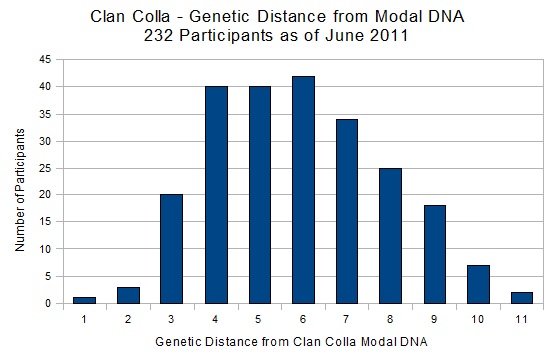
Distribution of people by genetic distance from Colla Modal STRs. For example, it shows that 40 people have a genetic distance of 4 from the Colla Modal. |
There are 26,796 possible comparisons among the 232 people: n*(n-1)/2, where n is the number of people. The genetic distances for these pairs range between 0 and 21. The average is 9.9. The total of such genetic distances up to 7 is 4,937, or 18% of the total possible matches. So, the matches that Colla people see are probably all fellow Collas, but only 18% of the total. If FTDNA were to raise the limit to 10, people would see 57% of the total possible matches, but they might also see some non-Colla matches.
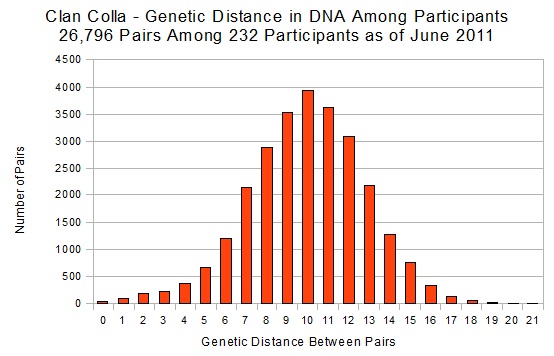
Distribution of genetic distances in STRs among participants. For example, it shows that 232 people have 2,161 genetic distances of 7 among themselves. |
FTDNA shows each participant his 67-STR matches up to a genetic distance of 7 on his homepage. And it allows participants to restrict the showing of their matches to the people in their surname project. The theoretical 67-marker match experience (within a genetic distance of 7) varies considerably by individual, from 1 to 145. The average is 43. The person with 145 theoretical matches has only 94 showing on his homepage at FTDNA because some participants restrict display of their matches to the people in their surname project. Another person has a theoretical 33 but actually sees only 25 because of the restrictors. Yet another person has a theoretical 55 but actually sees only 45 because of the restrictors.
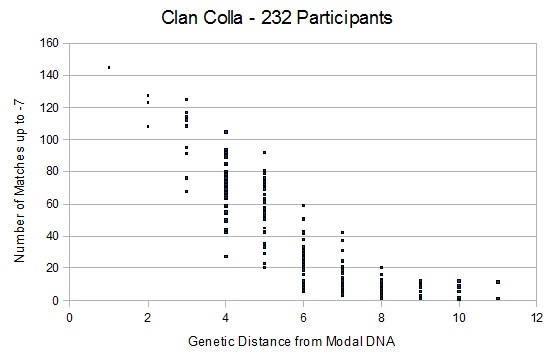
Scattergram of genetic distance from Colla modal and number of matches up to -7 for 232 people. For example, there is one person who has a genetic distance of 4 from the Colla modal and has 27 matches with genetic distance of 7 or less. Another with a GD of 4 has 105 matches. |
As indicated above, the genetic distance between the Colla Group testers and the 67-STR Colla Modal DNA ranges between 1 and 11. The table below shows the percentage ditribution of genetic distances at 67 markers and for lesser markers.
| Percentage Distribution of 232 Colla Participants by Genetic Distance |
Genetic
Distance |
STRs Tested |
| 1-12 |
1-25 |
1-37 |
1-67 |
| 0 |
24% |
6% |
0% |
- |
| 1 |
33% |
18% |
3% |
0% |
| 2 |
32% |
32% |
8% |
1% |
| 3 |
9% |
24% |
18% |
9% |
| 4 |
1% |
13% |
19% |
17% |
| 5 |
1% |
6% |
22% |
17% |
| 6 |
- |
1% |
11% |
18% |
| 7 |
- |
1% |
10% |
15% |
| 8 |
- |
- |
5% |
11% |
| 9 |
- |
- |
2% |
8% |
| 10 |
- |
- |
- |
3% |
| 11 |
- |
- |
- |
1% |
| Total |
100% |
100% |
100% |
100% |
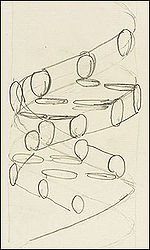
First sketch of the deoxyribonucleic acid double-helix pattern in 1953 by Francis Crick. |
Null Value for STR 425. All Colla participants by study design have taken the 67-marker test conducted by FTDNA. The 48th marker in the 67-marker test is marker 425. A null value for marker 425 separates the Colla Group from most others in the DF21 reference group. (The 47th, 76th, and 91st markers also separate Clan Colla: 511=9, 505=9, 441=12.)
Until it was stopped in 2019, a special test, called the DYF371X test, was offered for those who have the null value for marker 425.
A Null 425 DNA project was set up in 2008. As of January 1, 2014, the DYF371X test had been done for 51 members of the Clan Colla project: 49 have subvalues of 10c-12c-13c-14c and two (closely related) have a variant of 10c-12c-14c-14c. Of the 51, 31 had joined the Null 425 project.
As indicated by the Null 425 DNA project and the DF21 project, there are several people with DF21 DNA who have the null 425 but are not Clan Colla. They are missing the other three key markers: 511=9, 505=9, and 441=12. They have 67-marker genetic distances of 19-20 from the Clan Colla modal instead of 1 to 11, the range for Colla members. They do not have Colla names: Denman, Furgeson, McCloud. Like Clan Colla, they have DYF371X subvalues of 10c-12c-13c-14c. One, McCloud, has tested for Z3000 and is negative.
There have been people who match the Colla Group but do not have a null value for marker 425. According to FTDNA, the null 425 can be very difficult to identify. When one of these cases arises, FTDNA has retested, and the null value is finally identified.
The event which causes the null 425 result is a Recombinational Loss of Heterozygosity (recLOH). This type of mutation is more frequent than a SNP mutation, but less frequent than a STR mutation.
It is very unlikely that a null value would ever be reversed.
Although the null 425 is fairly rare, there are groups other than Clan Colla that have the null 425. As of January 2014, there were 29 of these groups identified in the Null 425 DNA project. The major ones are shown in the table below.
| Haplogroup | N | Genetic Distance
from 67-Marker Haplogroup Modal
Mean (Low-High) | DYF371X | DYF371X Variants | FTDNA Project |
|---|
| E-M35 |
1,382 |
28.1 (7-51) |
10c-10c-13c-13c |
10c-10c-11c-13c
10c-10c-13c
10c-10c-13c-13c-13c
10c-10c-13c-14c
10c-11c-13c-14c |
E-M35 project |
| R-L21, DF21, Z3000, Clan Colla |
341 |
6.1 (1-15) |
10c-12c-13c-14c |
10c-12c-14c-14c |
R-Z3000 project |
| I-M223, M284 "Isles" |
241 |
11.7 (1-36) |
10c-10c-13c-13c |
10c-12c-12c-12c |
R-M223 project |
| R-U106, L48, Z326 |
56 |
12.6 (5-19) |
10c-10c-13c-14c |
10c-10c-13c-13c
10c-10c-13c-15c
10c-10c-14c
8c-10c-13c-14c |
R-U106 project |
|
R-M269, L21, and DF21 SNPs
Z3000 Ancestors. The Z3000 SNP for Clan Colla is descended from five well-known SNPs:
- M343 - 17000 BC - Uzbekistan
- M269 - 4450 BC - Southwestern Russia
- L21 - 2650 BC - Southern England
- DF13 - 2500 BC - Northern England
- DF21 - 2350 BC
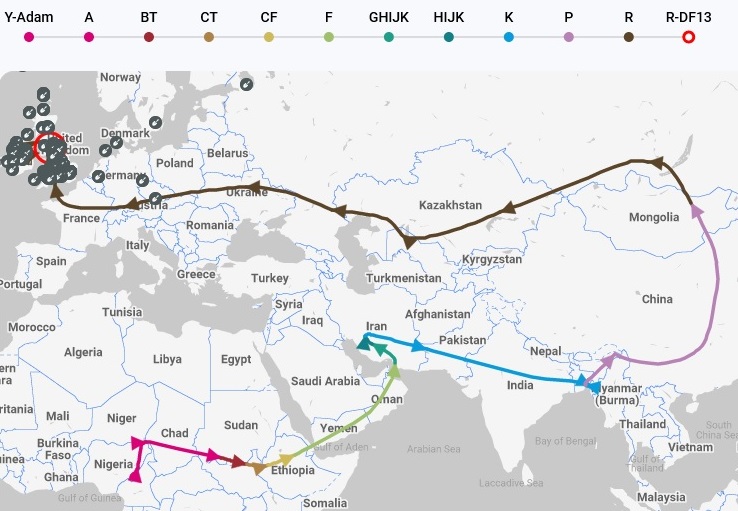
DF13 Map. The Estimated Migration Route of from A-PR2921 in Africa in 232000 BC to R-DF13 in Northern England in 2500 BC. |
Any tester with Clan Colla DNA who has tested STRs but has not done SNP testing or Family Finder is predicted by FTDNA to have the M269 SNP. The M269 SNP is the most common European haplogroup, greatly increasing in frequency on an east to west gradient. Its prevalence in Poland is estimated at 22.7%, compared to Wales at 92.3%. See: Haplogroup R-M269. A real rough estimate of the year M269 was born is 4350 BC, based on FTDNA Discover. M269 is descended from M343, which is also refered to as the R1b haplogroup. There is an M343 Project at FTDNA.
Join Projects. Participants in the Clan Colla project are urged to join five FTDNA projects:
DF13 Descendants. Using data prepared by Alex Williamson based on data from Michael Walsh in August 2012, Patrick McMahon has added data on Clan Colla and created the following graph showing the descendancy of many of the SNPs outlined in the table above. It shows, for example, that Clan Colla first appeared about 2000 years ago and DF21 first appeared about 3000 years ago. The arrows indicate measures of uncertainty. The numbers under the SNP are sample sizes and the labels indicate associated haplogroups (where known). The horizontal space is for separation of lines and labels.
|
Matching Sets of 20 Names
Identification of the Y-DNA of The Three Collas, who lived on 4th century Ulster, rests upon the similarity between 1 and 2:
1. a set of 20 surnames in the ancient genealogies of The Three Collas and
2. a set of 20 surnames among 232 testers out of a total of 466 with the Y-DNA SNP (single nucleotide polymorphism) called R-Z3008.
It also rests upon the pedigrees of 7 McDonalds who trace their ancestry back to Lt. Brian McDonald, McDonnell of Antrim, Somerled, and Colla Uais in 43 Generations: Colla to McDonald and 2 McMahons who trace their ancestry back to Colla da Crioch in 50 Generations: Colla to McMahon. (The kit numbers of these testers are in bold below.)
1. Surnames in the
Ancient Genealogies of
The Three Collas | 2. Surnames of 232 FTDNA Testers with Z3008 SNPs as of October 2020. See also: Y-67 STR Genetic Distance |
|---|
| Z3008 SNPs | Surname | N | Kit Numbers with Actual SNPs | Kit Numbers with Predicted SNPs |
|---|
|
| Cooley, O'Hart 453 | BY3163>BY38665 | Cooley | 3 | 140728, 358156 | 136625 |
| MacKenna, chiefs of Truagh in Monaghan, O'Hart 543 | BY3163>BY3172 | McKenna | 23 | 21156, 900384, B330469 | 440779, 332756, 254557, 6419, 64767, 64768, 64771, 65962, 67837, 100576, 150811, 156103, 171658, 194128, 261105, 274040, 430800, B23604, 261105, 68390 |
| Nealan, Neillan, O'Hart 604 | BY3163>A14075 | Neal | 3 | 7207 | 7206, 181440 |
|
| Connolly, O'Hart Vol. II 577 | S953>BY2869 | Connolly | 17 | 906137, 791222, 841026, 263699, 328903, 78625 | 84262, 342831, H2133, 156389, 338710, B19040,
N88161, 864296, 169972, NYB0X, 311107 |
| Boylan, O'Hart Vol. II 577 | S953>BY24138 | Boylan | 7 | 428117, 456444 | 65227, 86258, 274975, 118214, N50500 |
| Larkin, O'Hart 513 and 514 | S953>BY103517 | Larkin | 3 | L-0088, L-0121, L-0128 | |
| Maguire, O'Hart 576 | S953>A945 | McGuire | 12 | 222108, 32277 | 20871, 21218, 23171, 33735, 111694, 113714, 146421, 183025, 381343, N7273
|
| McDonald, 43 Generations: Colla to McDonald | S953>FT112238>BY3158 | McDonald | 22 | 367328, 617821, 278275, 28300, 144688, 438540, 450856, 890080, 934379 | 38885, 133546, 146160, 450623, 612492, 13758, 112197, 124947, 196960, 294097, 836790, 395753, 521910 |
| S953>FT112238>BY3249 | McDonald | 14 | 412502, 917180, 442638, 156049, 423680, | 917290,
129206, 230163, 90727, 319883, 187107, DIOSM, DWXBQ, 325197 |
|
| MacDougall, O'Hart 539 | F4142>BY84346 | MacDougall | 4 | 867968, 21971, 551166 | 144808 |
|
| O'Hart, O'Hart 664 | A14079>BY3179 | Hart | 5 | 182999, IN59707, IN60255, 166797 | 48620 |
| Monaghan, O'Hart 639 | A14079>A14086 | Monaghan | 8 | 303542, 237073, 485973, B89280 | 465596, 110455, 295403, 922775 |
| Higgins, O'Hart 669 | A14079>A14086 | Higgins | 4 | 64895 | 70725, 187205, 215402 |
|
| O'Kelly of Ulster, O'Hart 671 | FT14355>FT238740 | Kelly | 5 | 107942, xxxxx | 73887, 237995, 283030 |
| McArdle, O'Hart 669 | FT14355>Y134213 | McArdle | 4 | 902318 | 144005, 790697, 99317 |
| MacHugh, O'Hart 542 | FT14355>BY93161 | Hughes | 8 | 7996, B397573, 322443, 696167 | 200241, 274095, 409612, 505894 |
| McMahon, 50 Generations: Colla to McMahon | FT14355>Z16280 | McMahon | 43 | 797200, B2743, 896752, 578104, 327949, 177680, B96581, 145687, N174002, 391373, N83765, 355806, N65214, 451391, 426339 | 14876, 183423, 272307, 291136, 461464, 52246, 463817, 456102, 629733, 391033, 411747, 29288, 34826, 69356, 156881, 197862, 210649, 229945, 281505, 295755, 315990, 353939, 365338, 506637, 561475, 683997, 79554, B402649 |
| O'Carroll, O'Hart 672 | FT14355>BY149477 | Carroll | 3 | 377949, 31491 | N71810 |
| MacQuillian, O'Hart Vol. II 578 | FT14355>BY3166 | McQuillan | 8 | 82960 | 448648, 170471, N23748, 392973, 323456, 395707, 145804 |
| O Duffy, O'Hart 670 | FT14355>FGC41930 | Duffy | 17 | 856428, 100022, 241903, B560342, 28253, MI47859, B148242, 509129, 381560, 415715, 420795, 572002, 801661 | 857571,
98477, 231542, N81681 |
| MacDonnell of Clankelly, O'Hart 536 | FT14355>BY39831 | McDonald | 17 | 40141, 719704, 541431, 270994, 528900 | 334694, 16694, 68473, 140815, 169145, 205044, 93F4C, 618122, 923463, OMPW5, 420917, B3331 |
| Davin, Devine, O'Hart 403 | FT14355>BY39829 | Devine | 2 | | 51491, 117316 |
Maps of 20 Matching Names in Griffiths Valuation. The 20 surnames, in order of prevalence, are: 53 McDonald, 43 McMahon, 23 McKenna, 17 Connolly, 17 Duffy, 12 McGuire, 8 Monaghan, 8 Hughes, 8 McQuillan, 7 Boylan, 5 Hart, 5 Kelly, 4 MacDougall, 4 Higgins, 4 McArdle, 3 Cooley, 3 Neal, 3 Larkin, 3 Carroll, 2 Devine. Following are maps of the prevalence of households with these surnames in the 1847-1864 Griffiths Valuation. Source: John Grenham. All names are found in Ulster.
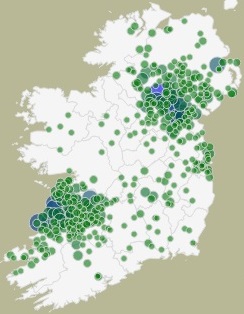
Griffiths McMahon Map |
|
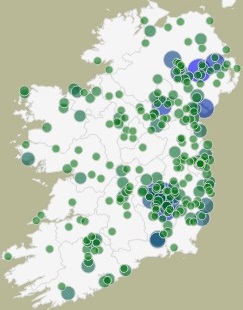
Griffiths McDonald Map |
|
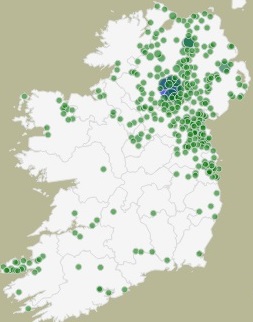
Griffiths McKenna Map |
|
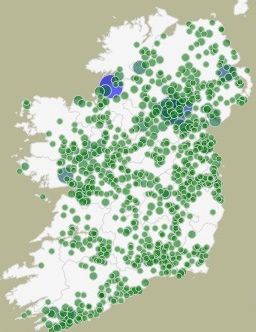
Griffiths Connolly Map |
|
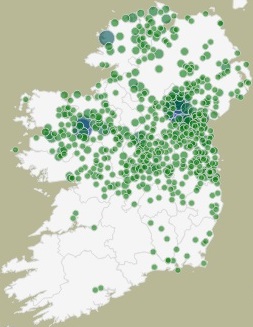
Griffiths Duffy Map |
|
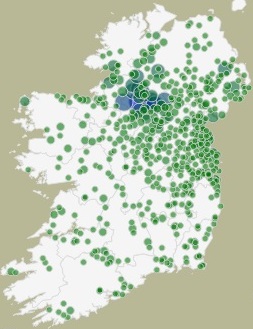
Griffiths Maguire Map |
|
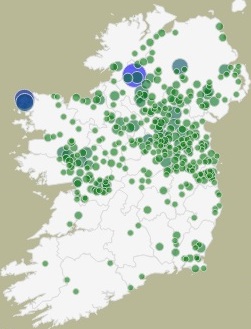
Griffiths Monaghan Map |
|
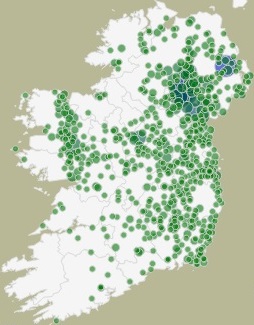
Griffiths Hughes Map |
|
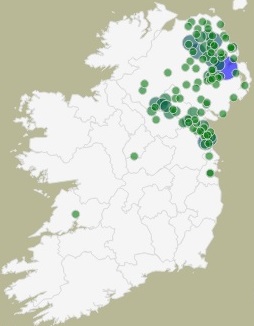
Griffiths McQuillan Map |
|
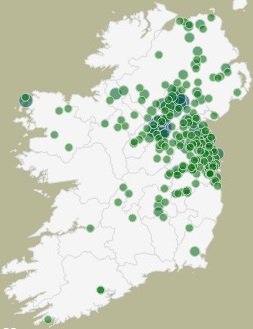
Griffiths Boylan Map |
|
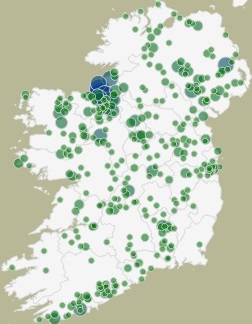
Griffiths Hart Map |
|
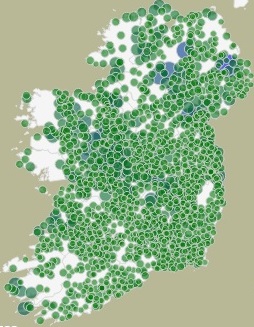
Griffiths Kelly Map |
|
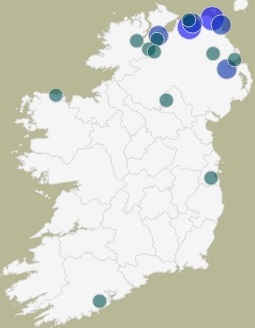
Griffiths McDougal Map |
|
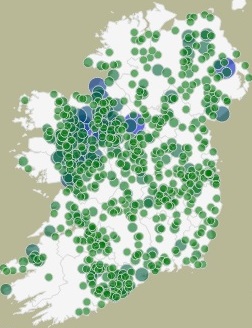
Griffiths Higgins Map |
|
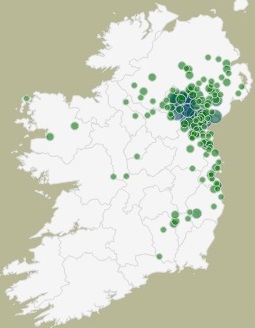
Griffiths McArdle Map |
|
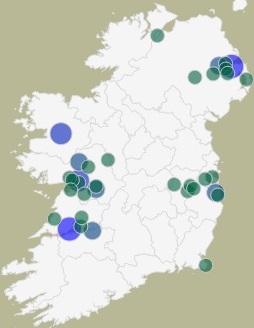
Griffiths Cooley Map |
|
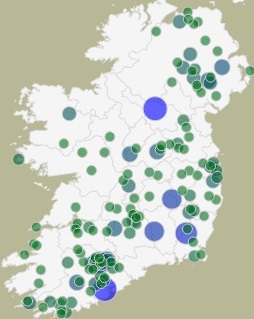
Griffiths Neal Map |
|
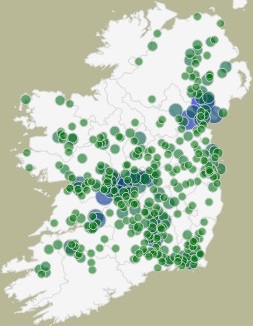
Griffiths Larkin Map |
|
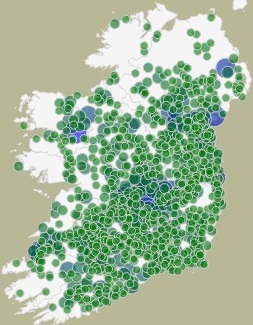
Griffiths Carroll Map |
|
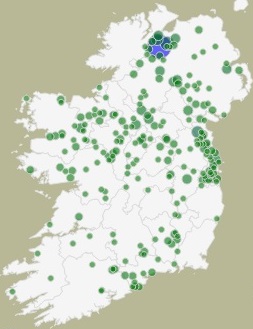
Griffiths Devine Map |
|
Many testers with Clan Colla DNA do not have historical surnames. The major names are: McGinnis, McGroder, Østerud, King, Martin, Beggan, McAuley, O'Hara, White, Collins, Glennon, Murphy, Clarke, McGinn, Murray, Waters. Clan Colla DNA has not yet been found for many Clan Colla names. See Historical Surnames.
Many testers do not have Z3008 Y-DNA. They are descended from cousins of The Three Collas, as shown in the first six columns of the following Abridged Clan Colla Big Y SNP Tree. They have a mixture of English and historical Clan Colla surnames. See: Origin of The Three Collas.
|
Two Ancient Genealogies
| Uais | da Crioch |
|---|
| Z3008, 450 AD, 809 tseters |
| S953, 500 AD, 288 testers | |
| ZZ13, 600 AD, 82 testers | FT14355, 600 AD, 235 testers |
| | Z16274, 700 AD, 191 testers |
| FT14481, 750 AD, 73 testers | Z16276, 750 AD, 174 testers |
| A938, 800 AD, 48 testers | Z16278, 800 AD, 170 testers |
| FT112238, 900 AD, 37 testers | BY20667, 900 AD, 149 testers |
| | Z16277, 1000 AD, 147 testers |
| | Z16275, 1150 AD, 130 testers |
| | A77, 1200 AD, 46 testers |
| | Z16280, 1350 AD, 40 testers |
| BY3158, 1700 AD, 23 testers | |
| A14093, 1750 AD, 8 testers | BY115195, 1750 AD, 2 testers |
| 7 McDonald testers | 2 McMahon testers |
Nine R-Z3008 testers have connected their genealogies with ancient genealogies of The Three Collas: 7 McDonalds and 2 McMahons. They happen to have the two most common surnames.
The table shows the SNPs of each of the two ancient genealogies from 450 AD to 1750 AD.
The two genealogies go back to separate Colla brothers. The most recent shared SNP of testers with the two separate genealogies is Z3008. This lends credence to the argument that Z3008 is the SNP of The Three Collas. If the father of The Three Collas did not have the Z3008 SNP, the two sons would not both have Z3008.
According to ancient history, the two Colla brothers lived in the 4th century, yet the SNPs start at 450 AD. This could be explained by the fact that the dates of the SNPs are rough estimates. They could easily be off by 100 or 200 years. It could also be explained by possible error in the ancient history.
|
43 Generations: Colla to McDonald
Six of our McDonald 1 subgroup can trace their ancestry back to Lt. Brian McDonald (MacDonnell), born in 1645 in Arklow, County Wicklow, and then back to Alasdair Og, Somerled, and Colla Uais. The first to do this was Frank Everett McDonald, Jr., a retired dairy farmer from the Blue Ridge Mountains of Virginia. He was born there in 1926, had his Y-DNA tested in 2008, and died in 2014. His FTDNA kit is #133546. The genealogy of Frank Everett McDonald, Jr., was brought to our attention by Vaden McDonald, who is unrelated (Vaden has R1b-CTS4455 DNA). Since then, Elbert Leo "Mick" McDaniel III, a member of our McDonald 1 subgroup, has found five other McDonald testers. Paul Duffy has provided valuable information on the McDonalds of Antrim and Leinster. Donald Schlegel has been most helpful in connecting the Frank Everett McDonald's genealogy with Colla Uais.
Ancestors of 7 Testers in the McDonald 1 Subgroup
Interspersed with the Y-DNA mutations, called SNPs (single nucleotide polymorphisms), of the 7 McDonald Big Y Testers
- Carrell Colla Uais, brother of Muredach Colla da Chrioch and Aedh Colla Menn; Muredach Tirech, king of the Connachtach, sent the Collas against his ancient enemies, the Ulaid; over an extended period of perhaps eighty years, the Collas and their descendants fought several battles against the Ulaid and took other lands from them, while remaining subject to the descendants of Muredach Tirech
- Erc: his son. Had two brothers: 1. Brian; 2. Fiachra Tort; called "ri sliab a tuaid," king of the
northern mountain; had three sons: Carthend, Fiachra, and Amalgad
- Carthend: his son; Carthend was given land east of the present city of Derry on the east side of the Foyle, the valley of
the River Faughan, then called Dulo Ocheni but later named Tir-Keeran (Carthend's land) after him,
and still today bearing that name as a barony; subject to the Kings of Ailech, who were descendants of Eoghan and Conal
Gulban, the sons of Niall of the Nine Hostages; had six sons by one or more wives and another six by bondswomen
- Muredach, his son
- Amalgad, his son
- Aed Guaire, his son
- Colman Muccaid, his son
- Fergus: his son; died in 668
- Conal, his son
- Niad, his son
- Fergus, his son
- Goffrad: his son; left by Kenneth MacAlpin in the west to try to hold the isles against the Northmen. He was
styled toiseach, (prince) of Insi-Gall (all of the Hebrides); died in 853
- Maine: his son
- Niallgus: his son
- Suibhne: his son
- Meargagh (or Marcus): his son
- Solamh (or Solomon): his son
- Gille Adamnan: his son
- Gille Bride: his son; had a sister Behag who married Harald-Gille, King of Norway
- Somerled: his son; Thane of Argyll, the patriarch of this family, early in the 12th century acquired the Western Islands, by his marriage with Effrica, daughter of Olavus, King of Man; and assumed the designation of King of the Isles, which his successors held, independent of the Scottish Kings, for three generations; died in 1164.
- Reginald: his son; born about 1148 in Morven, Argyll, Scotland; 2nd Lord of the Isles; married Fiona Moray from in Galloway; known as a benefactor of the Abbey of Paisley; credited with founding Cisterian Monastery; died in 1207 in Kintyre, Argyll, Scotland
- Donald: his son; 3rd Lord of the Isles; married Princess Margaret Stuart, granddaughter of King Robert the Bruce; died in 1249
- Angus Mór MacDonnell: his son; first to use the surname of MacDomhnall; in 1256 King Henry III of England commanded his bailiffs and subjects in Ireland not to allow Angus Mor MacDonnell, or other Scottish males to be received in Ireland; married Campbell; died in 1301
- Alasdair Og MacDonnell: his son; ancestor of all the MacDomhnaill Gallóglach families; in 1286 he attended the meeting in favor of the elder Bruce and against the succession of the Maid of Norway at Turnberry; in 1291 offered the oath of allegiance to the English King who at that time was seeking to make Scotland an English province; in 1292 a safegard was given to him on behalf of the family for the purpose of commerce in Ireland; Edward I appointed him High Admiral of Western Seas and ballie of part of Kintire; married Margaret O'Cathan; died 1308
- Somerled (Sorley) MacDonnell: his son; died 1387
- Marcus MacDonnell: his son; assumed tile role of commander of O'Connor's Galloglachs when his brother, Donald Og MacDonnell was slain in 1388; died 1397
- Charles Thurlough Mor McDonald: his son; born in Antrim; acquired lands being known as the Clan Donnell Country, including Tynekill Castle at the base of the boundary of the mountains of Leix and Wicklow; died 1435
- John Carrogh (Thirlough Oge) McDonald: his son; born in Leinster; died 1466 in Talbotstown, Wicklow
- Charles (Thurlough) Og McDonald: his son, head of the house of Tennekill during the later half of the fifteenth century; fell upon the field of battle in 1503 when Clan Donald of Leinster was at war with the Burkes of Mayo
- John McDonald: his son; born in Leinster, Ireland; died 1514
- Charles Turlough McDonald: his son; born 1500 in Tennekill, Queens County; died 1522 in Leinster
- Calvagh MacTurlough McDonald: his son; died 1570
- Hugh (Aodh) Buidhe McDonald: his son; married Mary Moore; succeeded to the Tinnekill estate upon his father's death; died 1618. See A Poem to Aodh Buidhe and Alasdar Mac
Domhnaill of Tinnakill, Queen's County
- Brian MacDonnell: his son; born in Tynekill Castle, Queens County, Leinster in 1577; died in the Castle about 1635; his brother Fergus MacDonnell assumed the position as head of the Tennekill family upon the death of their father; Fergus was loyal to the English and died in 1637
- Alexander MacDonnell: his son; born about 1613 in Leinster; married Helena Archbold; was Constable of Wicklow County; died in 1683 in Wicklow County; buried in the Presbyterian Cemetery in Wicklow
- Brian MacDonnell: his son; assumed the name MacDonald; married Mary, daughter of John Doyle, of Arklow, County Wicklow; engaged in the tanning trade; Lieutenant in Colonel Francis Toole's regiment in the cause of King James II of England; emigrated to America in 1689, with his wife and five children: 1. John, 2. William, 3. James, 4. Brian, 5. Mary; settled in Mill Creek Hundred, New Castle Co., Delaware, U.S.A.; had two more children: 6. Richard, 7 Anabel; bought 693 acres of land from William Penn in 1689 occupied now by some housing and Brandywine Springs Park bordered by Red Clay Creek and Hyde Run; died in 1707
|
37. John McDonald. Born 1679 in Wicklow. Moved in 1689 to New Castle, DE. Married Mary Robinson. Moved to Big Springs, Cumberland County, PA. Died 1762
38. John McDonald. Born 1719 in Mill Creek Hundred, New Castle, DE, Married Mary Thompson. Moved to Cumberland County PA, then to Old Augusta County VA, and finally to Fayette County, PA. Died 1786
39. Isaac McDonald, Born 1742 in Mill Creek Hundred, New Castle, DE, Married Mary Middlecoff. Settled in Fayette, PA. Died 1797
40. Abner McDonald. Born 1792 in Fayette, PA, Married Sarah Sutton. Died 1845
41. Abner McDonald. Born 1828 in Fayette, PA. Married Cecelia Smith. Died 1874
42. Eugene Spencer McDonald, Born 1855 in WI. Married Sabina R. Steuert, Died 1926
43. Guy Steuert McDonald. Born 1880 in WI. Married Mabel Grace Wright. Died 1961
44. Guy Kenneth MacDonald. Born 1909 in WI, Married Margaret Haner. Died 1992
45. Donald Wright MacDonald, FTDNA kit #890080
|
37. Bryan II McDonald. Born 1686. Moved in 1689 to Mill Creek Hundred, New Castle County, Delaware. Married Catherine Robinson in 1715, and had five sons and four daughters. The sons were: 1. Richard, born 1716; 2. James, born 1718; 3. Edward, born 1720; 4. Joseph, born 1722; 5. Bryan, born 1732. The daughters were: 1. Rebecca, born 1724; 2. Catherine, born 1727; 3. Mary, born 1730; 4. Priscilla, born 1734. Moved, about 1745, to Augusta Co. (Botetourt Co. after 1770), Virginia. Died 1757
|
38. James McDonald. Born 1718 in Mill Creek Hundred, New Castle Co., Delaware. Married Catherine Justis in 1744 in Mill Creek Hundred. Died 1791 in Wythe, Virginia.
39. Magnus McDonald. Born 1750 in Buffalo Creek, Augusta Co. (Botetourt Co. after 1770), Virginia; married Tabitha Morris in 1788. Died 1809 in Wilson, Tennessee
40. Andrew Jackson McDonald. Born 1792 in Wythe, Virginia; married Lucinda Nelson in 1850. Died 1863 in Wilson, Tennessee
41. Benjamin Franklin McDonald. Born 1859 in Wilson, Tennessee. Married Virginia Allen. Died in 1941.
42. Lillard Thompson McDonald. Born 1888 in Wilson, Tennessee. Married Josie Lee Mitchener in 1911. Died in 1918 in Long Hollow Pike, Sumner, Tennessee.
43. Lewis Thompson McDonald. Born 1916 in Gallatin, Tennesee. Married Mary Helen Gibson. Died 2004 in Wilson, Tennessee.
44. Lewis Terry McDonald. Born in 1942 in Wilson, Tennessee. Married Susan Cheryl Huntsberger in 1964 in Wilson, Tennessee.
45. C. Brian McDonald. FTDNA kit #395753 |
38. Joseph McDonald. Born 1722 in Mill Creek Hundred, New Castle Co., Delaware; married Elizabeth Ogle. American Revolutionary War Veteran. Left Boutecourt County and settled in Draper's Meadows on Toms's Creek, near
Blacksburg, Montgomery County, Virginia. Died 1809 |
38. Bryan McDonald III. Born 1732 in Mill Creek Hundred, New Castle Co., Delaware. Married Susannah Ogle in 1752 in Wilmington, Delaware. Died 1777 in Buffalo Creek, Botetourt County, Virginia.
39. George McDonald. Born 1767 in Buffalo Creek, Augusta Co. (Botetourt Co. after 1770), Virginia; married Ruth (Davis) Owen in 1803. Died 1815 in Botetourt County, Virginia
40. Edward McDonald. Born 1812 in Montgomery County, Virginia; married Catherine Sesler. Died 1882 in Montgomery County, Virginia. Edward and brother George lived on Father's farm at McDonald's Mill near Blacksburg, Montgomery County, Virginia. They were farmers, millers (established the first grist mill at McDonalds Mill) and ran a tan yard for hides and leather
41. George Thomas McDonald. Born 1839 in Craigs Creek, Montgomery, Virginia. Married Matilda Jane McCulloch in 1875.
42. Frank Everett McDonald. Born 1895. Married Carolyn Bush in 1920 in Vinton, Roanoke Co, Virginia. Died 1987.
43. Frank Everett McDonald, Jr. Born 1926. Married Betty Jean Verna in 1951. Died 2014. FTDNA kit #133546 |
| 39. Bryan McDonald of Montgomery, Virginia. Born 1757. Married Mary Bane. Died 1802 |
39. William McDonald of Montgomery, Virginia. Born 1765. Married Ursula Huff. Died 1828.
40. Dr. Jonathon McDonald of Virginia and Alabama, Born 1806. Married Mary Briggs Malone. Died 1866.
41. Thomas James McDonald of Alabama. Born 1836. Married Margaret Simpson. Died 1903.
|
40. Bryan McDonald of Virginia. Born 1784, Married Rebecca Hoofman. Died 1863.
41. Howard H. McDonald of Virginia. Born 1826. Married Elvira Hambrick. Died 1865.
42. James Duget McDonald of Virginia. Born 1863. Married Nancy Myrtle Artrip. Died 1947.
43. James Howard McDonald of Virrginia. Born 1904. Died 1979.
44. Bobby L. McDonald. Born 1928. Died 1985.
45. James L. McDonald, FTDNA kit #367328
|
40. John Edward McDonald of Virgina. Born 1800. Married Elizabeth Henderson. Died 1861.
41. Bolivar "Bud" McDonald of West Virginia. Born 1842. Married Mary Magdalene Gartin. Died 1926.
42. Lewis Scott McDonald of West Virginia. Born 1870. Married Mary Elizabeth Neely. Died 1960.
43. Orville Clyde McDonald of West Virginia. Born 1911. Married Irene Hester Mooney. Died 1986.
44. Orville Edward McDonald, FTDNA kit #38885
|
42. Joseph Simpson McDonald of Alabama. Born 1883. Married Eva Looney. Died 1941.
43. Kyle Wesley McDonald of Alabama. Born 1908. Married Lucile Hacker. Died 1975.
44. William H. McDonald, FTDNA kit #617821
|
42. John Wesley McDonald of Alabama, born 1891. Married Lulu Teague. Died 1990.
43. James Norman McDonald Sr. of Alabama, born 1943. Married Julia Goodwin.
44. William S. McDonald, FTDNA kit #986777
|
Sources. Any genealogy that goes back 16 centuries is not going to be as solid as one that goes back two or three centuries. Nevertheless, we think the attempt is worthwhile. You can judge for yourself. Sources for the 43 generations are as follows.
- Generation 1 to 20: The Ancestors of the McDonalds of Somerset, by Donald M. Schlegel, 1998. Sources consulted by Schlegel include: Book of Ballymote (ca 1400), Book of Lecan (Early 1400s), Nat. Lib. Scot. MS 72.1.1 (1467), Monro (1549), Harleian MS 1425/190-191 (ca 1620), Annals of Clan Macnoise (1627), Geoffrey Keating (ca 1634), O'Clery (mid 1600s), and Book of Clanranald (ca 1715). Also see The Three Collas - An Alternative Explanation.
- Generation 20 to 36: The MacDonnell Family of Leinster,
1100 AD to 1707, Irish Midlands Ancestry, compiled by the Family History Centre, Bury Quay, Tullamore, County Offaly, Ireland
- Generation 1 to 33: Leinster Clandonnells; the Queen Majestie’s Galloglass, Wilde Irishe Blog, May 22, 2020.
- Generation 1 to 33: The Clan Donald, by Rev. Angus Macdonald (1860-1932) and Rev. Archibald Macdonald (1853-1948), Volume III, 1904, pages 173 to 180.
- Generation 36: Contributions to the Early History of Bryan McDonald and Family , 1879, by Frank V. McDonald
- Generation 36 to 40: Kegley's Virginia Frontier, by F. B. Kegley, 1938 (or selected pages)
- Generation 25 to 43: Genealogy of Frank Everett McDonald, Jr. by Vaden McDonald, 2007.
- Generation 39 to 43 for Frank Everett McDonald, Jr.: 1820-1930 U. S. Censuses:
- Buffalo Creek, Botetourt County, Virginia: 1820 for generations 39 (widow Ruth) and 40
- McDonalds Mill, Montgomery County, Virginia: 1830 for generations 39 (widow Ruth) and 40
- McDonalds Mill, Montgomery County, Virginia: 1840-1, 1840-2, 1850, 1860, 1870, and 1880 for generations 40 and 41
- Salem, Roanoke County, Virginia: 1880 for generation 41
- Chamblissburg, Bedford County, Virginia: 1900, 1910, and 1920 for generations 41 and 42
- Roanoke Creek, Big Lick District, Virginia: 1930 for generations 42 and 43
We are indebted to Elbert Leo "Mick" McDaniel III, who has assisted fellow members in their genealogical research. Mick has more detail in his Bryan McDonnell Descendants. All have or are are predicted have the SNP BY3158/A939. All have STRs 437=14 and 446=14, instead of the Colla modal of 437=15 and 446=13.
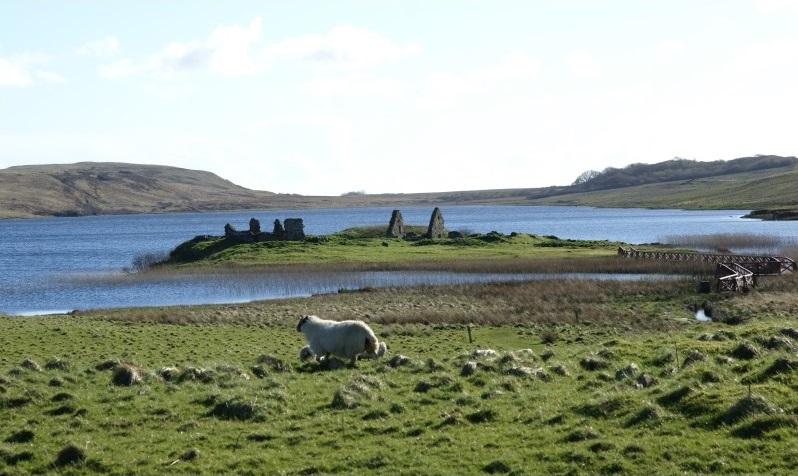
Generation 20-24. Blackface sheep and Finlaggan ruins on Eilean Mòr (Great Isle) in Loch Finlaggan, Islay, Argyll, Scotland. Finlaggan was the seat of the Lords of the Isles under The Clan Donald. The ruins we see today are from a castle built in the 13th century, with masonry walls, by Someled's descendants 21-24: Reginald, Donald, Angus Mor, Alasdair Og. An earlier construction, likely timber, was erected in 1138 by Somerled. Source: Lords of the Isles. |
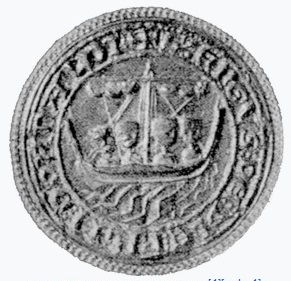
Generation 23. Seal of Aonghus Mór. Source: Aonghus Mór The legend reads:
"S' ENGVS DE YLE FILII DOMNALDI" |
|
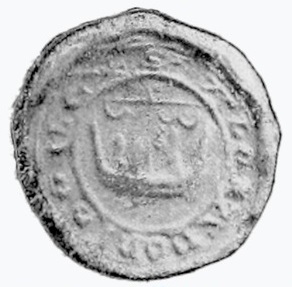
Generation 24. Seal of Alasdair Óg of Islay. Source: Alasdair Óg of Islay, The legend reads:
"S' ALEXANDRI DE ISLE" |
|
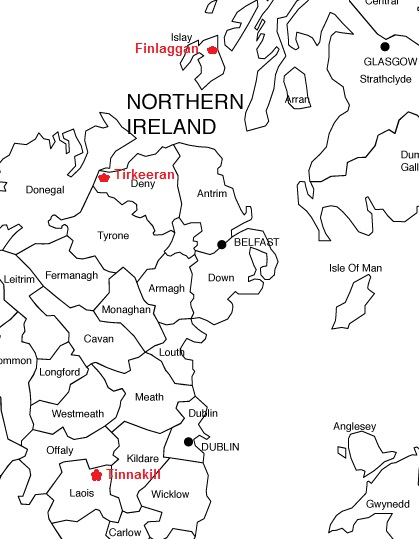
McDonald 1 Map. Faughan River in Tirkeeran in County Derry. Finlaggan Castle in Islay, and Tinnakill Castle in County Laois. |
|
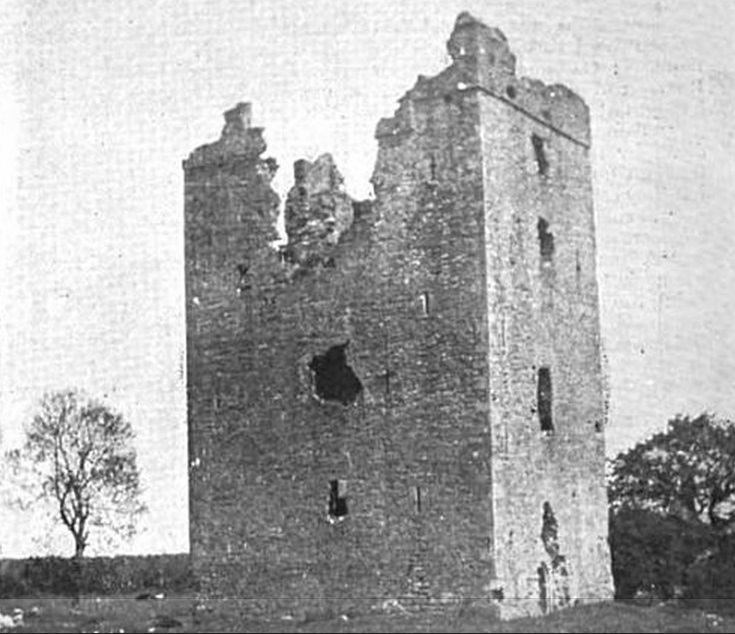
Generation 27-34. Tinnakill Castle, 1903 photo. Also known as Tynekill, A ruined medieval tower house in the parish of Coolbanagher, in the Barony of Portnahinch, County Laois, Ireland. The last McDonnell to hold Tinnakill was James McDonnell, from whom the site was seized following his role in the Irish Rebellion of 1641 |
|
Inferences for Other Colla Uais Subgroups. Ancient ancestors of the McDonald 1 subgroup are probably shared by testers in certain Colla subgroups. We do not know what ancestors were born with what SNPs, but we can make a guess based on
- ancient ancestry dates put together by various Gaelic scholars and
- the roughly estimated dates of SNPs by Family Tree DNA.
Following is a SNP tree for Colla Uais, interspersed with the ancient genealogy of the McDonald 1 testers who can trace their ancestry back to Colla Uais. The blending of the ancient genealogy and SNP tree is rather arbitrary because of the uncertainty of ancestral genealogy and SNP dates. Testers other than McDonald 1 testers share the McDonald 1 genealogy before the latest shared SNP. For example, Beggan testers with the BY3164 SNP share the FT14481 SNP with McDonald 1 testers. If the ancient ancestry dates have been properly blended with the SNP dates, the Beggan testers share the McDonald 1 ancestors who lived before FT14481: ancestors 1 to 8 of the McDonald 1 genealogy. The earlier the ancestor the greater the confidence in the sharing. One of the earlier ancestors is Carthend who lived in Tirkeeran.
Colla Uais SNP Tree, with a McDonald 1 Genealogy
| Z3008 450 AD England
1. Colla Uais, fought in battle in 392 in Ulster
|
| S953 500 AD Tirkeeran
2. Erc
3. Carthend, lived in Tirkeeran on Faughan River
|
F4142
500 AD
MacDougall
White |
Y9053
1600 AD
Østerud |
BY2869
1050 AD
Connolly |
ZZ13 600 AD
4. Muredach
5. Amalgad
6. Aed Guaire
7. Colman Muccaid
8. Fergus: died in 668
|
BY24138
700 AD
Boylan |
FT14481 750 AD
9. Conal
10. Niad
11. Fergus
|
BY3164
1400 AD
Beggan |
BY39827
1250 AD
McAuley
O'Hara |
BY103517
1400 AD
Larkin |
A945
1200 AD
BY43421
1750 AD
McGuire |
A938 800 AD
12. Goffrad: died in 853
|
| FT112238 900 AD
13. Maine
14. Niallgus
15. Suibhne
16. Meargagh (or Marcus)
17. Solamh (or Solomon)
18. Gille Adamnan
19. Gille Bride
20. Somerled: died in 1164
21. Reginald: born about 1148
22. Donald: died in 1249
23. Angus Mór: died in 1301
|
BY84773
1050 AD
King |
Martin |
| McDonald 1*
24. Alasdair Og: died 1308
25. Somerled (Sorley): died 1387
26. Marcus: died 1397 in Antrim
27. Charles Thurlough Mor: died 1435
28. John Carrogh; died 1466
29. Charles Og McDonald: died in 1503
30. John McDonald: died 1514
31. Charles Turlough McDonald: died 1522
32. Calvagh MacTurlough McDonald: died 1570
33. Hugh Buidhe McDonald: died 1618
34. Brian MacDonnell: died about 1635
35. Alexander MacDonnell died in 1683
36. Brian MacDonnell: emigrated
to America in 1689, died in 1707
BY3158 1700 AD Wicklow
37. Bryan II McDonald: born 1686
A14093 1750 AD Wicklow
|
McDonald 2
24. Clan Donald of Ulster?
BY3249
1250 AD
|
|
The Clan Donald
A major surname in the history of The Three Collas is McDonald. These McDonalds are part of The Clan Donald, which traces its ancestry back to the Scottish Highlands. Y-DNA testing has shown, however, that there are two different ancestries in The Clan Donald. About 20% are descended from Alastair Og and Colla Uais, and have Celtic Y-DNA. The remaining 80% are descended from Aonghus Og and have Viking Y-DNA.
- Alastair Og descendants have Colla Uais Y-DNA, which is Celtic
- The Clan Donald of Leinster
- The Clan Donald of Ulster
- Aonghus Og and John (the good John of Isla) descendants have Viking Y-DNA
- The Macdonalds of Clanranald
- The Macdonalds of Glengarry
- The Macdonalds of Dunnyveg and the Glens
- The Macdonalds of Keppoch
- The Macdonalds of Sleat
The line of descent from Colla Uais to Alastair Og includes a man named Somerled who rose in prominence to create the Kingdom of Argyll and the Isles. Somerled, therefore, had Colla Uais Y-DNA.
From 1896 to 1904, at the request of the Clan Donald Society, two Church of Scotland Ministers from the Scottish Highlands
wrote The Clan Donald. The authors were Rev. Angus Macdonald (1860-1932), Minister of Killearnan, and Rev. Archibald Macdonald (1853-1948), Minister of Kiltarlity. There are three volumes, and they are available online:
The following tables include a summary of genealogy from Volume III and history from Volume II. These are followed by a table showing the Y-DNA of testers descending from The Clan Donald.
The Clan Donald - Volume III Genealogy
Colla Uais - p. 173-174
•
•
•
Fergus - p. 177-178
Maine - p. 178
Godfrey - p. 178
Nialgus - p. 178
Suibne - p. 178
Mearrdha - p. 178
Solaim - p. 178
Gilledomnan - p. 178
Gillebride - p. 178-179
Somerled - p. 179
Reginald - p. 180
Donald - p. 180 |
| Aonghus Mor (Angus I) - p. 180 |
| Alastair Og (Alexander 2) - p. 180 | Aonghus Og (Angus 2) - p. 180 |
| Somerled (Sorley) - p. 202 | Charles, or Turlough Mor Macdonald - p. 200 | John (the good John of Isla) - p. 181 |
| The Clan Donald of Leinster - p. 202-212 |
The Clan Donald of Ulster - p. 199-202 |
The Macdonalds of Clanranald - p. 226-238
The Macdonalds of Glengarry - p. 308-316 |
The Macdonalds of Dunnyveg and the Glens - p. 374-379 |
The Macdonalds of Kepoch - p. 418-423 |
The Macdonalds of Sleat - p. 467-478 |
The Clan Donald - Volume II History
| The Clan Donald of Leinster - Chapter V |
The Clan Donald of Ulster - Chapter IV |
The Macdonalds of Clanranald - Chapter VIII and IX
The Macdonalds of Glengarry - Chapter X and XI |
The Macdonalds of Dunnyveg and the Glens - Chapter XII |
The Macdonalds of Keppoch - Chapter XIV |
The Macdonalds of Sleat - Chapter I and II (Volume III) |
The Clan Donald - Y-DNA
The most recent Y-DNA shared by The Three Colla testers and the Viking testers is R-M173, which was born in 20000 BC.
| M173, 20000 BC, Eastern Kazakhstan , 345,199 testers |
M343, 17000 BC, Uzbekistan, 287,956 testers
L21, 2650 BC, Southern England, 89,905 testers, "Celtic" |
M420, 15000 BC, Southern Russia, 57,171 testers, "Viking"
Z283, 2800 BC, Poland, 39,466 testers |
Z3008, 450 AD, Wales or Colchester, 809 testers
Colla Uais
•
•
•
Fergus |
YP276, 400 AD, Scandinavia or Scotland, 790 testers
|
FT112238, 900 AD, Scotland, 37 testers
Maine
Godfrey
Nialgus
Suibne
Mearrdha
Solaim
Gilledomnan
Gillebride
Somerled
Reginald
Donald
Aonghus Mor (Angus I)
Alastair Og (Alexander 2) |
FGC11896, 1150 AD, Scotland, 221 testers
Aonghus Og (Angus 2)? |
BY3158, 1700 AD, 23 testers
Clan Donald of Leinster
See: 43 Generations: Colla to McDonald
|
BY3249, 1250 AD, 14 testers
Clan Donald of Ulster?
|
John (the good John of Isla) |
CLD12, 1300 AD, 116 testers
Macdonalds of Clanranald and Macdonalds of Glengarry |
CLD25, 1350 AD, 14 testers
Macdonalds of Dunnyveg and the Glens
|
FT17453, 1500 AD, 22 testers
Macdonalds of Keppoch
|
CLD18, 1300 AD, 10 testers
Macdonalds of Sleat
|
See: Inferences for Other Uais Subgroups
The McDonald testers with Clan Colla Y-DNA share that Y-DNA with testers who have many surnames in the ancient genealogy of The Three Collas: McMahon, McKenna, Connolly, Duffy, McGuire, Hughes, McQuillan, Monaghan, Boylan, Hart, Kelly, Higgins, McArdle, MacDougall, Carroll, Cooley, Larkin, Neal, Devine See: Matching Sets of 20 Names
|
There are eight mutations descending from the Viking mutation FGC11896, that are not associated with John (the good John of Isla)
- The eight mutations are not shown above
- The mutations are shared by 59 testers
- The main surnames are Alexander, McAllister, McDonald, and McKean
|
Discussion
The Clan Donald - Volume I contains several comments that may help explain The Y-DNA results:
- Obscure history The descent and early history of the Clan Donald,
like those of the other Highland clans, are involved
in much obscurity. From the materials at the
disposal of the historian, it is difficult, if not impossible, to weave anything like a clear, reliable, or
consistent narrative. Fact and fiction are so often
mixed up together, and tradition so frequently conflicts with what is regarded as authentic history,
that the task of the historian sometimes assumes
great, perhaps unmanageable, proportions - p. 1
- Viking invasion After the
Norwegian invasion from 800-100 AD, the Isle of Man and the
Southern Isles of Scotland were the centre of the
Norwegian settlements in the north-west of Europe.
From these islands, which were peculiarly adapted
as strongholds for the Vikings, whose strength lay
in their large and well-built ships, the tide of
invasion flowed in various directions, and the surviving records of the age derive much of their
interest from the adventures of these kings of the
sea - p. 12
- Somerled not a Viking There is not a shred
of evidence" that Somerled was of Norse descent in the male
line - p. 23
- Districts largely occupied by the Vikings It was in the latter part of the ninth century
that the Norwegian invasion began to be felt in the
West, in the coastlands of the Gael and the Isles.
From the latter half of the ninth century onwards
there was a perpetual struggle between the Norsemen and the native population, a struggle in which
the people of the Isles soon yielded to the power of
the Norseman; but the Gaels of Argyll continued
bravely to resist the incursions of the foe. Notwithstanding this resistance, the districts both of
Ergadia and Galwallia were largely occupied in the
eleventh century by the Norsemen, for at the battle
of Cluantarf in 1014 there is mention of the Galls or
foreigners of Man, Skye, Lewis, Kintyre, and
Oirthirghael. Further, when Thorfinn, the Earl of
Orkney, conquered the nine rikis in Scotland in 1034,
he included in his possessions Dali or Ergadia and
Gaddeli or Galloway. This being, in brief, the
general history of Argyll or Dalriada up to the
eleventh century, from the reign of Kenneth
MacAlpin, the question arises, how far the traditional
genealogy of the Clan Donald which makes them of
the stock of Dalriada is to be brought into line with
the well-known historical facts to which we have
adverted? - p. 29-30
- Lost primogeniture Alexander 2 left four sons - Reginald, Black John, Angus, and Charles. These
and their progeny, victims of the fate which raised a younger brother to the
dignity and honour of their father's house, lost the premier position in the Clan Cholla, though undoubtedly in the light of primogeniture they were the
senior family of the line of Somerled - p. 89
Aonghus Og is questionalble to begin with. He:
- "deposed" his "brother"
- lived always in the shadow of powerful relatives
- had few records pertaining directly to him
- was entirely different physically from his "father" Angus Mor.
Donald Schlegel believes that Somerled could not be Viking. In his "The Origin of the Name Somhairle," Donald Schlegel says that the Gaelic name Suairlech was used in Ireland and perhaps in Scotland before the Norse name Sumarlidi appeared; it was used primarily among the Dál Araidhe of what now is County Antrim. He says it is at least as likely, if not more likely, that the name Somerled came from the Gaelic name.
The Origin of the Name Somhairle
Donald M. Schlegel, March 2015
It usually has been stated in modern times that Somhairle's name was Norse Somerled or Sumarlidi, meaning Summer-leader, one who led viking expeditions in the summertime. The name presumably was brought from Norse into Irish and became Somhairle,pronounced "Sorley." From this it has been inferred that Somhairle's mother, or perhaps his father, was Norse. However, the late Robert Livingston pointed out another possible source in the Irish name Suairleach. The name could have gone in the reverse direction, from Gaelic to Norse.
Only three men are known to have borne the name Sumarlidi before the great Somhairle, King of Argyll; they all lived in Orkney and western Scotland and all are obscure.
About two generations earlier was Sumarlidi Ospaksson, father of Thora who was wife of Erlend, Earl of Orkney. Erlend died about 1102. This Sumarlidi's ancestors over five or six generations had moved from Norway to Iceland and thence to Orkney.
The next earlier Sumarlidi was a son of Sigurd the Stout, Earl of Orkney. This is the Sigurd who invaded Ireland and died at the battle of Clontarf in 1014. This Sumarlidi's mother is unknown; his grandmother was Edna, daughter of an Irish king named Cearbhall; his great-grandmother was Grelaud, daughter of Donnchadh, ruler of Caithness.
The earliest Sumarlidi lived around the year 900. In the Laxdaela Saga, Hrapp who lived in Laxriverdale in Iceland was son of a man named Sumarlidi. This father, however, was not Norse; he was said to have been Scottish, while the mother was from the Sudreys (Hebrides). Hrapp was born about the year 900 and was raised as a Northman in the Sudreys.
The Gaelic name Suairlech was used in Ireland and perhaps in Scotland down to about the time this first Sumarlidi appeared; it was used primarily among the Dál Araidhe of what now is County Antrim. In the following list, the founders of religious institutions are listed if they have connections with the Dál Araidhe, for abbots often came from the extended families of the founders.
- In 750 died Suairlech, bishop of Fobar (Fore in Westmeath). (Robert Livingstone believed that the religious establishment at Fore was under the control of the DálAraidhe but I have not been able to verify that.)
- In 774 died Soairleach ua Con Cuarain, abbot of Lismore, a grandson of CuCuaran, king of the Dál Araidhe. This abbot is claimed today for Lis Mór MoChutu in County Waterford, but the annals do not differentiate between that monastery and Lis Mór Moluag on the Isle of Lismore in Argyle.
- In 775 died Suairlech, Abbot of Linn, a monastery near Dundalk.
- In 783 died Suairlech, an anchorite of Lis Mór.
- Suairlech, Abbot of Achad Bo Cainnigh (in County Laoighis), died in 859. St.
Cainneach, founder of Achad Bo, was of the race of Ciar mac Fergus Roech; although the later families claiming descent from Ciar were in Kerry and Cork, Fergus himself was a legendary Ulsterman, of the same extended race as the DálAraidhe.
- In 859 Suairlech, successor of St. Finnian, participated in a peace conference. St.Finnian, founder of Cluain Iraird or Clonard in Meath, claimed descent from the mythical Celtcar mac Uthecair, of the same people as the Dál Araidhe. Suairlech died in 870, bishop and anchorite and abbot of Cluain Iraird, the best exponent of religion in all Ireland.
- Suairlech, superior of Ard Brecáin in Meath, died an aged man in 884. St. Ultan, founder of Ard Brecáin, was a member of the Dál Araidhe.
Two centuries later, bishops named Ua Suairlig died in 1028 and 1079.
GilleBride, father of Somnairle the great, probably fled to Ireland with his father GilleAdamnan in 1098, as King Magnus Barelegs made his onslaught south through the Hebrides. As related in Heimskringla, "The people of the land fled far and wide; some into Scotland's firths, some south to Kintyre, or out to Ireland. Some received quarter and did homage." A much later tale places the family's place of refuge among their distant Airgialla kinsmen, the Maguires; but by the time that tale was recorded their more proximate kin, the Fir Lí in what now is Antrim, had been wiped out and forgotten. It is possible that Gille Bride married a woman of the Dál Araidhe, and picked up his son's name Suairlech from among them. This is at least as likely, if not more likely, than that Somhairle came from a Norse name Sumarlidi
|
|
50 Generations: Colla to McMahon
Our study of the DNA of The Three Collas is based on present-day Y-chromosome DNA and surnames from ancient pedigrees. The most populous surname among Clan Colla testers is McMahon. There are many different Y-DNA groups of testers with the name McMahon or variants thereof. McMahons with Clan Colla DNA are the largest group of McMahons. See: McMahon FTDNA Project and McMahon Project Review.
Two of the McMahons with Clan Colla DNA can trace their ancestry back to one of The Three Collas, Colla da Crioch, who lived in the 4th century. Both have done Big Y and have the SNPs A77>Z16280>BY115195. They have a Y-67 STR genetic distance of 2.
Patrick and Peter are eighth cousins and have 50 generations back to Colla da Chrioch, as shown below.
Ancestors of Two Testers in the McMahon 1 Subgroup
Interspersed with the Y-DNA mutations, called SNPs (single nucleotide polymorphisms), of the 2 McMahon Testers
- Colla Da Chrich
- Rochaidh
- Daig Dornn
- Fiac
- Cremthann
- Echu
- Cairbre: died in 514
- Nadsluaig
- Fergus
- Cronan
- Maolduibh
- Maolfothartaigh: died in 697
- Aithechda
- Artru: died in 742
- Maolfothartaigh: died in 791
- Ruaidhri Leith: died in 832
- Foghartach: died in 850
- Maolpoil
- Cearbhail
- Laidgnen: died in 988
- Mathghamhain: died in 1022
- Domhnall
- Cu-Caisil: died in 1123
- Donnchadh: died in 1168
- Niall
- Mathghamhain
A77 1200 AD
- Eochaidh Mac Mathghamhna: died in 1273
- Raolbh: died in 1314
- Aodh: died in 1344
- Brian Mor (Brian the Great): died in 1372
- Ardghall: died in 1427
- Ruairi Mor (Rory the Great): died in 1446, 11 brothers
- Eugene MacMahon: died in 1467, 15 brothers
- Sean Bui MacMahon: died in 1492
- Conn MacMahon: died in 1531
- Ross MacMahon: died in 1560
- Rory MacMahon of Carnroe, died in 1600
- Rory Óg MacMahon
- Conn MacMahon of Killshanlish: died in 1663
|
40. Rory MacMahon
41. Roger MacMahon of Drumully: died in 1745
42. Hugh MacMahon of Ardamagh: died in 1788
43. Roger MacMahon of Ardee: died in 1813
44.
45. James McMahon of Ardee: born in 1793
46. William McMahon: 1819-1900
47. Patrick McMahon of Trohanny: 1868-1952
48.
49. Eugene McMahon of Trohannny/Dublin: 1904-1978
50. Patrick Ciaran McMahon: born in 1937, FTDNA kit #145687
|
40. Shane MacMahon: died in 1740
41.
42. Hugh MacMahon of Carn: 1699-1783
43. Hugh MacMahon of Clones: died in 1785
44. William MacMahon of Clones/Moate, born in 1774
45.
46. Thomas McMahon of Moate: born 1813
47. Peter McMahon: 1861-1902, emigrated to Canada
48. John J. McMahon: 1898-1972
49. Peter E. McMahon: 1926-2007
50. Peter J. McMahon: born in 1947, FTDNA kit #N174002
|
Sources. Any genealogy that goes back 16 centuries is not going to be as solid as one that goes back two or three centuries. Nevertheless, we think the attempt is worthwhile. You can judge for yourself. Sources are as follows.
- Generations 1 to 31: Eugene McMahon and genealogical charts reproduced in The McMahons of Trohanny by Patrick and Eugene McMahon, February 2008, pages 155 & 157-158, augmented by recent confirmatory information from Katharine Simms (Senior Lecturer in Medieval History, Trinity College Dublin) in her article "The MacMahon Pedigree: a Medieval Forgery" in Regions and Rulers in Ireland, 1100-1650, edited by David Edwards, 2004, pages 27–36.
- Generations 31 to 50: Development of the Trohanny McMahon Family Tree and Trohany McMahon Pedigree by Patrick and Eugene McMahon, October 2020, combining Y-DNA test results with historical information. This work established that the common ancestor for Patrick and Peter was Conn (39) and not William (44) as originally thought. Connectivity, through Rory Óg (38), to a medieval pedigree chart (going back to Colla Da Chrich) was also established.
Inferences for Colla Da Crioch Subgroups. Ancient ancestors of Patrick and Peter McMahon are probably shared by testers in certain Colla subgroups. We do not know what ancestors were born with what SNPs, but we can make a guess based on
- ancient ancestry dates put together by various Gaelic scholars and
- the roughly estimated dates of SNPs by Family Tree DNA.
Following is a SNP tree for Colla Da Crioch, interspersed with the ancient genealogy of the McMahon testers who can trace their ancestry back to Colla Da Crioch. The blending of the ancient genealogy and SNP tree is rather arbitrary because of the uncertainty of ancestral genealogy and SNP dates. Testers other than McMahon testers share the McMahon genealogy before the latest shared SNP. For example, McQuillan testers with the BY3166 SNP share the Z16276 SNP with McMahon testers. If the ancient ancestry dates have been properly blended with the SNP dates, the McQuillan testers share the McMahon ancestors who lived before Z16276: ancestors 1 to 14 of the McMahon genealogy. The earlier the ancestor the greater the confidence in the sharing.
Colla Da Crioch SNP Tree, with a McMahon Genealogy
| Z3008 450 AD England
1. Colla Da Chrich, fought in battle in 392 in Ulster
2. Rochaidh
3. Daig Dornn
4. Fiac
5. Cremthann
6. Echu
7. Cairbre: died in 514
8. Nadsluaig
|
BY3163
500 AD
McGinnis
Cooley
McKenna
Neal
McGroder
McDonald |
A14079
650 AD
Hart
Monaghan
Higgins
Collins
Glennon |
FT14355 600 AD
9. Fergus
10. Cronan
11. Maolduibh
12. Maolfothartaigh: died in 697
|
| Z16274 700 AD
13. Aithechda
14. Artru: died in 742
|
FGC41930
1000 AD
Duffy
McGinn |
BY39825
800 AD
McDonald
Devine
Murray
Waters |
FT238740
750 AD
Kelly |
Z16276 750 AD
15. Maolfothartaigh: died in 791
16. Ruaidhri Leith: died in 832
17. Foghartach: died in 850
18. Maolpoil
|
Z16278 800 AD
19. Cearbhail
|
BY3166
1400 AD
McQuillan |
BY3170
1100 AD
Murphy |
BY43649
1500 AD
Clarke |
BY20667 900 AD
20. Laidgnen: died in 988
21. Mathghamhain: died in 1022
22. Domhnall Z16277 1000 AD
23. Cu-Caisil: died in 1123
24. Donnchadh: died in 1168
25. Niall
26. Mathghamhain |
| Z16275 1150 AD
|
BY39700
1500 AD
Hughes |
BY149477
1200 AD
Carroll |
Y134213
1250 AD
McArdle |
BY93161
1300 AD
Hughes |
A77 1200 AD
27. Eochaidh: died in 1273
28. Raolbh: died in 1314
29. Aodh: died in 1344
30. Brian Mor: died in 1372
31. Ardghall: died in 1427 McMahon
Z16280 1350 AD
32. Ruairi Mor (Rory the Great): died in 1446, 11 brothers
33. Eugene MacMahon: died in 1467, 15 brothers
34. Sean Bui MacMahon: died in 1492
35. Conn MacMahon: died in 1531
36. Ross MacMahon: died in 1560
37. Rory MacMahon of Carnroe, died in 1600
38. Rory Óg MacMahon
39. Conn MacMahon of Killshanlish: died in 1663
BY115195 1750 AD
|
FGC32815
1500 AD
Callen |
More on McMahon DNA. In his McMahon DNA, Patrick McMahon analyzes the DNA of other McMahons who have tested their DNA. Patrick administers the McMahon surname project for FTDNA.
|
Deep Ancestry
Patrick McMahon analyzed the geographic distribution of the members of the L21 project at FTDNA in January 2011 and made the following observation.
Assuming today's testers are a random sample, these results support the views put forward by many that the L21 SNP occurred somewhere north of the Alps (about 4,000 years ago) and the L21 population drifted Northwest over time concentrating in the western fringes of the British Isles mainly in Ireland. North of the Alps would most likely be Germany or France where the original (presumed) high numbers would over time be replaced by further waves of migrants or simply driven North by more advanced civilisations.
How they made their way to Ireland is open to conjecture. The shortest sea journey then (3,000 to 4,000 years ago) as now would be from France to Southern England. However, they could have made their way directly to Ireland from Brittany (or via Cornwall or Wales). The figures support the view that there was no significant migration towards the Eastern parts of Europe and only minor ones to Scandinavia and Spain with the main thrust through Northern France to Britain and Ireland. Archaeologists have termed these peoples (and the proto-Collas are part of this population) as 'Bronze-age' Britons.
For a good presentation of the origins, age, spread, and ethnic association of Europeans see Eupedia. Following is a haplogroup timeline taken from Eupedia. "ybp" is years before the present.
|
Multiple-Sept Surnames
The descendants of The Three Collas share a common pattern of Y-chromosome DNA markers, and many have surnames mentioned in ancient genealogies as descending from The Three Collas. Not all people with Clan Colla surnames, however, have Clan Colla DNA. In the early days of Y-DNA testing, there was a tendency for people with Colla names to think that they were descended from Clan Colla just because they had a Colla name. For example, in 2004, a Clan Donald press release said that they believed a group of McDonalds (now called the Scottish Cluster) was Clan Colla. This turned out to be wrong. As more people with other Colla names tested their DNA, it became apparent that another somewhat smaller group of McDonalds was Clan Colla because their DNA matched up with people with other Colla surnames, such as, McMahon, McGuire, Carroll, etc. Of the 234 Collas in the Clan Colla project today, only 12, including one McDonald and 2 McMahon, had been tested at the time of the Clan Donald press release in 2004.
To verify that we have the right Clan Colla group, we have examined the variety of septs that exist within the surname projects that include the major Clan Colla surnames. On April 19, 2013, data was drawn from surname projects at Family Tree DNA that descendants of The Three Collas participate in. The people in those surname projects were categorized according to haplogroup based on their actual or projected haplotype. These categories indicate the variety of septs with the same or similar surname. The following table shows the distribution among various R haplogroup septs of people with the more common Colla surnames. The first four surnames are the most well-known Colla surnames: McDonald, McMahon, McGuire, and Carroll. Only four of the surnames have a majority in Clan Colla: McKenna, Calkins, Roderick, and Beggan. There are 158 Collas in the table, about half of the total Colla database of 319 as of April 19, 2013.
People with the More Common Colla Surnames Who Match the DNA of Various Septs67 Markers, April 2013 - click on the surname to see the underlying data |
| Sept | Haplogroup |
McDonald |
McMahon |
McGuire |
Carroll |
McKenna |
Kelly |
Hughes |
Duffy |
McAuley |
MacDougall |
Calkins |
Roderick |
Beggan |
|---|
| Clan Colla | R1b-DF21 | 25 | 20 | 19 | 16 | 13 | 4 | 6 | 4 | 3 | 2 | 24 | 14 | 8 |
| Ely Carroll | R1b-DF21 | 0 | 0 | 0 | 11 | 0 | 1 | 0 | 0 | 0 | 0 | 0 | 0 | 0 |
| Niall/Northwest Irish | R1b-M222 | 33 | 2 | 2 | 10 | 2 | 23 | 6 | 2 | 11 | 1 | 0 | 0 | 1 |
| Airghialla 2 | R1b-FGC9798 | 3 | 3 | 30 | 0 | 0 | 0 | 0 | 0 | 1 | 0 | 0 | 0 | 0 |
| Hy Maine | R1b-Z2961 | 0 | 0 | 0 | 0 | 0 | 12 | 0 | 0 | 0 | 0 | 0 | 0 | 0 |
| L226 Brian Boru | R1b-L226 | 2 | 2 | 3 | 1 | 0 | 2 | 0 | 0 | 0 | 0 | 0 | 0 | 0 |
| South Irish | R1b-CTS4466 | 2 | 1 | 0 | 2 | 1 | 8 | 0 | 0 | 2 | 0 | 0 | 0 | 0 |
| Scottish Cluster | R1b-L1335 | 39 | 0 | 0 | 0 | 0 | 0 | 0 | 1 | 0 | 0 | 0 | 0 | 0 |
| Irish Sea | R1b-Z255 | 5 | 5 | 0 | 7 | 0 | 1 | 1 | 0 | 0 | 0 | 0 | 0 | 0 |
| Breassal Breac | R1b-DF27 | 0 | 0 | 0 | 6 | 0 | 1 | 0 | 0 | 0 | 0 | 0 | 0 | 0 |
| Other R1b | R1b | 137 | 12 | 1 | 23 | 3 | 53 | 29 | 2 | 16 | 7 | 2 | 2 | 0 |
| Lord of the Isles | R1a-L176 | 84 | 0 | 0 | 0 | 0 | 0 | 0 | 0 | 0 | 1 | 0 | 0 | 0 |
| Other R1a | R1a | 8 | 0 | 0 | 2 | 0 | 1 | 0 | 0 | 0 | 0 | 0 | 0 | 0 |
| Total | R | 338 | 45 | 55 | 78 | 19 | 106 | 42 | 9 | 33 | 11 | 26 | 16 | 9 |
Most people with Colla DNA are not the majority of those with their surname. In fact, the majority of people with Colla DNA are a minority of those with their surname. And, therefore, most people with Colla surnames do not have Colla DNA. The reason is that most Irish surnames appear in mutiple septs. For example, as shown above, there are McDonalds descended from Clan Colla, but there are also McDonalds descended from Niall of the Nine Hostages (Northwest Irish) and the Scottish cluster. There are many McDonalds in the R1b haplogroup for whom a sept has not been identified. There are 84 McDonalds in the R1a-L176 haplogroup descended from the Lord of the Isles. There are McGuires descended from Clan Colla, but there are also many Maguires descended from another unrelated sept in the Fermanagh area, called Airghialla 2.
There are several explanations for this phenomenon of multiple-sept surnames.
- The same surname developed independently in different geographic areas.
- At the time surnames came into being around a thousand years ago, many surnames were based on relatively common given names.
- A male was adopted by a clan other than the one he was born in.
- A male married a woman from another clan and took her surname, perhaps because it was a more respected name.
- A male changed his surname when he was ennobled or otherwise came into possession of territory, perhaps adopting the name of a respected prior holder of that territory.
- A male was a subordinate (vassal, servant, slave, etc) of a member of another clan and took his master's surname when he became free.
- A male took the surname of another clan without any connection to the clan, simply because it was a respected name.
Most of the septs shown above are part of the R1b haplogroup called the L21 haplogroup (also called R1b1a2a1a1b4). For more information on these septs, see L21 and DF21 SNPs.
|
Two McGuire Septs
Donohue Study. In August 2009, Joseph A. Donohoe V (1941-2011) reported on the DNA of descendants of The Three Collas in his Breifne Clans DNA, Y-DNA reports BCP Report 5, Part 7 and BCP Report 5, Part 8. He independently identified the Clan Colla group that was identified by the Clan Colla project started by Josiah McGuire in June 2009. He called it Airghialla 1 because he was not sure it was Clan Colla. He said he was "not fully persuaded yet of the validity or applicability of the Colla tradition, particularly in view of the great number of traditionally Colla surnames not represented here." As part of his study, Joseph established a modal DNA for Airghialla 1. It is the same as the modal used here.
To test the validity of Airghialla 1, Joseph came up with a second group called Airghialla 2. As part of his study, Joseph established a modal DNA for Airghialla 2.
In comparing Airghialla 1 and 2 on page 184 of the report, Joseph says that Airghialla 1 "appears
to have been prominent in the South Tyrone – North Monaghan area from the
sixth century, if not earlier," while Airghialla 2 "rose to historical prominence later . . . in the ninth century." He concludes that Airghialla 1 "would appear to be the best candidate" to represent the DNA of The Three Collas.
Joseph himself is not Airghialla 1 or 2. He is R-M222 or Northwest Irish.
Both Airghialla 1 and 2 contain significant groups of McGuires. It is now generally accepted that Airghialla 1 is The Three Collas and Airghialla 2 is a separate group descending from The Ulaid. Airghialla 2 surnames include McGuire, McManus, Byrne, Corrigan, Donohoe, McCauley, Garvey, Plunkett, McCown. The DNA of Airghialla 1 and 2 is very different. Airghialla 1 has been found to have the DF21 SNP (single-nucleotide polymorphism). Airghialla 2 has been found to have the FGC9798 SNP. FGC9798 is a sublclade of L513. Both DF21 and L513 are subclades of L21. There is a genetic distance of 21 between the 67-marker modals for Airghialla 1 and 2.
In December 2022, Family Tree DNA began estimating the birth year of SNPs. See the comparison of Airghialla 1 and 2 in the table below as of April 2023. The Z3008 of Airghialla 1 was born in 450 AD, which is close to the historical birth of The Three Collas in the 4th century. The FGC9798 of Airghialla 2 was born in 1400 BC, which is long before the historical birth of The Three Collas in the 4th century. There are, however, many more Airghialla 2 McGuires than Airghialla 1 McGuires 82 vs. 4,
| L21 2650 BC |
DF21 2350 BC
Z3008 450 AD
Airghialla 1 (The Three Collas)
A945 1200 AD
McGuire
|
L513 1950 BC
FGC9798 1500 BC
Airghialla 2 (The Ulaid)
Z16337 1100 AD
McGuire
|
McGuire Projects. There are three McGuire projects at FTDNA. Patrick Meguire started the McGuire DNA project in June 2004. It focuses on McGuires whose ancestors lived in Colonial America. Josiah McGuire started the Mag-Uidhir Clan DNA project in April 2010. Brad McGuire started the Airghialla Mag Uidhir DNA project in October 2010.
Airghialla 2 Pedigree. There is a Charles Robert McGuire (kit #21228), whose ancestry has been traced back to the the McGuire "Junior Line" from Tempo, County Fermanagh. His DNA is clearly Airghialla 2 rather than 1. There are several sources that refer to this pedigree.
McManus. The ancient genealogies say that Donn Mor Maguire, who lived in the 12th century, was the common ancestor of the McGuire chiefs and the Maghnus (Manus) McGuire sept. As of June 2011, 11 of the McManus testers at FTDNA are Airghialla 2. This includes three who have tested 67 markers, four who have tested 37 markers, and four who have tested 25 markers. No McManus testers are Clan Colla (Airghialla 1).
Peadar Livingstone. It is the Airghialla 1 McGuires that have the pattern of DNA found among a group of people with a variety of surnames attributed to Clan Colla in ancient genealogies. But where do the Airghialla 2 McGuires come from? The Fermanagh Story (excerpt) (1969) by Rev. Peadar Livingstone (1932-1987) may shed some light on this question.
Chapter 1 is about Early Fermanagh. It does not say that there were two Maguire clans, but it identifies two possible sources of the McGuires: the Fir Manach of Old Leinster and The Three Collas.
- Three Collas. "Who were these people of Oriel or Airghialla? This is one of the many questions . . . that we cannot answer yet. . . . Possibly they lived here as a subject race to the Ultaigh before the Ui Neill eventually 'liberated' them. They may have been the descendants of hostages (Airghialla) captured by the Ui Neill and used by them to 'plant' their new conquest. . . . Later genealogists make them descend from Cormac Mac Airt's grandsons, The Three Collas. . . . Many modern scholars deny that the Collas existed at all." - page 5
- Leinster Fir Manach. "If the legend can be believed, they reached the Upper Lough Erne country long before [400 A.D.]. They hailed from Leinster. According to one story they killed Eanna, the king's son, and had to leave. They . . . . came north-west, entered the country from the east and settled along the north shore of the lake. It is most probable that Lisnaskea was the centre of their operations. . . . Soon we will see the Oriel families come and take control of it." - page 6
Chapters 3 and 4 cover the Middle Ages (500-1300) and the Maguire Years (1300-1589). Here Livingstone expresses uncertainty about the origin of the Maguires several times:
- "Irish people in this era seem to have been obsessed with names. Long pedigrees are drawn up, giving the origins of most common families. As might be expected, most of the Fermanagh families trace themselves back to an Oriel origin. This, for the most part, is genuine enough. However, since an Oriel line ruled the country, it must have been popular to have Oriel origins. Some of the earlier Leinster Fir Manach must have been tempted to invent an Oriel connection where it did not exist." - pages 23-24
- "we . . . are doubtful about Fermanagh's greatest family, the Maguires, who come into our picture towards the end of the thirteenth century. Genealogists give them Oriel ancestors. But were they really of Ulster stock?" - page 24
- "where the Maguires come from or from what origins we do not know with certainty" - page 25
- "Possibly they were of old Leinster Fermanagh stock, now again asserting themselves after the Oriel ascendancy." - note 65 (chapter 3)
- "we do not know who the Maguires really were or where they came from. Faulty-looking genealogies give them an Oriel pedigree. Possibly they were descended from the old Leinster settlers" - page 26
What would Peadar Livingstone say if he knew what we know today about the DNA of The Three Collas and people named McGuire and McManus? I think he would say that the McGuires with Airghialla 1 DNA have Oriel roots and are descended from The Three Collas. And he would say that the people with Airghialla 2 DNA are descended from the McGuires perhaps back to Donn Mor McGuire but have other roots such as Leinster Fir Manach or possibly Ultaigh. Other than that, he would have to say "we do not know who the earlier McGuires really were or where they came from."
Patrick Stephen Dinneen. In 1917, Patrick Stephen Dinneen translated into English a story written in Irish not long before the year 1716, which he thinks came originally from a McGuire family history by O'Luinan, chief chronicler to Maguire, who died in 1478. The 1917 translation is called The Maguires of Fermanagh.
The story is about the three surviving sons of Donn Mór Maguire:
- O'Donnell, adopted by Donn Mór Maguire when he married the widow of O'Donnell of Tyrconnell, nee O'Neill; lived in Ballyshannon, County Donegal
- Maghnus, the first natural-born son of Donn Mór Maguire and the widow O'Donnell, nee O'Neill; inherited the realm of Donn Mór Maguire; lived on Belle Isle in Lough Erne, County Fermanagh
- Giolla 'Iosa, the second natural-born son of Donn Mór Maguire and a daughter of O'Reilly of Breifne; lived in East Breifne (County Cavan after 1579)
Three Surviving Sons of Donn Mór Maguire |
| Father | Son | Mother |
|---|
Birth: O'Donnell
Adoptive: Donn Mór Maguire | O'Donnell | A daughter of O'Neill- married to O'Donnell and widowed
- married to Donn Mór Maguire after the death of O'Donnell
|
| Donn Mór Maguire | Maghnus |
| Giolla 'Iosa | A daughter of O'Reilly |
The story is about Maghnus, who inherits the realm of his father but is disabled and loses the support of O'Flanagan and other chiefs. Maghnus asks his brother Giolla 'Iosa to help him regain the support of O'Flanagan and the other chiefs. Giolla 'Iosa seeks the aid of O'Donnell and the two of them together take O'Flanagan and the other chiefs to Maghnus and regain their support. Maghnus then passes on the Maguire realm to Giolla 'Iosa.
The story suggests that there might be two McGuire DNAs, but it does not explain Airghialla 1 and 2 DNA. Irish history and modern DNA indicate that O'Donnells are descended from Niall of the Nine Hostages, not Airghialla 1 (Clan Colla). And, the story says that Donn Mór Maguire is descended from Clan Colla, but modern DNA says that McManuses are descended from Airghialla 2.
|
The Colla Phylogenetic Tree
In the introduction to his paper on The Colla Phylogenetic Tree, Patrick McMahon explains that he has drawn together "the considerable amount of SNP and STR data that has accumulated over the last few years with respect to the Colla population. Most recently, testing for SNPs has been encouraged using the advanced Big-Y tests (by
FTDNA), targeted ‘Pack’ tests and single SNP tests. This has enabled the construction
of inheritance Trees such as the one by Alex Williamson and the FTDNA Haplotree.
"Separately and over a much longer period, STR data has been accumulating. These two
(mutational) systems operate independently of each other to produce two separate data
sets, the STR one defining members of the Colla population and membership of the
Clan Colla 425 Null Project. As only about 27% of STR testers partook of SNP testing,
the aim of this work was to populate/expand the resultant SNP Tree with STR data to
determine the most likely clades for the majority of Project members.
"This is an attempt to draw together the various findings collected to date (July 2018)
on descendants of Clan Colla. All ancient genealogical data has been ignored, other than
when the Colla brothers were thought to have lived and arrived in Ulster. I have
concentrated solely on the DNA profiles and tried to rationalise their inheritance
patterns and relationships. Surnames while confirmatory in many instances were not the
main influence in determining groupings."
The paper is at: The Colla Phylogenetic Tree Paper.
An Excel workbook is at: The Colla Phylogenetic Tree Workbook.
|
Z3000 Analysis by Robert Casey
In November 2021, Robert Casey completed an analyssis of testers with Z3000 Clan Colla Y-DNA. Z3000 is the 75th SNP group he has analyzed, but it is the sixth largest. The larger ones are M222, L1065, CTS4466, Z255, and L226.
Robert created a formula that predicts the Z3000 SNP based on the modal value of STRs of 300 testers positive for Z3000.
| 300 Z3000 Testers |
Genetic Distance (GD)
67 STRs Not Matched |
Signature (SIG)
9 STRs Matched |
| 8 |
7 |
6 |
5 |
Total |
| 1 |
5 |
1 |
|
|
6 |
| 2 |
5 |
1 |
1 |
|
7 |
| 3 |
23 |
13 |
2 |
|
38 |
| 4 |
34 |
9 |
5 |
1 |
49 |
| 5 |
37 |
26 |
6 |
|
69 |
| 6 |
23 |
30 |
10 |
|
63 |
| 7 |
18 |
15 |
3 |
|
36 |
| 8 |
|
9 |
4 |
|
13 |
| 9 |
|
2 |
3 |
1 |
6 |
| 10 |
7 |
3 |
1 |
|
11 |
| 11 |
|
1 |
1 |
|
2 |
| Total |
152 |
110 |
36 |
2 |
300 |
- SIG: the number of eight "signature" STRs matched by a tester.
The number of STRs ranged between 5 and 8.
The STRs are the ones most different from those of L21 testers other than Z3000:
- 6th STR 385b>=15
- 9th STR 439>=13
- 21st STR 449<=28
- 33rd STR 570>=18
- 47th STR 511<=9
- 48th STR 425=0
- 49th STR 413a<=22
- 55th STR 534>=16
- GD: the number of all 67 STRs not matched by a tester ("genetic distance").
The number of STRs ranged between 1 and 11.
He then used AcaStat Software to create a formula that incorporates SIG and GD:
2.71828^(-15.2097+4.8876*SIG-1.304*GD)
1+2.71828^(-15.2097+4.8876*SIG-1.304*GD)
The formula's results can range from zero to one. A result of 0.500 is considered positive. All of the 300 Z3000 testers are positive except for two. One has SG=5 and GD=9. The other has SG=6 and GD=11. Robert says that this is pretty typical of most predictable haplogroups.
Robert then applied the formula to other testers:
- 385 who have not been sufficiently SNP tested to know whether they are Z3000, but are predicted by the formula to be positive for Z3000. 362 are in the Clan Colla project or its database. 23 are not. A few of the 23 are clearly not Z3000, but the rest will be put into the Clan Colla database and efforts weill be made to invite them to join the project
- 64 who have been SNP tested and are not Z3000. Two are false positives for ther formula: a U106 with SIG=6 amd GD=10, and a U152 with SIG=5 and GD=7.
- 571 who have not been sufficiently SNP tested to know whether they are Z3000, but are predicted by the formula to be negative for Z3000
Here are links to Robert's three primary files:
Robert says "I have created around 20 YouTube videos for YDNA analysis. You can search "Robert Casey Genetic Genealogy" for a more exhaustive list. Here are the two key videos on YSNP prediction and charting:
"Your Z3000 analysis is very similar to my L226 analysis since the projects are both YSNP predictable, have the very similar sample sizes (L226 is 854 testers and Z3000 is 796 testers) and have primarily Irish origins."
|
FTDNA Conference Presentation, 2011
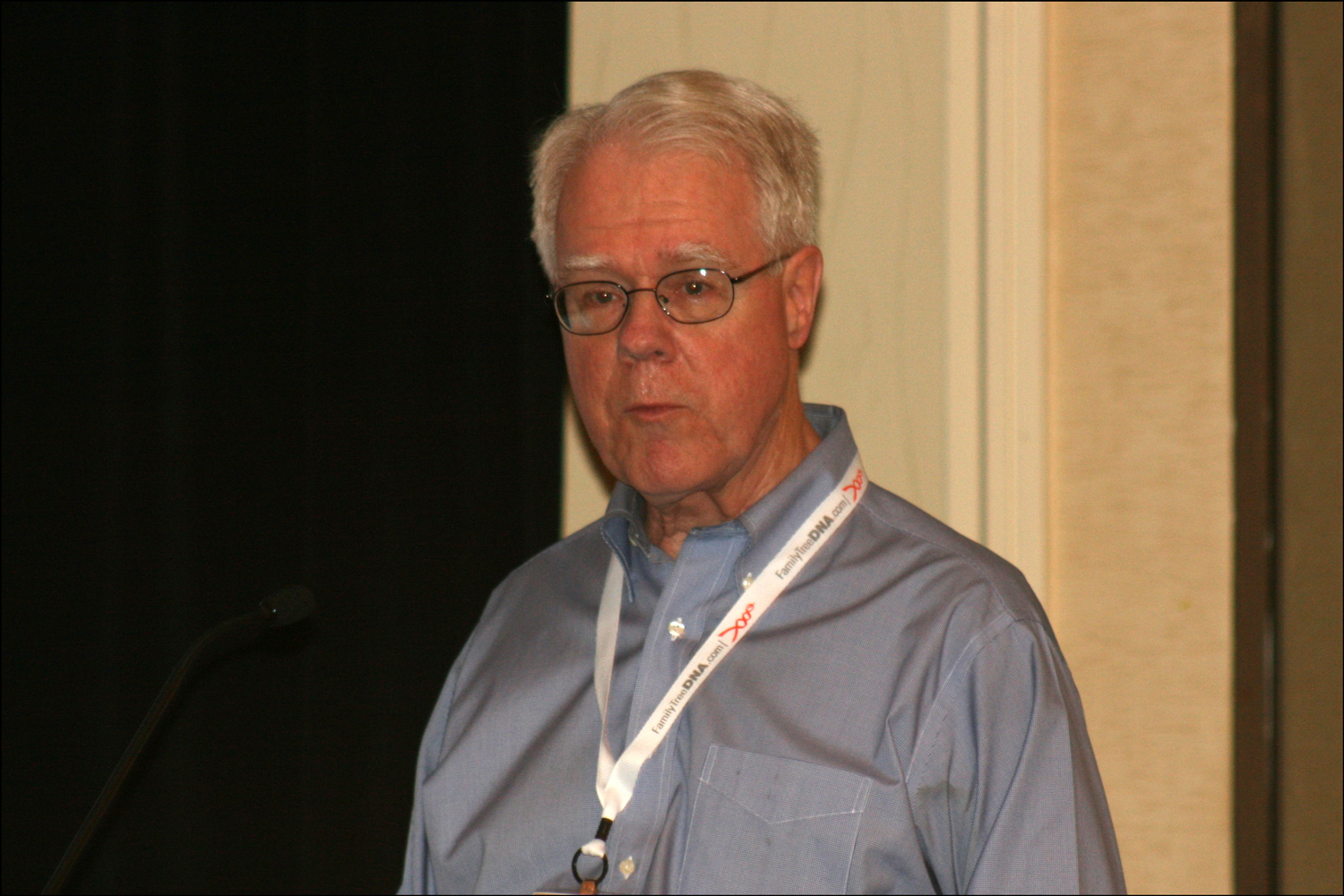
Peter Biggins speaking at the 2011 FTDNA Conference. Photo by Steve Danko. |
Peter Biggins, in collaboration with Thomas Roderick, made a presentation on the Clan Colla Project on November 6, 2011, at Family Tree DNA's 7th Annual International Conference on Genetic Genealogy in Houston, Texas. The presentation concluded with the following summary:
- The growing Clan Colla data is showing that the cluster is representative
of a unique stable population within the R-DF21+ population.
- The DNA picture that has emerged is consistent with the perceived
historical knowledge pertaining to Oriel in the early part of the first
millennium.
- The data also supports the view that Clan Colla originated in a Celtic tribe
in NW Britain before migrating to Oriel.
- Y-chromosome DNA has verified an ancient Irish pedigree for historians,
and genetic genealogists.
The presentation was created by Peter and Tom along with fellow Clan Colla project administrators, Josiah McGuire and Patrick McMahon. Patrick and Josiah could not make it to the Conference. So, only Peter and Tom attended. Tom was responsible for getting us on the program. He had attended the conferences every year since 2006. Tom somehow got Peter to make the actual presentation.
The presentation was based on a database of 259 men with Clan Colla DNA as of November 2011. See Summary Report, November 2011.
See slides. See also Steve's Genealogy Blog.
|

